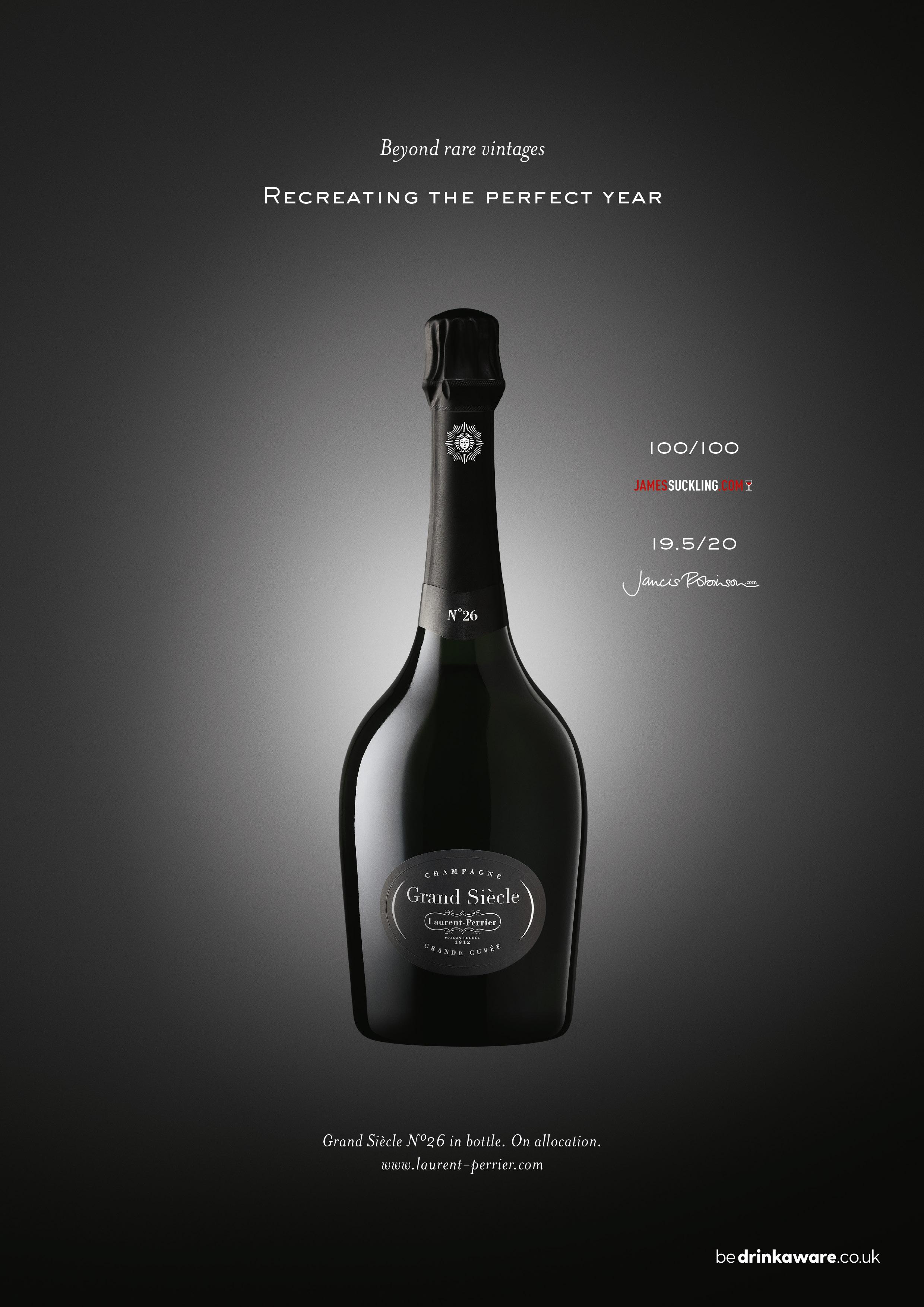THE WINE MERCHANT.
An
independent magazine for independent retailers Issue 141, November 2024


independent magazine for independent retailers Issue 141, November 2024

Heritage Wine Company would provide “a sympathetic home” for traditional merchants looking to sell up or retire
Anew business called The Heritage Wine Company is looking to expand by buying independent wine merchants.
The company has just acquired Winchester Wines, which owns The Secret Cellar – an indie based in Tunbridge Wells which has four sites in Kent, East Sussex and Surrey.
Heritage is owned by Australian MW Miles Corish – whose Milestone Wines business will now be incorporated within the new business – and Texan businessman Jim Ludwig, who has been based in the UK for almost two decades.
The deal also gives the company control of Milton Sandford Wines, an upscale import and wholesaling business.
“We sifted through 1,000 businesses in the UK to identify 18 that met our investment criteria,” says Ludwig. “We ended up completing on this one. We’re still looking for potentially more to add to the group.”
Ludwig says this search “absolutely” includes independent wine shops, though not in locations that compete with The Secret Cellar.
“That’s where the inspiration for the name Heritage Wine Company came from,” he says. “We both recognise that local independent retail shops across the country are part of the community, especially when you get into nice

4 comings & GOINGS
There’s no shortage of indies looking to open or expand
12 david perry
Brasso and dead wasps feature in the Shaftesbury Wines window
21 bright ideas
Could a tarot reader be on the cards for more wine retailers?
23 the burning question
What’s the male/female split in the customer base of independents?
26 wine auctions
Top tips on how to bid successfully, from our man in the know
28 merchant profile
How Shekleton Wines has thrived since its lockdown launch
42 sustainable wines
Separating the box-tickers and greenwashers from the trailblazers
68 wines under £15
Bottles that fly off the shelves in a cost-of-living crisis
83 Q&A: christine austin
The Yorkshire Post wine critic talks cakes, rowing and farmers
rural market towns. There’s always an independent wine merchant in these places.
“When they’re looking to transition, or wanting to retire and there’s not a family member to leave it to, or not a bigger structure, we would provide a sympathetic home. We’re all about respecting those traditional brands and the place they have within the community. We’d be trying to build on that and keep that spirit alive.”
Ludwig stresses that such ambitions are not for the immediate term. “I think we’ll be taking a bit of time to bed this one in first,” he says.
“We’re not trying to consolidate the three businesses. We’re trying to run them in a way that maintains the identities that they’ve always had. But we’ll try to optimise and to improve where they can co-ordinate and work together.”
The Secret Cellar will have the option to look at expansion plans within the new set-up, beyond its current locations of Tunbridge Wells, Wadhurst, Oxted and
Forest Row.
The sale of parent company Winchester Wines to The Heritage Wine Company means that the Employee Ownership Trust – created in 2022 to give the Secret Cellar team the chance to buy the business outright over a period of years – will now be disbanded.
Milestone Wines was founded by Corish in 2017 and operates primarily as an on-trade supplier in the north west of England, but also sells nationally to the off-trade.
“Geographically, it will be advantageous to have a southern foothold, and the expanded group’s combined expertise allows us to leverage our offering and enhance the value we provide to our customers and partners,” says Corish.
Ludwig adds: “Our strategy is focused on building a nationwide network of offtrade distribution along with strategicallylocated retail outlets. Combining Milestone with the acquisition of Winchester marks our first step in this ambitious plan.
“Acquisitions will play a crucial role in our growth, and we are eager to engage with small business owners who are seeking the right home for their family enterprises.”



Editor and Publisher: Graham Holter graham@winemerchantmag.com
Assistant Editor: Claire Harries claire@winemerchantmag.com
Reporter: Jacob Stokes jacob@winemerchantmag.com
Advertising: Sarah Hunnisett sarah@winemerchantmag.com
Accounts: Naomi Young naomi@winemerchantmag.com
Admin and reader liaison: Charlotte Gingell charlotte@winemerchantmag.com


This month will see the opening of The Trading Route in Manchester, a second store for Emma and Will Evans, the owners of Wandering Palate in Monton, a district of Salford.
Like Wandering Palate, The Trading Route will offer deli items alongside its wine range and, according to Will, it will retain the community feel that is so integral to the identity and success of the original site.
After almost four years of Wandering Palate, why start a separate brand? Will explains it’s all relevant to the location.
“It’s within a building called Manchester Goods Yard, opposite the old bonded warehouse,” he says. “It really was the centre of Victorian Manchester’s trading. We talked through a number of different aspects [when it came to naming]. Just as the Wandering Palate is the idea of us bringing back experiences that we’ve had when travelling, the Trading Route is the same sort of thing – bringing wines from across Europe back into Manchester.
“The bonded warehouse probably housed wine years ago and the street it’s on is called Grape Street. I am talking to people about doing a wine festival there. A wine festival on Grape Street? It writes itself.”


Unwined in Tooting is changing hands but the Waterloo site will remain under its current ownership.
It’s almost 10 years since Kiki Evans and Laura Ward took their London wine business from pop-up to permanent when they set up shop in Tooting Market. Unwined in Waterloo followed in 2018 and Evans and Ward continued to work across both sites, ably supported by a growing team of staff. Now Amy Caiger, a member of the team at Tooting, has taken on the lease and will rebrand in January.
He adds: “There’s a personal touch to everything at Wandering Palate. More so with Emma in the upstairs bar, but for me, because my day job is the Manchester Union Brewery, the personal touch stems from the social media aspect of it.
“I am mostly in the background talking to people about new stock and new listings that we’ve got coming through. With the new place I think I want to continue that but obviously take it to a different audience.
“I still wouldn’t say we’re a wine specialist, although most people would say we are. I would say it’s more about premium convenience. So, if you want something better than Tesco, people can just swing by and grab it.”
Published by West Berks Press
hello@windingwoodvineyard.co.uk
Tel: 07798 885050
Winding Wood Vineyard Hungerford, West Berks
Copies available singly or trade terms for shop sales
Our wines: WineGB Awards 2024, Trophy for Best Sparkling Rosé Independent English Wine Awards 2024, Trophy for Top Sparkling Wine
“Life goes on and things change,” says Evans. “Laura and I are no longer living near Tooting, so it’s been managed and run by the team for the last few years, and it just feels like the right time for the next generation to take it forward.
“We’re really happy that Amy will carry the torch, so to speak. It also means that we’ve got a bit more time to focus on Waterloo, so it’s a win-win scenario for everyone.”
• Beloved Edinburgh bottle shop The Bon Vivant’s Companion is being sold and will be transformed into a wine bar, subject to licensing consent. The premises in Thistle Street will be acquired by Du Vin Bouchers, which runs a successful wine bar in Linlithgow, West Lothian.
‘A joyful exploration, a cautionary tale, an instructional manual, and a heartfelt diary.’
Alex Taylor, Founder, Independent English Wine Awards
‘This book is at its best when you read it as a diary – chatty, informative, sometimes quite private, sometimes positively philosophical. And always honest.’ Oz Clarke OBE
‘Christopher writes with humour, insight and a keen sense of the dramatic about the difficulties of growing exceptional grapes in his small vineyard in Berkshire.’
Henry Jefferys, Wines in a Cold Climate


News that duty will, as feared, be calculated in accordance with Rishi Sunak’s batshit-crazy sliding scale from next February will hit everyone hard. Or will it?
One major UK agency business reports receiving an email from a well-known multiple, advising that any additional duty that affects its cost price next year will have to be absorbed by the supplier, not the retailer.
“Our response was, we do not negotiate on government taxes,” our supplier source tells us. “They can go and negotiate with the government if they want to. We’re not going to go back to all of our producers and ask them to cop a 45p discount because duty has gone up.”
The multiple in question hotly disputes that it’s refusing to accept duty increases. All eyes will be on its shelf tickets in the spring.
Big and friendly wines. Yes please! Who doesn’t love a big and friendly wine? Who could resist the offer, as the days grow shorter and the mercury dips, of a big and friendly wine being poured into their glass? But hang on a moment.
What exactly do we mean by a “big and friendly wine”? How can we quantify its bigness and friendliness? Is there some technical rationale?
Hoc Loco in Horsforth, north Leeds, is due to open shortly. While owner Emma Bond has been waiting on her licence to be granted by the council, she’s been busy transforming the premises with the help of her parents.
Bond grew up around the trade as her parents used to be publicans. “They’d take over failing pubs and then get them back up to scratch,” she explains.
“My mum is really creative; she’s a re-upholsterer, and my dad has proper handyman skills, so between us we’re very much have-a-go-and-do-it-yourself. They’ve been helping me with the shop fit.”
Having worked mainly with craft beer and small independent breweries, Bond says she felt it was time to move into the wine industry.
“We’ve got Once Upon a Vine on the other side of Horsforth,” she says. “I love that shop and Simon [Cocks] is incredible, he really knows his stuff. I do not claim to be nearly as amazing as Simon on the wine side of things, but I love to learn, and I feel like that sort of thing is missing from this end of Horsforth. It will be good to get people excited about wine in the same way I can get them excited about beer.”

Bond estimates that the space, a former vape shop, will accommodate seating for up to 30 guests. “I think through the week I’ll do a lot of retail and then over the weekend it will be quite a popular place to come and sit in, so I reckon [on-trade

versus retail] will be a fairly 50/50 split.”
Aside from wine, Hoc Loco will be selling plants and art from local artists.
“Horsforth is in love with its independent businesses,” Bond says. “I’ve lived here for years and it’s really nice to be a part of this friendly, uplifting community. People keep popping their head around the door for a chat when I’m painting, and the other day someone I’d never met turned up with a cake.
“She said, ‘I’m so excited for this to open and I keep walking past and seeing how busy you are, so I thought I’d do you some baking.’”
Licensing is still pending but a new wine shop, Bakkus, is planned for Lancing in West Sussex.
Siblings Victoria and Simon Tripp, who both have backgrounds in the drinks industry (Diageo and Morgenrot feature on their respective CVs) have secured a former hardware store, which they are in the process of refitting.
“I’ve always been spirits and wine and Simon has always been beer and wine,” says Victoria. “We’re both very passionate about drinks and we want to create something that’s community-driven.
This is the question put to a winery representative hosting a recent event for invited indies. The non-native English speaker was momentarily thrown by the question, until clarification emerged. What they had actually been talking about were vegan-friendly wines. Which, it has to be admitted, could have been big and friendly too.

“I lived and worked in London for 15 years and I found a really cool local coffee shop in Lancing that wouldn’t look out of place in south east London, and I could see that sort of clientele exists here.
“We’re going to have a long bar at the front, which will be a retail counter, and we’ll have a rotating beer on tap, wines by the glass and possibly a cocktail on tap too.”
There will be a designated area for hosting events as the pair intend to put together a calendar of ticketed tastings. The shop will have more than 100 wines available for retail. The space will be able to seat up to 30


October saw the opening of Kabinett Vinbar in Rugby. This is the first wine shop venture for husband-and-wife team Blaine Nissen and Sammie MayersNissen, but Blaine is not new to the trade, having worked at Armit for the past five years.
“I’ve kind of done a bit of everything in the industry,” says California-born Blaine. He worked as an assistant winemaker in California before moving to retail.
“I started out mostly on the natural wine side and shifted almost completely in the opposite direction when I worked with Armit and I wanted to kind of blend the two together.
“Kabinett is really focused on family: family domaines; family-run producers. We’re looking at smaller-production people who are focused on biodynamic and organic farming, people who are doing the right things in the vineyard and producing a compelling bottle of wine.”
While wines from the Armit portfolio account for some of the range, the couple say they are already working with around five other suppliers including Vine Trail and Indigo. “We currently have over 100 wines on the shelf and we will be expanding the range,” says Blaine.
With a background in art and design, Sammie appreciates the impact of some well-chosen illustrations and branding.
“All the signwriting and beautiful illustrations on the front of the shop are the work of a local artist based in Leamington,” she says. “Her work really stood out for me because we want to be a neighbourhood wine bar where people come in and enjoy themselves, regardless of how much they know about wine, and we want to make it approachable. We’ve retained a similar feel inside, using wood and natural materials. We’ve designed it to feel friendly.”

There hasn’t been an independent wine shop in the town since Gallachers closed in 2023 (Debbie and Russ Gallacher now operate online only, under the name Rugby Wines). So is Rugby ready for a new indie?
“Covid really took a toll on the town and there’s been a lot of closed businesses, but hopefully we can fill that hole,” Blaine says.
“I wish we could have captured a bit more of the summer, but we’ve had a lot of positive feedback from people. I don’t think I could have asked for a better space in Rugby, honestly.”
“It’s beautiful,” adds Sammie. “We’ve got big windows and we look out on to a really beautiful square where people sit on the benches and eat their lunch. There’s also an independent clothes store and an independent coffee shop nearby and so I feel we are in the right part of Rugby.”
Ake & Humphris has plans to open a new shop next spring. It will be a third premises for the business, which already has shops in Collingham and Harrogate.
The new site, also in Harrogate, is just over a 30-minute walk from the Leeds Road store and will operate as a hybrid from day one, a decision based on the success of recent experiments with onpremise sales.
“We were just taken aback by the popularity of our pop-up wine bars over the summer,” explains sales manager Paul Auty. “They were incredibly well received by the community. Just putting tables and chairs outside the store with some bunting proved to be a more effective marketing exercise than anything we could possibly have imagined.
“We were full all the time and it felt really social. We’ve got more people coming through the door purely because they noticed us. Transactions are up and in terms of getting the business where we’d like it to be, it’s been tremendously positive.”
Will this expansion trail continue, or is three the magic number?
“It’s absolutely about location for us,” says Auty. “We’ve looked at north Leeds before but the right site hasn’t come up. We’re very cautious because we don’t want to butt heads with other independents. We love our independent community in Yorkshire: Chris at Latitude in Leeds has a fantastic team and we were delighted for him with his new opening. There’s Wayward Wines nearby and Chez Vin in Otley, and Martinez with brilliant places in Ilkley and Bingley. We don’t want to be Majestic Wine; we don’t want to be spread too far and wide.
“We’re billing the new place more as a wine café than a wine bar,” Auty adds. “It’s somewhere you can go during the daytime to have a nice glass of wine before you go on to do something else.
“There are some very good bars in Harrogate, and we don’t need to be involved in that. We would much rather carve out our own little niche. We’re still going to close just after teatime, with a view that we’ll be able to do education and ticketed events in the evenings.”
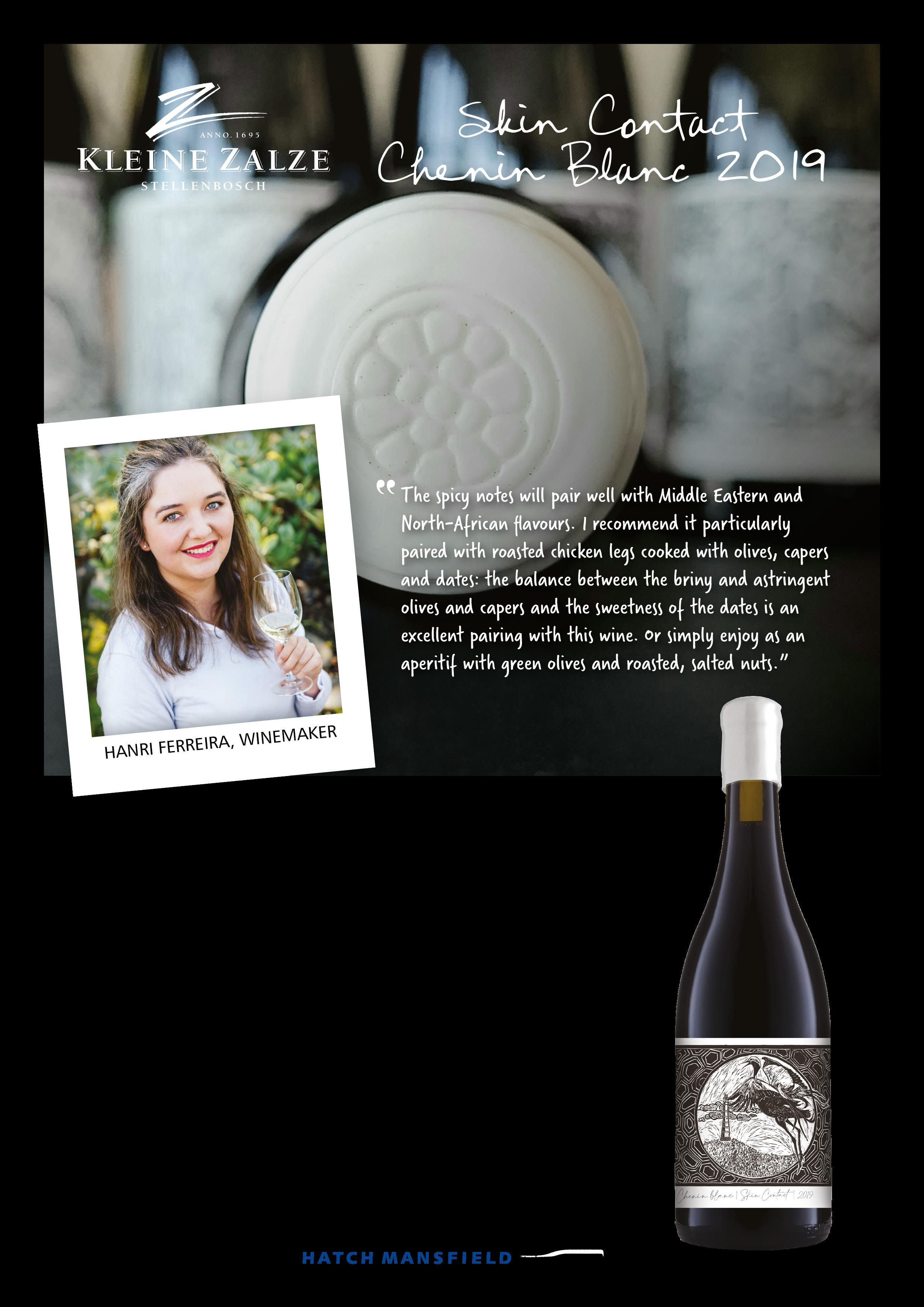

Sites such as MoneySavingExpert and BeCleverWithYourCash have sections devoted to all the latest wine deals in the (English) multiples. At the time of writing, there are £5.49 offers on Prosecco in Tesco and Aldi, and Champagne available to the budget-conscious for as low as £15. These promotions are just a fact of life, and probably don’t represent a major challenge to most independents – although the role they play in giving consumers a distorted impression of what a bottle of wine is worth is certainly an irritant.
The ubiquitous 25%-off deals are more problematic. Again, at the time of writing, Morrisons is offering 25% off six bottles, and it’s predicted that Sainsbury’s, Asda and Ocado are about to follow suit, closely followed by Waitrose.
Zoe Stabler, one of the team at BeCleverWithYourCash, says: “These offers run at all supermarkets, with others usually following suit whenever a supermarket launches theirs. You can often stack the 25%-off promotion with other offers, too. For example, if a bottle is normally £8 but reduced to £6 with a loyalty card, you can still get another 25% off to make it £4.50.” The site gives various tips on how to game the system in order to save even more than the supermarket is advertising.
The owner of one Surrey indie, who has not exactly been enjoying bumper sales this year, says: “Middle England is either waiting for supermarket promos or downgrading to Aldi. One scary stat I saw the other day was that in the last 52 weeks
there have only been six when neither a supermarket nor Majestic didn’t have a 25%-off sale on.” In a way it’s surprising the break is as long as that.
The Wine Merchant’s October visit to Navarra will be, barring a dramatic and very unseasonal intervention, our last buying trip of 2024. It was an enjoyable and enlightening four days, and a great way to round off what must have been our busiest-ever year for overseas activities.
There are dozens of reasons why these trips are important, all of which will be familiar to anyone who has spent working time in a wine region, even for a day or two. It doesn’t matter how many vineyards, barrel rooms or bottling lines you visit during the course of a career in wine; how many times you taste a still-fermenting tank sample or witness trailers heaving with ripe berries being dragged over a winery weighbridge. Each experience enriches us a little more and immerses us even further in our chosen profession.
One major advantage of visiting any region is the opportunity it gives you to
appreciate its wine in the most natural possible setting: with food. Wine isn’t really about furrowed brows and earnest discussions about yeast strains to the accompaniment of PowerPoint graphs. A leisurely meal at a restaurant, with a few open bottles of the local juice to hand, will always put wine in its best possible context.
This has repercussions for waistlines, especially when itineraries don’t include enough downtime for a morning run or evening swim, and I suspect all of us in the Navarra expedition group returned home rather heavier than we set out.
Next year, we’ll try to pluck up the courage to ask all our guests to weigh themselves before and after every Wine Merchant trip, and I suspect the collective surplus kilos will sometimes add up to the equivalent of a medium-sized child. We’ll make a commensurate donation to charity.
Jamie Mansfield, owner of Poco, a restaurant and bottle shop in Alfriston, East Sussex, recalls getting into trouble at primary school back in the 1980s. It was serious enough for his dad to get involved, and heated words were apparently exchanged between parent and headmaster.
Jamie’s offence, for which he was ejected from the dining hall, was daring to talk to his friends while the lunchtime meal was in progress. It was a stupid rule, but a pretty common one in the state education system at the time. School dinners had to be consumed in austere silence.
“If a bottle is £8 but reduced to £6 with a loyalty card, you can still get another 25% off to make it £4.50”
It turns out that I went to the same school as Jamie, where I too was punished for my failure to remain quiet during meals. Something or someone made me giggle and the next thing I knew, a patrolling teacher, always on the alert for exactly this kind of transgression, was bellowing at me from across the hall. I was ordered to stand up. My food went cold. I felt a burning combination of guilt, humiliation and, ultimately, hunger.
I went to Jamie’s wonderful restaurant one Friday night a few weeks ago. Everyone there was talking and laughing. I’m glad he’s made a career out of crime.


We only put wine in our window. Plus lemons, corks, stilettos and metal polish
We are on the shady side of the street, at least where the weather is concerned. Consequently we get about half an hour of sun directly on the window for a few days and only in high summer.
This means I can display loads of wine in the window without worrying too much that it will be spoiled. One or two have labels or capsules that are not photostable so, even in indirect sun, they fade. It doesn’t affect the wines. I know that because I have to drink them.
I don’t put spirits in the window anymore. I did once, but someone took a large coping stone off the church wall and hefted it through the window. They took a bottle of vodka and ran off. We lost a bottle of gin, too, but I suspect that was an opportunist noticing a large hole and helping themselves because they took time to rearrange the other bottles.
The Montrachet and vintage port was untouched but the insurance bill was still around £3,500. To replace the glass, from the inside, the whole window bed needed removing and replacing by a carpenter. He also made me some shelves for the shed out of the eye-wateringly expensive chipboard the police had ordered.
We don’t change the window as often as we should, other than leaning in and swapping the odd bottle. It is simply too difficult: it requires a set of steps
and two people, one of whom must be a contortionist. Despite that, we did have a complete change-around recently. Not because it was getting tired and cobwebby but because Mrs P wanted to put carpet in the conservatory at home.
I have two lemon trees which are my pride and joy. They live outside in the summer but as it starts to get a bit nippy
Someone took a large coping stone off the church wall and hefted it through the window

I like to bring them in. This year they had put on a growth spurt and were no longer allowed indoors. The obvious answer was the shop windows where they just about fit at either end. Anyone who has manhandled a heavy pot with a vigorous lemon tree into a small space will know that they have long, sharp thorns. Despite the blood, I was quite happy with the result. The only other casualty was one small branch containing a large, ripe lemon. When life gives you lemons, drink gin and tonic. So I did.
Both windows have a bed of hundreds of corks. Someone once asked where I got them all from. I must have looked a bit sheepish because they instantly realised.
Our window displays always feature Champagne and larger-sized bottles of, mainly, claret. In addition we have various wines we want to show off, sometimes with a regional theme. At one point we utilised the ceramic stiletto bottle holder which had been produced to promote Côtes du Rhône. An entitled lady burst into the shop and demanded that I show her different colour options in a size seven as she required some shoes for a wedding. If she had realised, being surrounded by wine, that she was in a wine shop and not a shoe shop, she evidently decided to brazen it out but eventually stormed out muttering, “well, you have one in the window!” We have dead wasps too, madam.
You would think that it is self-evident that a window display should show off what you are about. It is, after all, your “shop window”. It is surprising, then, that people have suggested I put all sorts of things in it other than wine. OK, and lemon trees.
From time to time someone in town decides we should have a window-dressing competition and it inevitably has to have a theme. On one occasion the theme was simply “Blue”. I tried to excuse myself. I explained to the organiser that I would struggle to fill two largish windows with blue stuff. For some reason very few wine labels are blue. She stomped around the shop and triumphantly pointed to a pack of low-calorie tonic water, “There!” she said.
“Why don’t you just put lots of that in the window?” I escorted her off the premises without the need to answer.
One Christmas the theme was “Victorian”. A friend’s artistic wife offered to do one of the windows as a set of A Christmas Carol with appropriate present tags for various characters. Her artistic endeavours were frustrated by my insistence that anything displayed should be stuff I wanted to sell and had in stock. We got there in the end, with a few compromises. Tiny Tim was to receive a double magnum of claret whether he liked it or not. Scrooge was a bit more difficult. The ghosts’ gifts were probably inappropriate and my stated policy of not having spirits in the window went unappreciated.

It looked quite professional eventually and included Victorian-style window panes fashioned from black tape. It was only in January that I realised permanent tape had been used, so it remained a feature for another 18 months.
We often have “spot the odd one out” competitions too. The idea is that people will go around studiously looking in every window – but the people who enter into the spirit are generally still in primary education. Occasionally a sniffy organiser will exclude me for that reason. I point out that they are usually accompanied by an adult.
My entry is normally a tin of Brasso amongst the wine bottles and appropriate props. It’s surprising how many people don’t notice. One young girl once proudly announced she had spotted the odd one out. “It must be that ear trumpet!” she told her mum. I had to rush out and correct her. “I think you will find that is a Georgian silver decanting funnel.”

The Wine Merchant is partnering with the London Wine Fair for its 2025 Wine Buyers Awards, the sixth edition.
Since they launched in 2020, the Wine Buyers Awards have celebrated excellence in wine buying across all sectors and recognise the UK’s best professional wine buyers, acknowledging the influence they have on creating trends and offering value, quality and innovation across their ranges.
The Wine Merchant will sponsor two categories: Large Independent Merchant Wine Buyer (indies with a maximum of six venues); and Small Independent Merchant Wine Buyer (single venue). Last year the awards were won by Carlos Santos of Humble Grape and James Goodhart of Bon Coeur Fine Wines, who also won Overall Wine Buyer of the Year.
The judging panel includes: Angela Mount, wine consultant and former head of wine buying for Somerfield; Helen McGinn, drinks writer and presenter and former wine buyer for Tesco; Ronan Sayburn MS, CEO for Court of Master Sommeliers Europe; and Hal Wilson, co-founder of Cambridge Wine Merchants.
The Wine Buyers Awards is launching an exciting new Sustainable Buyer category. To reflect how environmental impact is a vital consideration and responsibility across all professional wine buying areas, this award will be open to all entrants – with dedicated questions embedded into the existing entry forms for each category.
The answers to these questions will influence an entrants’ opportunity to pick up the award for their own category, plus their chance to be named Sustainable Wine Buyer of the Year. The judges look forward to discovering how the UK’s best professional wine buyers are helping to shape, protect and futureproof the industry we all love, through their buying decisions.
The other categories are: Supermarket & Multiple Wine Buyer; Best Off-trade Buying team and Best On-trade Buying Team; Ontrade Wine Buyer (single venue); On-trade Buyer (multiple venues); Online Specialist Wine Buyer; Rising Star Wine Buyer; and the Overall Wine Buyer of the Year.
Nominations are now open at winebuyersawards.com and the deadline for entries is January 10, 2025. The shortlist will be announced at the London Wine Fair launch party on February 25, and the winners will be announced on centre stage at the London Wine Fair on Tuesday, May 20.
The London Wine Fair takes place at Olympia from May 19-21.
David Perry is the owner of Shaftesbury Wines in Dorset
Nine years of lees ageing has imparted the sort of depth and nuance that perhaps we’re only just beginning to associate with the best English sparkling wines. This Berkshire blend of Chardonnay, Pinot Noir and Pinot Meunier also has a trademark component of Pinot Gris, and the result is a sensory thrill.
RRP: £65 ABV: 12%
All Angels (01635 896220) allangels.com
Delibo partnered with Château La Tuilerie du Puy to rebrand this unoaked Carménère under the Bastion de Camerac banner. It comes from a family estate in Entre-Deux-Mers and it’s a delight, with some crunchy red-apple freshness mingling with dark fruits and black jacks. Bordeaux, but with a twist.
RRP: £14.95 ABV: 12%
Delibo Wine Agencies (01993 886644)
delibo.co.uk
Not as austere and demanding as some Etna wines, this is a generous, forthcoming style with bright red berry fruit, crushed spices and a whiff of burnt earth. Vibrant and lively with exploding flavours and an assured but approachable structure. You can just imagine it working beautifully with pasta alla norma.
RRP: £20 ABV: 13%
Boutinot (0161 908 1300) boutinot.com
A tightly-coiled bundle of energy. All the pepper, crunch and chew of the best northern Rhône Syrah, and just as serious and as worthy of your attention, but at half the price. Haunting, with smoke-tainted violets, stone-ground black peppercorns, fresh blueberries growing wild in the fynbos … just beautiful.
RRP: £30 ABV: 13.5%
Dreyfus Ashby (01636 858774) dreyfus-ashby.co.uk




Fontodi is Tuscan royalty: its top offering, Flaccianello della Pieve, retails for triple figures. But what better way to judge it than on its entry-level wine? The nose is a little darker than typical sour-cherry Sangiovese fruit; this feels ripe and seductive. Luscious black cherries, spiced plum, dried tomato leaf and sweet cedar. A benchmark for modern Chianti Classico.
RRP: £33.99 ABV: 14.5%
Liberty Wines (020 7720 5350)
libertywine.co.uk
The Gianolli family’s “slow living, fast thinking” philosophy resonates in this silky wine made from late-ripening fruit, which has developed complex aromas along with mouth-watering cherry fruit, a hint of spice and a mineral kick. Thanks to some fast thinking, it made good friends with a hearty lasagne.
RRP: £38 ABV: 13.5%
Hallgarten & Novum Wines (01582 722538)
hnwines.co.uk
A blend of 60% Chardonnay and 40% Viognier made in a pure, unoaked style. Mathieu Marlet only harvests at night, achieving a fresh concentration of clean citrus and squishy stone fruit and just a flicker of minerality on the finish. Punching way above its price point and already a hit in top London restaurants.
RRP: £15.50 ABV: 13%
Top Selection (0845 410 3255) topselection.co.uk
“Oh that’s rather nice,” declared our one-person focus group, before ruining the fun by spotting the words “non-alcoholic” on the label. The plan was to do a big reveal when the bottle was empty. You wouldn’t confuse this with most £20 fizz, but it’s so cleverly made – including secondary fermentation – that it actually tastes like wine, rather than fizzy grape juice.
RRP: £19.99 ABV: 0%
Bolle Drinks bolledrinks.com




Wine Paris is increasingly popular with independent merchants in the UK. Being based in such an accessible, and beautiful, city is certainly part of its appeal. But organiser Vinexposium has been working hard to make the show an essential date in the global wine trade diary, as CEO Rodolphe Lameyse explains
How will Wine Paris compare in size to 2024?
Wine Paris is expanding from 4,074 exhibitors in 2024 to over 4,600 in 2025, including more than 300 in Be Spirits, the dedicated spirits area.
France will showcase all its major wine regions across the three levels of Hall 7, while Italy, for the first time, will have its own dedicated hall, featuring over 30 regional pavilions. Austria, China, Germany, Greece, Spain, Portugal, and Romania are all significantly increasing their presence for 2025. We are also welcoming new international pavilions, including Wine Australia, Wines of South Africa, Uruguay Wines, Wines of Chile, and New York Wines. Producers from new countries such as Armenia and Hungary will be joining us for the first time. With its dedicated hall, Be Spirits is becoming increasingly international, with 130 producers of spirits, beers, ciders, and no/low products from 23 countries.
Are you seeing more UK visitors?
British buyers have always supported the
show for a number of reasons, the most obvious being that it is incredibly easy to get to Paris from London.
The year 2024 marked a turning point for Wine Paris. Visitor attendance increased by 14% on the previous exhibition to 41,253 and included 41% international visitors from 137 countries. The top five nations represented after France were Italy, Belgium, the UK, the US and Germany.
What advice would you give to a UK independent merchant looking to visit
Wine Paris for the first time?
Plan ahead! There is no way you can visit every single stand even if you stay for three days. Once you’ve registered, fill in your interests on your personal profile three to four weeks before the event. Look for producers you are interested in in the online catalogue. Also three to four weeks before the event, send your requests for appointments to exhibitors.
Once you’ve taken care of business, do not forget to browse the detailed programme of events, and add your

selection to your diary. Don’t forget to plan your evenings as well: the OFF by Wine Paris presents 200 venues from restaurants, wine bars and wine merchants-cum-eateries to cocktail bars.
Some shows are focused on networking, education and sociability; others are very focused on business. Where does Wine Paris fit into the spectrum?
Wine Paris offers a unique trade experience that is highly focused on business while cultivating a certain “je-ne-sais-quoi” that sets it apart for both producers and visitors. The event embodies inclusivity, with a vast range of products and industry players represented –from boutique winegrowers to major international brands. This diversity is at the heart of the event, creating a seamless and business-oriented experience where producers and visitors connect, engage in meaningful conversations, and develop their business relationships. The event’s content is unmatched, offering a rich array of tastings, round tables and conferences.
For visitors who don’t speak French, is the show easy to navigate and explore?
Very easy! All the signs are in English, and all the hostesses are bilingual. Some events are in English and, for most of those that aren’t, a service of simultaneous translation is available.
Wine Paris takes place from February 10-12, 2025 at Porte de Versailles
at wineparis.com

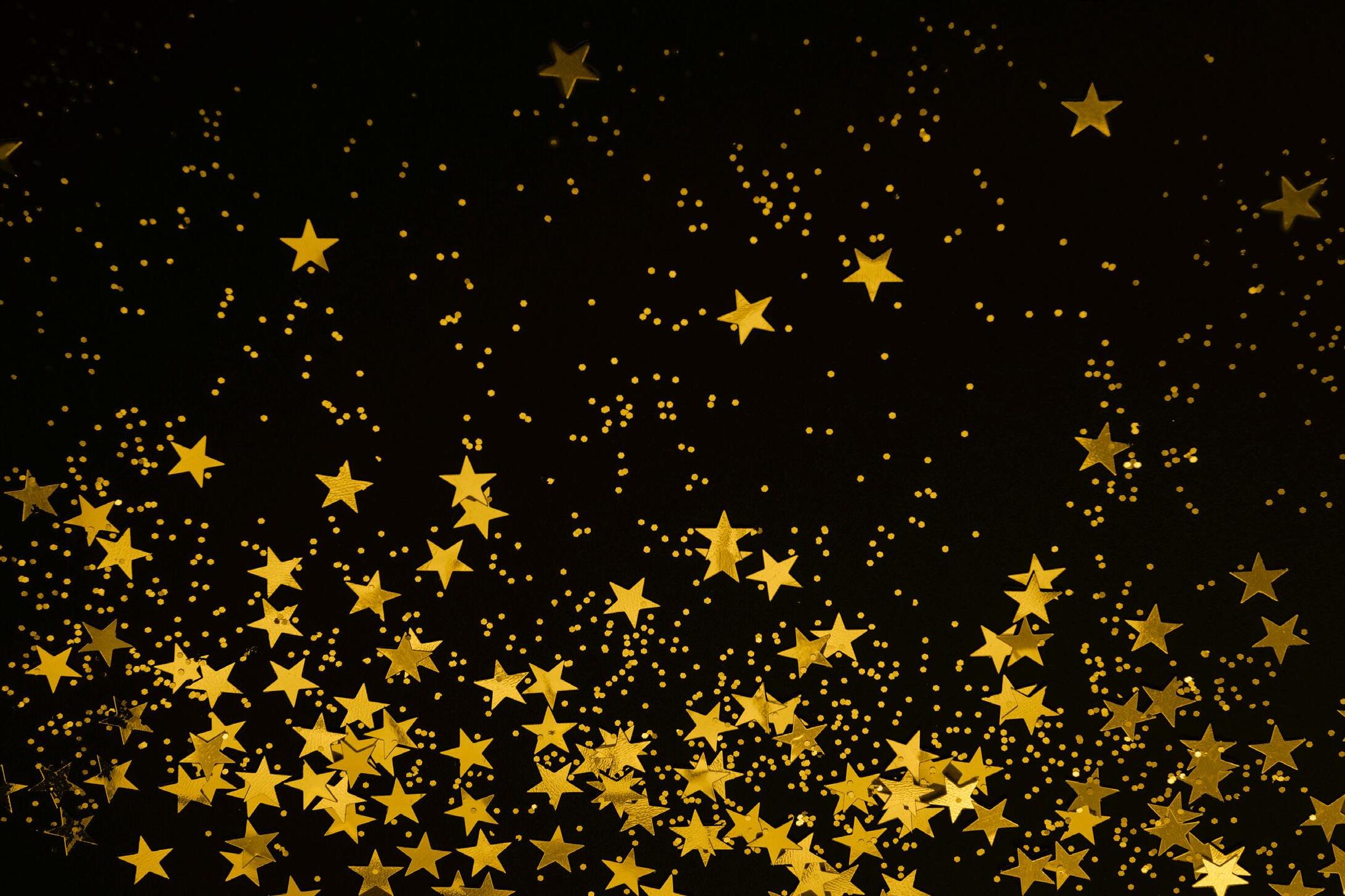
Nathan Morgan’s career began in the music industry, but after working a harvest while living in France with friends, wine became his focus.
On moving back to the UK, he put feelers out for a wine-related job and began working as a driver for Peckham Cellars. Fast forward four years and he’s the general manager at the company’s Camberwell site, The Cellar Next Door.
Ben McVeigh-Whitaker, co-founder of Peckham Cellars, says: “Nathan joined us during the pandemic when we were still doing our own deliveries. He’s just worked his way up from there. It has been a bit of a pattern for us with people progressing through, and that has been really good for business as a whole, and maybe it’s the reason we’ve always had a great team.
“What I love about Nathan is his positivity. He never complains, he’s always happy to be at work spreading positive vibes. He is full of ideas and lots of energy. He leads on all the events and community engagement. He’s an absolute pleasure to work with.”
Straight out of university, Nathan was interning at a booking agency. “The guy who ran it had a record label on the side,” he says, “and I ended up running that for a couple of years, but it got to a point where I wasn’t getting what I wanted out of my career. So when a friend invited me to live in France, I ended up making a life for myself out there. We did a harvest at Domaine Pion in Félines-Minervois and I began researching different wineries and just learning more about the basics of wine.”
Nathan’s wine education continued on a more formal footing, courtesy of Peckham Cellars. “They’ve been super-supportive in helping me learn and I’ve done my WSET Level 3,” he says. “I think they could see that I was super enthusiastic to learn, so as I’ve worked my way up the ladder, we’ve enjoyed the journey together. I started out tootling around south London delivering cases of wine to our local customers and so I began to get a real insight into our range of wines.
“When our restaurant re-opened I moved onto the bar for a couple of years, then worked under Conor [Strutt] helping with operations for the restaurant. When we opened Little Cellars, I moved over to manage that. I’m really happy where I am, because I can see career progression and I really enjoy the community that we

have here in Camberwell – that is really important to me.”
Nathan also runs a side-hustle with his friends Conor and Albert (a chef), which he says combines all their talents. “Wine tastings, supper clubs, parties, and we do corporate stuff. It’s kind of a catch-all for our interests in the wine, food and music world.
“Wine is really having a moment in terms of how popular it is with the 25-40 age bracket,” he says. “People are willing to spend their money on unique experiences that involve food and wine and I think that applies more to pop-ups than going out to restaurants. It’s almost like the sporadic nature, or time limit on certain events, means that people are really keen to just go and experience it.”
Nathan wins a bottle of Jean-Luc Colombo Terres Brulées Cornas Syrah
If you’d like to nominate a Rising Star, email claire@winemerchantmag.com


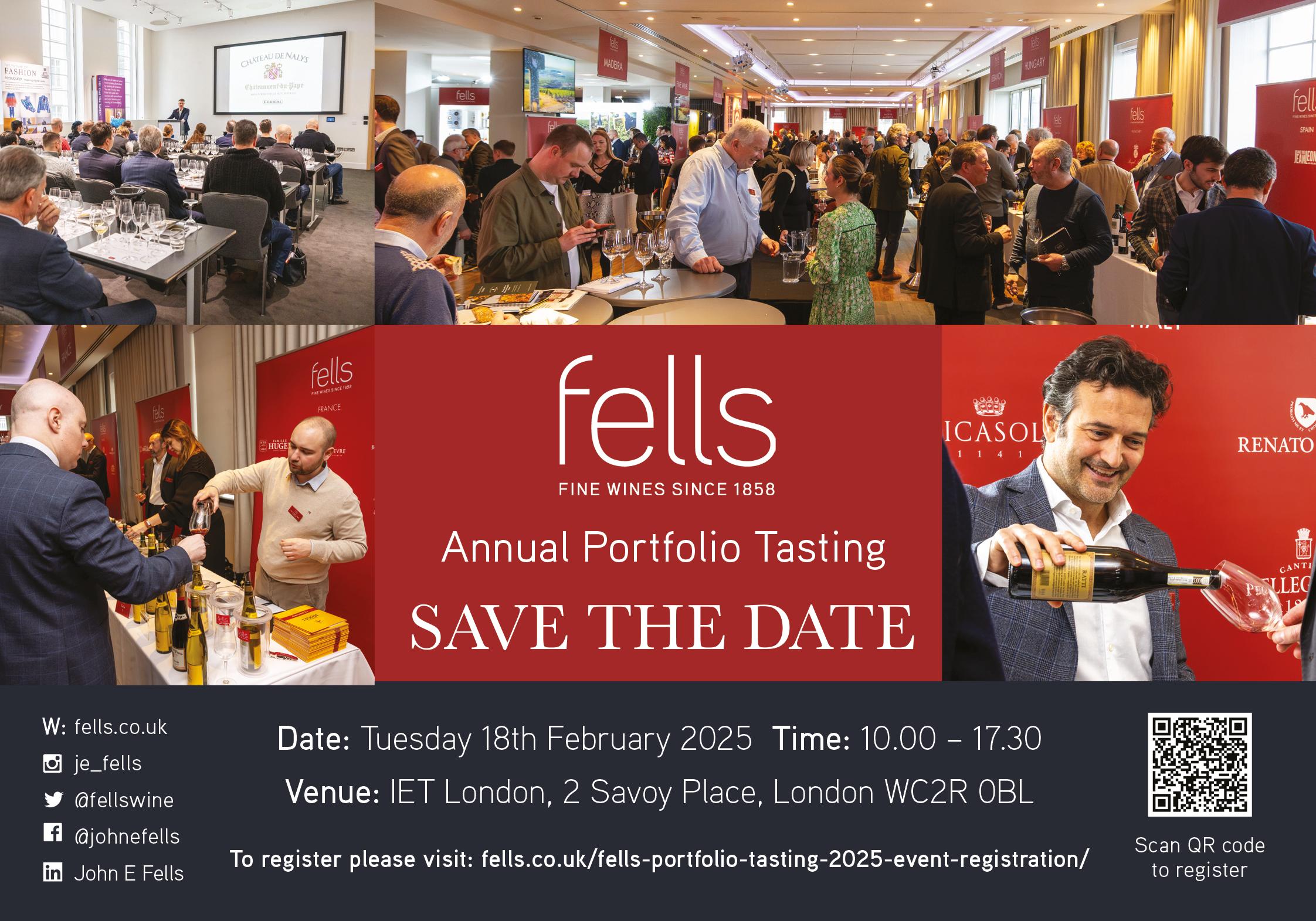

These are frightening times for Lebanese winemakers. At a moment when their thoughts should be focused entirely on the 2024 vintage, the prospect of being hit by Israeli bombardments is the number one concern.
“We are no longer able to reach our Cap Est vineyards located in the north eastern part of the Bekaa,” says Sami Ghosn, winemaker at Massaya, which he owns with his brother Ramzi.
“During harvest, we were constantly scanning the sky, not to predict the weather, but to look out for drones. At times we didn’t know if we would be able to go to the vineyards.”
Many of Lebanon’s vineyards are in areas adjacent to towns being targeted in Israeli strikes. At Domaine des Tourelles, the team was close enough to one bombardment to take a picture of the explosion from the winery. Chateau Rayak, an artisanal winery popular with tourists, has reportedly been put out of action by bombing.
The reality for wine producers is that life, and work, must go on.
George Sara, co-owner of Chateau Ksara, sums up the mood. “Talking about selling wine when people are dying might sound harsh, but this is the only way we can fight this terrible aggression,” he says. “We have to keep going.”
Sara has moved his family to France for the time being, but he and his 130 employees remain.
Lebanon’s 2024 vintage will be remembered for all the wrong reasons because of Israeli bombing that has disrupted the lives of winemakers and their teams.
Graham Holter talks to four Lebanese producers who say they have no choice but to show resilience, despite the ongoing bombardments

George Sara, Chateau Ksara
“It’s yet another very tragic time for the region and the country but we have been here before, most recently in 2006 when we last had conflict with Israel,” he says. “We can adapt. I tell everyone that as long as the roads, airport and port are open we can continue to do business.
“Our winery is nearly 170 years old and we have lived through war, famine, social upheaval and political instability. During the 1975-90 civil conflict our staff faced kidnapping every time they drove to work; the winery was occupied by armed militias and our French winemaker had to give instructions over the phone from France.
“We live with war, conflict and instability. We factor all these into our business model and our mental state. We are very good at problem-solving.
“There have been air attacks in the area around the winery so we are very cautious about venturing into the vineyards. But thankfully the harvest is completed and the juice is in the tanks. This has made life easier.”
Berkmann Wine Cellars, Ksara’s UK importer, has been “amazingly supportive and understanding during this extremely difficult period,” Sara says.
“There is so much more to Lebanon than sadness, instability and war. Wine is a great vehicle for promoting positivity.
“I was in London recently promoting the wine and our country, and our message of civilisation, history and tradition. Not to do so would be to surrender to this terrible situation. We have 130 mouths to feed.”
Domaine des Tourelles
“Everyone is under a lot of stress”
Co-owner and winemaker Faouzi Issa says that “physically, everyone is fine” but “morale is low”.
He adds: “Everyone is under a lot of stress with the fear of what will happen, worrying whether their families are safe, worrying about their kids. Everyone is on edge as no one knows where the next hit will be.
“We are more conservative and not

taking any risks: for example, not sending teams to work in vineyards that are away from the winery,” he says.
“The domestic market has been severely impacted in the most important sales period of the year, which is a worry for us. We are focusing more and more on exports to make up the shortfall.
“Thankfully shipping has not been impacted and the port is still operational. However the cost is higher because insurance has increased. Export is running OK, in fact even better than normal because of the support of all our beloved partners around the world, who want to support us and fill the void left by the drop in domestic sales.
“They have been amazing and have been running tastings in store and on Zoom to help drive sales for us.” (UK importer Boutinot co-ordinated one such tasting for indies on October 30, and is hoping to organise more.)
“We are so grateful for all this support as it is no exaggeration to say that it is our lifeline at the moment,” says Issa. “Many families depend on Domaine des Tourelles for their livelihoods and we are determined to keep our business strong to support them. Everything our partners, sales teams and customers are doing to support Lebanese wine will make a difference.”
Domestic sales down by 75%
“Our team is fine to date,” reports Musar managing director Gaston Hochar. “The winery is in a region less subject to shelling, and our offices in Beirut are also in an area not bombed yet. Our vineyards in the Bekaa are also in villages which have not been impacted to date.
“The 2024 harvest started early due to the early ripening of the grapes, and we were lucky to finish the harvest of our Bekaa vineyards mid-September, before the outbreak increased.
“The attacks have greatly affected the local sales of wine and arrack, with drops in sales of over 75%. There are no more
tourists; no more visitors at the winery.
“Normal trade is continuing on a much smaller scale in the areas which are not under attack. Supply chains are functioning at the moment, as the airport and the port are open. However, ministries and public services which were located in the attacked areas have been relocated, with a downgrade in service. For example, issuing shipping documents and certifying them would normally take three to five days and it now takes two to three weeks.
“Other wineries have had much bigger issues to deal with.”
Stocks safe in France
“Thankfully, the Massaya family is OK,” says Sami Ghosn. “We were able to salvage the wine harvest that came in somewhat early, but we were unable to fully harvest the Obeidi grapes.
“This has been a promising, if at times frustrating, harvest but we have had exceptional conditions, unfailing solidarity and a magnificent setting even if we were racing against the threat of man-made aggression. We remain hopeful.
“We are used to working with geopolitical tension and our trusted colleagues keep us up to date with the latest security developments.
“We have taken precautions by transferring as much stock as we can to our Vieux Télégraphe partner’s warehousing in Châteauneuf-du-Pape in order to ease the logistics issues to the best of our abilities.”
UK importer Thorman Hunt is donating 5% of Massaya sales revenue to the Lebanese Red Cross until Christmas.



customers we could do without
Actually there is one more thing I’d like to ask if that’s OK … sorry, I hope this isn’t really annoying, you did say there was no such thing as a silly question, hahaha … is it true that the louder the pop of the cork, the better the Champagne? Obviously that’s really subjective but, like, if the cork can reach my garden fence when I open the bottle does that mean it’s got more Pinot Noir in it and so it will be more alcoholic? I guess it will depend on the exact size of the garden but what I’m trying to say is, if the cork kind of bursts out on its own, even without me applying any force, I’m assuming it has more bubbles than a cheap bottle and that’s probably because it’s vintage rather than non-vintage and will taste much fruitier? Obviously it’ll vary depending on whether it’s a magnum or a standard bottle but would it be fair to say that if the cork is capable of bringing down a chaffinch and setting off my neighbour’s car alarm, really that’s a Champagne I would be better off squirreling away in the wine rack in the greenhouse rather than drinking immediately? Sorry, you must get asked this all the time …

1. Which German wine brand, launched in 1923, was selling more than 2m cases worldwide by the mid 80s?
2. In 2022, Tempranillo became Spain’s most widelyplanted wine grape. Which variety did it overtake?
3. How many months must Crémant spend ageing in bottle before release, as a minimum? (a) 12 (b) 18 (c) 24 (d) 30
4. What needs to happen to port tongs before they can be used to open a bottle of port?
5. Which French wine region is shown in this photo?
Answers on page 25


In a nutshell: Go into the mystic with a friendly tarot reader. All that’s required is a small, cupboard-sized space, wine by the glass, an open mind, and your future looks rosy.
Tell us more.
“A local psychic called Alex approached us at the beginning of the year and suggested he spend a day doing readings in the shop. I was a bit sceptical, to be honest. I didn’t think it would be very popular but I thought we’d give it a go, and the one we’ve got coming up next week will be the third one we’ve done.
“It’s always oversubscribed. Alex starts the readings at midday and works through until 10pm, with two 15-minute breaks. I don’t know how he does it – you can hear him working and it’s not half-hearted, it’s a real performance. Each appointment is 30 minutes long and costs £30, which includes a glass of wine.”
Does it bring new people through the door?
“Absolutely. It has brought customers to us that have never been to our place before. It tends to be mostly women, but some men as well. Often they come with their friends and take it in turns to have a reading. Sometimes they stay and have some wine or food afterwards, or just have a look around the shop. That’s the pay-off because we only get £5 from each booking, and that covers the glass of wine, but equally we

Brigitte

don’t need to do anything other than pour a glass of wine. It’s very low effort on our part.”
Do you have to set up anything special?
“No. We are quite limited for space inside the shop. Last time he was here we just put a curtain up over an alcove so it was almost like a fairground attraction.
“We offer a choice of Pinot Noir, Pinot Grigio and an orange wine. They are three of our best-selling more entry-level wines from Romania. They’re very easy-drinking popular wines, offering really good value for money.”
It’s very different from your usual events.
“I was a little bit reluctant before we did the first one because I worried that it might
be a bit controversial and didn’t want to associate ourselves with something that might upset people. But I’ve been surprised by the number of our regular customers who have been really up for it and the range of people who have come through our doors as a result. It hasn’t been at all controversial. Even a member of our staff is desperate to have her reading done this time. I’ve been taken aback by its success.”
Are you a believer in the cards?
“Not really, and I’ve not had a reading, but I’m impressed because people have come out and been kind of shocked at how accurate his readings are. People can get quite emotional. You’d imagine that someone would be Googling all their clients in advance and checking out their Facebook pages, but he doesn’t know who he’ll be seeing because we take the bookings – and he doesn’t access the booking sheet.”

Alex works from noon until 10pm
Kat wins a WBC gift box containing some premium drinks and a box of chocolates.
Tell us about a bright idea that’s worked for you and you too could win a prize.
Email claire@winemerchantmag.com

John Chapman
The Oxford Wine Company
Favourite wine on my list
Currently El Paisano de Tares from Dominio de Tares. A youthful, fun expression of Mencia from Bierzo. As we draw into the cooler part of the year, I am drawn to Lustau’s Oloroso Emperatriz Eugenia. Who doesn’t like a sherry by the fire?
Favourite wine and food match
Can I say sherry with anything? No? OK then, it would have to be pork pie and Bourgogne Blanc René LequinColin 2020.
Favourite wine trip
It has to be to Georgia. The culture of the people just oozed out of every wine we tried and reflected a friendly and passionate mix also reflected in their food. There is so much more to learn, taste and sell from this pocket on the far side of the Black Sea.
Favourite wine trade person
I would have to say Sarah Abbott MW, as she combines the best of infectious enthusiasm, great depths of knowledge and a grounded approach to all vinous matters resulting in a connection to the real world, which, to be honest, is lacking in some parts of our industry.
Favourite wine shop
Theatre of Wine. I love the way that conventional choices and styles are thrown out of the window in favour of a totally different approach to range and selling techniques.
After over a decade of snapping up Bordeaux wine estates, buying into a dream of elegant living in France and good earnings in their home market, many Chinese investors are selling up.
Li Lijuan, an estate agent and Asian market specialist at Vineyards-Bordeaux, said Beijing’s decision to impose strict controls on capital had dealt a blow to a market already undermined by an overproduction of Bordeaux wine.
“Chinese people can’t invest abroad anymore because their money is stuck in China,” said Li. About 50 Bordeaux châteaux are currently up for sale, she said. The Business Times, October 26

A thawing of relations between Beijing and Canberra saw the value of Australia’s bottled wine exports to China climb rapidly in the first nine months of this year – bouncing back from near extinction in January, when import volumes totalled just one litre.
The value of China’s imports of Australian bottled wine last month was 2,952 times more than in September last year, before the removal of punitive tariffs, with volume totalling 3.5 million litres, according to the latest customs data. South China Morning Post, October 28

The government’s decision to raise alcohol duty by RPI has been described as “counterproductive” and “a real kick in the teeth” by the wine and spirit sector, following punishing duty increases last year which saw alcohol hit with the largest tax rise in almost 50 years.
Raising alcohol duty and ending the wine duty easement will not bring in more revenue, but it will mean businesses will now be obliged to tussle with more costly and complicated red tape. When the easement ends in February, the single amount of duty paid on wines between 11.5-14.5% abv – £2.67 a bottle – will be replaced with a sliding scale according to strength. Wine at 14.5% abv will see duty increase from £2.67 to £3.09.
Wine & Spirit Trade Assoc, October 30
The Australian competition authority has approved the acquisition of Pernod Ricard’s wine business by Australian Wine Holdco Limited (AWL), the new owner of Accolade Wines, paving the way for the combined global business.
AWL, a London-based consortium of international institutional investors led by the Bain group, rescued Accolade in February from “a mountain of debt”.
The sale, announced in July, includes Jacob’s Creek, Brancott Estate and Campo Viejo.
The Drinks Business, October 25
Highly organised shoplifting gangs targeting major UK stores are “recruiting” criminals to steal, providing them with shopping lists and paying a daily rate for their time. Others are offered housing and promised a “better life” working for the gang.
One such operation, dubbed the Champagne Gang, has looted at least £73,000 worth across the UK.
It’s thought the Romanian gang, which took advantage of the post-Covid Champagne shortage, drove the goods back to Europe to be sold in eastern European countries.
Birmingham Mail, October 27

Find it at Fenwick, Newcastle
Food fans can now enjoy a beloved sausage roll alongside a glass of fizz as the very first Greggs Champagne bar has opened its doors.
An area near the entrance of the Fenwick department store food hall in Newcastle has been transformed into a dazzling, luxury bar where you can enjoy top-quality fizz from Perrier-Jouët to Bollinger or Cristal and get Greggs pastries served on a plate with a twist.
The bar, which is said to be the first of its kind in the world, will be available to enjoy until New Year’s Eve
The Mirror, October 27



�I would say the male/female split for retail sales would be 65/35 or 70/30 but with males dominating more in whisky, ladies more for gins. These figures have evened out somewhat over the years. For example, more males are buying gins than before and more women buying beer. We have a connected coffee shop with wines by the glass. These on-trade wine sales would have the ladies in the lead.”
Niall Keddie Abbey Fine Wines, Melrose
�Like our team, I’d estimate our customer split is pretty much 50/50 male/female. I would say that this has changed over the last few years from having more male customers historically. I think this reflects both our new, more approachable shop and customers being confident to come in knowing that they will receive helpful and friendly advice, no matter what their knowledge or preferences – and the fact that the wider industry has changed and become more balanced in general.”
Alex Edwards York Wines, Sheriff Hutton




�We haven’t noticed a change since we opened our wine bar and bistro, but the demographic is very different from our wine shop. The wine bar is made up of a fairly even split between males and females who are curious and educated but with a limited wine knowledge. Those visiting the shop are mainly males coming in to buy for themselves and our female customers are less frequent and mainly looking for a gift.”
Fabien Voisin
Tell Me Wine, Chepstow
�I would say that there is an even split between males and females buying from us. This wasn’t always the case, and I would put it down to an increase in confidence within the female population when it comes to knowing about wine. There is no longer a preconception of who should be the domestic engineer of the household, which means a good balanced approach. Female customers also tend to be more engaged when it comes to finding out about the wines, which is good for the whole buying experience on both sides.”
Pat Blake H Champagne winner H Blakes Fine Wines, Enniskillen
Gosset
The oldest wine house in Champagne: Äy 1584


I still don’t feel like a wine expert. But I’m happy to judge a local Côte-Rusty
We’re all painfully aware that we’ll never know everything about wine. There’s too much churn and change, too many appellations reborn and remarketed, too many young winemakers out to impress us with their innovations. And of course there’s everfascinating, ever-flummoxing vintage variation. And bottle variation. And a whole lot of other variations and complications. We’ll never know it all. But that doesn’t stop customers thinking we do. It’s a relative measure: I know more than them, so I must be an “expert”. And there is some justification. When new staff start, they always tell me bashfully that they know nothing about wine. “See these shelves?” I reply. “Red wine. See those shelves? White. Down there’s rosé, and up there’s fizz. Now you know more about wine than 90% of our customers.”
After 25 years in the business, I suppose I know more than 99.9% of our customers, but I’m still conscious of everything I don’t know, every wine I haven’t tasted. I don’t feel like an expert.
But the good folk of Orkney think I am, so food and drink producers, or would-be producers, bring in their experiments for my opinion. Orkney blue cheese? We’d love to have it in our cheese fridge if the makers can perfect their recipe and jump over a hundred Health & Safety hurdles without going bust. Coffee beans soaked in LBV before roasting, for that perfect Christmas drink, port ‘n’ coffee in the same cup? A nice idea, but a nasty aftertaste. Viking-
style blaand, made by fermenting the whey left over from cheesemaking? Don’t. Even. Think. About. It.
This week, I was invited to judge the wine and dairy section of the Orkney Women’s Produce show. An onerous responsibility. I took Erica, our manager, along for backup, in case things turned nasty. A few years ago, I incurred the wrath of one entrant in another competition by refusing their homemade wine an award. “You’ve gone daft, beuy,” the woman cried. “I entered the same bottle last year and it won second place. This year, nothing!” “You entered the same wine last year?” I asked. “No, the exact same bottle. How can it have been second last year and nothing now?”
This time the invigilators and selected competitors stayed up the far end of the hall. They kept a close eye on us, but didn’t intervene.
We thought we’d start with White Wine (Kit). This was a fairly easy category, as there was only one entrant. A Post-it taped to the front boldly declared it to

be REISLING. We thought it was quite impressive to have the kit in front of you, and still spell the varietal wrong. Such attention to detail was matched by the winemaking skills. Still, it was the only entrant, so it had to win first prize.
The next category – Red Wine (Natural) – was trickier, as there were two entrants. Don’t get excited: natural doesn’t mean the same in an Orkney village hall as it does in a Hackney wine bar. Here, natural means that it’s made by fruit, picked and fermented, rather than from a kit. Our first bottle was Rhubarb & Cranberry. “Hmm, good acidity …” said Erica, wincing. “Anything else?” I asked, as I sniffed. “No, pretty much just acidity.” We moved on to the second bottle, Gorse & Banana. “An unusual blend,” said Erica. “It can work,” I replied. “Look at Syrah and Viognier.” Côte-Rôtie this was not. Côte-Rusty, maybe, so iron-brown was it in colour, so oxidised. It was horrible but not painful, so it had to win first prize.
On to the lemonade section, the egg section, the decorative butter section, the crowdie section, and the farm cheese section (not bad, but all needing salt: doesn’t anyone taste what they make?) We left the mayonnaise for last but actually it was the best of the day. The winner was better than any mayonnaise I’ve eaten anywhere. We wished we’d tried that first so we could have gone back to coat our palates with it in between punishing wine tastings.
Our trestle tables adorned with colourful prize labels, the organiser approached with a clipboard to record our verdicts. We looked with some envy at the two local bakers on the other side of the hall, judging 16 baking categories, some of which had multiple entrants: seven sultana and cherry cakes, four currant buns (8” round tin), five gypsy creams. The baking looked fantastic to our amateur eyes, but maybe the baking experts were gazing across at our wine bottles and cheese platters with envy. Sometimes ignorance is bliss: not knowing what the good stuff tastes like makes it easier to endure the bad.
Duncan McLean is proprietor of Kirkness & Gorie, Kirkwall


The Salt family, owners of Hay Wines in Ledbury, have been named as family business of the year at the 2024 Herefordshire Business Awards.
Managing director Jane Salt accepted the award with her husband Chris.
“We’re so proud to have won this award,” she says. “The notion of family
Answers to questions on page 20
1. Blue Nun
2. Airén (used mostly in brandy production)
3. (a) 12 months
4. They must be heated, usually over an open flame
5. Moulin-à-Vent, Beaujolais

really is at the core of everything we’re about and that’s why we represent as many small family-run vineyards and distilleries as we can.”
Judges selected the winning businesses based on their commitment to environmental sustainability, creative entrepreneurship, empowerment of young people, supporting and acting on new ideas, great atmosphere for staff and customers and commitment to local community.
Once again, The Wine Merchant is teaming up with the California Wine Institute to find the best wines from the golden state in the UK independent trade.
It’s a great opportunity to celebrate both the classic and new-wave wines that California is producing.
All wines submitted will be tasted and judged by a panel of independent merchants early in the new year, with the winners featuring in a supplement published with our March edition.
There’s no fee to enter: all we need is two bottles of each wine. Contact claire@ winemerchantmag.com.

the cure songs of a lost world polydor
The Cure are releasing their first new music in 16 years. Songs of a Lost World deals in “darkness and death [quelle surprise] but with flowers on the grave”. My relationship with The Cure is transient, getting on board with Seventeen Seconds (A Forest), Faith and my musical addiction, Pornography, that I had on tape and indeed wore out, listening in darkened rooms with a series of goth girlfriends. After that, the band became far more frivolous with the likes of Lovecats playing at village hall discos. All my dark and moody shuffling back and forward, rattling my bangles and flashing skull rings felt a bit out of place and, well, a bit silly; so I fell in love with other bands.
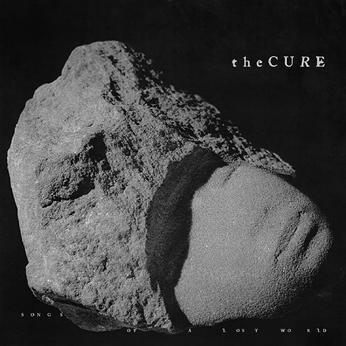
Then, wouldn’t you know it, I got married, had kids and did the grownup things and what The Cure were up to passed out of all knowledge, until a new album ensnared this listener.
On this platter the classic Gallup bass lines and tom-heavy drums that influenced my own drumming style at the time are back, as is the nihilism, but with a cinematic wash and still some playful undertones. Not really wine bar music (unless you’re a record shop too, of course), but maybe now the children are grown and my own mortality is in focus, I’m slipping back into the shadows. To quote One Hundred Years, this feels “just like the old days”. Now where is that black eyeliner and nail polish?
Steve Tattam is owner of Winyl, a wine and record shop in Manningtree, Essex
I strongly advise that for most lots you leave a bid ahead of time, and if it’s not a lot you’re dying to have then don’t even watch it! Just let the auction happen and if you get an email afterwards saying you’ve won it, then great. This is particularly important if you’re sourcing a specific wine or whisky for a customer, because they will have a budget and you don’t want to end up paying more than they’re willing.
I’m always really pleased when a bottle sells for what I’ve estimated. It’s very gratifying to know I’ve done the research and got it right. However, as any auctioneer will tell you, sometimes a bottle will go for far more than estimated – a Bottle of Green Chartreuse from the 1920s comes to mind. I valued it at a high of £800 and it went for over £4,000 because it got lots of bids on the book before the auction began, and then two bidders got into a competition over it.
I tend to put all the condition information I can on a lot; but people are free to ask for extra images, detailed fill levels etc. It does mean I have to hang out in a cold warehouse with my phone camera and a notepad, but it often pays dividends, particularly if you know more than me. On one occasion a customer asked for a close-up of the back label of a fairly innocuous looking bottle of whisky. It had been bottled by the fabled White Horse Distillery, a now-defunct company renowned for bottling some amazing casks of whisky, so bottles are scarce. In
Wine auctions can be superb places for sourcing stock, whether it’s familiar wines that can be sold at mainstream prices, or rarities that can be passed on to collectors and connoisseurs. But they can seem daunting to the inexperienced.
Sam Hellyer, head of wine and spirits at AZCA Auctions in west London, offers advice for making the most of the auction opportunity

this case it did draw my attention to that detail and I then added the information (and a close-up of the label) to the lot.
Look at the pictures of a lot. If the fill levels are bad and the label isn’t in a condition you feel is resaleable or worth it, then move on. We have three or four auctions a year; other auction houses have similar. When we take a cellar we often take everything, even the scuffed labels and less-than-perfect fills, so that we can get the exceptional ones with it.
Most auction houses will be happy to take a call from someone with questions. We can’t give out information on the vendors, but we can talk about the state of the cellar, where it came from, how many other people are interested in the sale etc. This can help to gauge how serious a collector the seller was, or how much competition there will be for the items you want. I’ve taken wine from music venues who found port while
refurbing a cellar, and from castles and closed-down wine merchants. The port was excellent, but it hadn’t been thought about in decades. The wine merchant’s cellar was great, and had full cases, and the castle had some exceptional single bottles. All these things appealed to different buyers.
There’s no definitive price tag, the wine rarely comes direct from the producer and there are usually more steps in the supply chain. An auction can contain bottles that are a couple of years old and some that are over a hundred (I’ve had a century-old bottle in more than one sale). The best thing to do is research; all of the above is essentially about that. Look at what it is, what state it’s in, what kind of cellar/seller it came from, how much the auctioneer thinks it’s worth (and ask why), how much it’s worth to you, how many bottles there are in the sale and how many there are in the market. You can get the answers to most of these with a call or email to the auction house – and the auction house always wants more bidders, so they should be willing to help.


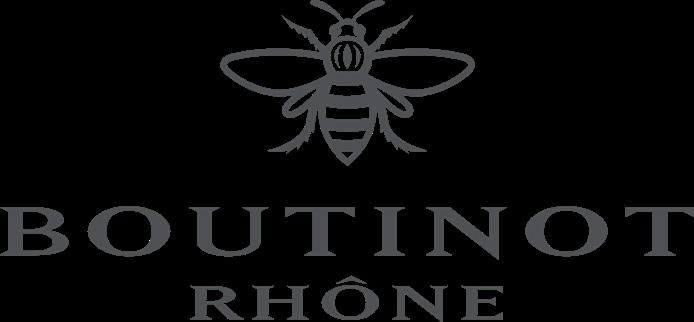
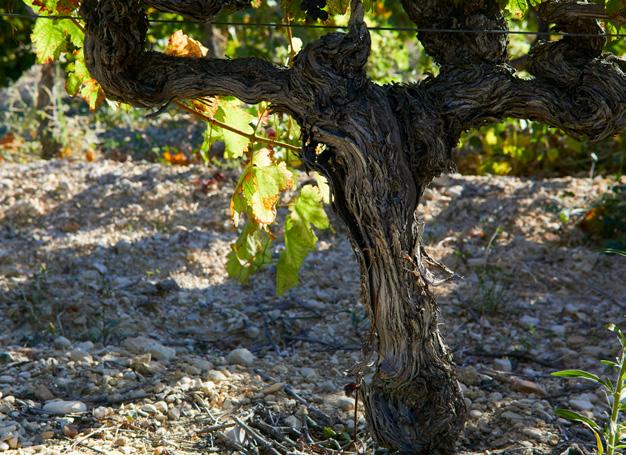
Boutinot’s Homes are the ultimate embodiment of the way we do things – a commitment for the long term and dedication to quality and sustainable winemaking.
Having control over every element in the chain, from vineyard management and vinification to label design and distribution, allows us to curate a range of wines that are unique to Boutinot.
Diversity defines the southern Rhône; its vast river has carved a complex landscape of varied terroir. Enchanted by this craggy, beautiful region, we began our search and, a decade later in 2009, found a plot of exceptional hillside vineyards: a discovery pivotal in our decision to establish Domaine Boutinot in Cairanne.
Plot 1: la Ruche, the hive
A parcel of old-vine Syrah and Grenache, La Ruche is deeply rich in limestone which helps absorb prized water in the heat of the day and micro-doses it out to the vine when it’s needed. A stratum of clay, with its phosphorous for forming the buds, and nitrogen and potassium, helps the vines produce starches and sugars.
Plot 2: la tRuffièRe, the tRuffle oRchaRd Old-vine Syrah thrives here, on a scape that produces black truffles. Woodland above ground and blue-grey limestone below enriches this beautiful plot. Humidity – a friend to truffle hunters, but not always to vineyard management – is minimised by the purifying Mistral.
At Boutinot sustainability has always seemed like simple common sense. We want to continue our work here to the highest standard for as long as possible and eventually pass it on in good health. All plots are tended to (and above) Level 3 of Haute Valeur Environnementale (HVE), which recognises a high level of commitment to protect and enrich the vineyards.

Plot 3: la Pauline, the humble one
La Pauline, a broadly terraced vineyard at the top of La Montée de Ventabren and one of the great parcels of Cairanne, is the reason we made our home here. Old-vine Grenache planted in 1969 sits on a vinous pavement of large heat-retaining pebbles, galets-roulés, on neothilic clay.
Plot 4: les six teRRasses, the six teRRaces
Slightly north of La Pauline is Les Six Terrasses, a modest cascade of lowyielding old-vine Grenache Noir. Higher in
Our devotion to the principle that good wines are made in the vineyard ensures that when grapes arrive at the winery, we are confident in taking a more hands-off approach, using the best of the old ways – open-top fermentation, pigeage-à-pied, slow cuvaison, and maturation in oak to suit the whims of what the weather gods have given us within that yearly cycle.
altitude than other plots, and with a south west aspect, the growing season here is longer, which yields grapes with vibrant colour, concentrated sweetness and a fine natural acidity.
Plot 5: font cRozes, the hollows
Planted on crumbly sandstone, layered with limestone in a gently undulating landscape, this plot is 100% Mourvèdre, a heat-loving, dark-skinned grape variety that gives backbone to blends. Ruggedly exposed on windy east-facing slopes, this plot inspired our cuvée La Côte Sauvage.
Plot 6: saint andeol, st andeol
Following the mountain contours down from La Pauline towards Cairanne is Saint Andéol, the oldest plot. Compressed limestone and free-draining sandy marl yield fantastic Grenache Noir, most of which was planted in 1957.
Plot 7: les GaRRiGues ouest et noRd, west and noRth GaRRiGues
Les Garrigues Ouest is an exceptionally sunny south-facing plot planted in 1962 with Carignan Noir. Due north, and sharing similar stony soils, is Les Garrigues Nord, the most recently acquired plot which was planted with Grenache Noir in 2021.
For information on our range of Cairanne wines and our current promotions please contact your account manager. For a quick tour of Cairanne, please click the QR code.
Sponsored feature


Charlotte Shek was bitten by the wine bug while studying for the WSET Diploma. She left a career in accountancy to set up shop in a Lincolnshire town that was in need of a proper wine merchant, and she’s never looked back
By Nigel Huddleston
There would appear to be no more natural place to find an independent wine merchant than a picture-book Georgian town in the heart of England that’s been used as a film and TV location for adaptations of Middlemarch, Pride & Prejudice and Bleak House.
So it’s something of surprise that Stamford in Lincolnshire had to wait until the second lockdown of 2020 to get one. That it did was thanks to Charlotte Shek, who founded Shekleton Wines after stumbling across an empty standalone unit bang opposite one of the town centre’s most popular street-level car parks – useful for loading cases of wine into the boot – while on a lockdown dog walk from her home five minutes away.
Having previously done a WSET course with her husband, the idea for a wine business of some sort had already taken root.
“We thought the course was interesting and just carried on doing more,” says Charlotte. “We both took the Diploma and part way through thought perhaps we should do something.”
Both were then working as accountants. “During
“ We picked the brains of people we knew in the industry about who supplied them and what they would recommend”
Covid everyone had lots of holiday owing to them because no one was taking it, so we thought, it’ll be fine, we’ll just take a couple of days’ holiday [to set it up]. But after a month we thought: ‘This is ridiculous. How on earth did we think we could do another job and this at the same time?’. I gradually quit my job to do it.”
Charlotte grew up in Clitheroe, Lancashire, and her family were loyal customers of the fabled D Byrne. That business, and the wider local wine trade network, was helpful in getting Shekleton started.
“There was a bottle on display in Byrne’s old shop from my grandpa’s cellar that he had drunk with Philip and Andrew Byrne. Maybe that’s where my love of wine started; I don’t know. My dad actually asked people in Byrne’s who supplied them, and we were customers of Fullaloves in Longridge who did some tastings for us. So we basically got some people who we knew in the industry and picked their brains about who supplied them and what they would recommend. That was very helpful and, of course, they aren’t direct competition because we’re not anywhere near them.”
When you saw the place, what were your first thoughts?
It was always going to be something to do with wine, but it just felt like a shop rather than a bar, so we ended up doing a shop. I didn’t want to do a bar anyway. I don’t think I’m enough of a night owl. It probably requires a different kind of person. I’m more interested in the wine than hospitality. I used to wash up when I was 14 and then did waitressing and bar work when I was about 18, but it’s a very long time ago now.
Lots of people were out and about doing lots of walking during lockdown, so at least people saw us. And as alcohol was considered an essential, we were one of the few shops that was open when we first started.
How did the look of the shop come about?
My sister used to work for Oliver Bonas as a visual merchandiser, doing store designs, and she helped with the design and the layout. She had access to computer programmes where you can have a look at what it all looks like before you actually do it, which was very helpful.
At first we had a big long table down the middle of the shop and she did really lovely displays on that, but people were afraid to touch it. Weirdly, if you mess it up a bit more people are a lot happier touching it. She was used to clothing, where it has to perhaps be a bit more perfect – and in wine people don’t want it to be quite so perfect.
We’ve changed the layout a few times. The till has moved because it made more sense from a space point of view.
“I
didn’t want the shop to be too trendy because that’s not quite the right thing for where we are”

The look du jour is very much scaffolding planks and poles, which you’ve avoided. What was your vision?
Wines are arranged by taste profile rather than region of origin

I wanted it to be cosy and welcoming, and I suppose feel a little bit more like a sitting room. And I wanted the colour of the walls to be like a red wine, so it feels a little bit like you’re inside a bottle. One of the things when you “do wine” is that people can find it a bit intimidating, and I didn’t want it to be that. And I didn’t want it to be too trendy because that’s not quite the right thing for where we are. Stamford’s not a trendy town. People are more traditional in what they want to buy: claret and Burgundy, that kind of style. Or they like something a little bit different, such as Georgian wines and other more unusual countries. They fall into two camps.
How does your range reflect that?
I wanted to make it easy to understand. Unless you know about wine you don’t necessarily know what all the countries’ wines taste like, so we merchandise it by taste profile, because generally speaking people prefer heavy wines or lighter wines. Customers say it’s easier to find things they
like. And they try things within the sections that they might not have known about otherwise.
We grouped it that way and then tried to cover good examples of traditional wines and a few more quirky ones thrown in: Georgia, Uruguay, Slovenia. The average price is probably around £18. During Covid we sold more lower-end wines but as time’s gone on we’ve sold more at the higher end.
What are some of your best sellers?
Our Georgian red has done particularly well, because it’s a nice bottle, a little bit different and soft like a Malbec; people like that. Bordeaux always does really well. Italian wines. Châteauneuf-duPape styles; Riojas. In whites, Grillo always does well because it’s a little bit different.
What principles guide your approach to buying?
Sometimes if you’ve got gaps you’re looking for something in particular. It’s a combination of many different things. Would I pay money for it? Is it good value for money? Is it what I would expect to taste when I’m drinking that wine? If people want a Malbec, they want it to taste how they would expect it to taste. Sometimes you taste something and just
“Cheese and wine is always the most popular tasting. I’m on about version seven now”
think, people will really like this.
Is Stamford ready for natural, biodynamic, orange?
We have done some natural wine. We have one orange wine and I’ve got a new one coming in. They’re more of interest to the younger crowd –people coming home from university.
Tell us about the events side of things.
At first it was a bit a strange because it was still in that lockdown time. We did some tastings over Zoom at first with little bottles and people tasting them at home. Now it’s much better and easier, obviously, because we can do them in person.
Now, we generally do about two tastings a month. Cheese and wine is always the most popular one. I’m on about version seven now and I’m going back and doing some of the earlier ones.
I also do private tastings. We had a lot of them in the early part of the year which meant I was doing less of our own. A lot of people were doing them for 50th and 60th birthdays. We hold all the tastings in the store and just change the layout. The most I can fit in is 16.

Do the tastings pay their way? They’re very much worth doing. People usually buy wine from you when they come to a tasting, but if not they always come back later. It creates a sense of loyalty to you.
I don’t think advertising really works: word of mouth works best and a lot of the time that’s generated by people coming to tastings. We’ve even had some people who came to a tasting who are coming back to do the same one and bringing some other people with them. I did ask them: “Are you sure you really want to do this?”
Are internet and wholesale on your radar? Internet business is quite small. Most of the business is walk-up retail. It helps being next to a car park.
We do a little bit of drinking in, by the glass. Again, I put wines into kind of categories and generally try to pick something that people are familiar with and things that are a bit different as well.
Wholesale’s something we’ve not got round to. My husband was a credit and risk manager and I know you have to be really careful in assessing credit limits and what you give to people. Accountants are generally risk-averse.
How has the cost-of-living crisis impacted on the local economy?
I suppose it’s strange because we have no other benchmark apart from the weird times. We started during Covid times and we don’t really know what it was like when it was normal. But it’s all good really so far.
Any regrets about the change of career direction?
No, definitely not. The best thing about it is you get to do what you enjoy – and you’re doing lots of different things. In accountancy it’s just dealing with numbers.
I’m trying to get to grips with social media now. I wouldn’t say I’m a natural Instagrammer, but I’m trying, because my husband did it all and I thought I should be doing it myself.
When you’re learning about wine, you’re not just learning about what it tastes like: you’re learning about how the grapes are grown, the geography and the science aspects. It’s similar running your own business: you do lots of everything.
“We started during Covid times and we don’t really know what it was like when it was normal”


Charlotte has no regrets about leaving the world of accountancy
Podere Le Ripi might be perceived as a crazy wine producer. Or maybe other winemakers are crazy for not following your philosophy, which after all is based on working with nature.
We could talk about this for hours. One of the most important strengths of Podere le Ripi was, and still is, investing in the energy and passion of young people. This can be considered a gamble, and it is, but to work in harmony with nature needs a sensitivity that sometimes is easier to find in younger generations.
Actually, some years ago, here in Montalcino, many people didn’t understand this kind of choice, or the idea of working without chemicals. Today, it’s different.
The climate is changing so fast; everyone knows it. Every year we have new challenges. Working in such close contact with our environment, respecting this beautiful place without forcing the vines, but trying to help them find balance, is the only way to try to get the best from each vintage.
How has the project evolved since the early days?
We try to never stop growing. Francesco started growing the vineyards around 1997 and creating a welcoming place for people. From 2012, Sebastian Nasello and Alessandro Riccò started to channel their passion and knowledge into wines that could talk about their terroir.
We decided to let the animals join the team; they help a lot by feeding the soils and enriching the place with biodiversity. A couple of years ago, we decided to increase the bee colonies that populate our vineyards thanks to the green manures. We started with five beehives and now have around 200.
It’s the same in the cellar: how can you think to have the same approach every year with a different starting product, depending on the conditions? Living in the vineyards, tasting the grapes and the wines is the only way we know to try to make the best decisions.

Set in the south of Montalcino, Podere le Ripi is owned by Francesco Illy of the coffee dynasty, who took over in the late 1990s with a dream of transforming the former sheep farm into a self-sufficient, regenerative property embracing all forms of agriculture. Wine came later within this vision but soon became the main focus
We’ve learned that every little step needs time, people and energy, and we don’t want to stop learning.
Is biodynamics a science or a religion? Or something else?
Today, in 2024, we are all focused on many things, everything moves very fast, and we’ve lost the ability to listen and understand. Instead of cooperating with nature, many times we try to force ideas on something that’s much stronger than ourselves, and today we are seeing the
results. There are many scientific books which try to explain the connections we have with everything around us.
Biodynamics for us is a method and a behaviour. You can learn the method, but if you don’t know your place, it’s hard to achieve results, because it is not a recipe. Every place is unique and able to give back something unique as well. But you must understand what can work best for you, and look for achievable results, starting from the vitality of your soils and ending in the quality of your wines.
Podere Le Ripi Attenti al Lupo 2022, IGT Toscana (RRP £27.95)
“We were looking for a pure Sangiovese, true to Montalcino, but slimmer, enjoyable in youth and, at the same time, charming. We went to Beaujolais to study carbonic and semi-carbonic maceration, with which we achieve more freshness and less structure. You can recognise the Sangiovese, but it’s definitely something different to the classic Montalcino style.”

Podere Le Ripi Cielo d’Ulisse 2020, Brunello di Montalcino (from February, POA; 2019 vintage is available, RRP £58)

“A wine we produce from our best vineyards in the west side of Montalcino, surrounded by the forest: a very wild place, rich in biodiversity. Usually wines from here are very elegant, and enjoyable from release. 2020 is a wonderful surprise; after a very fine vintage like 2019, we are happy to find something so crunchy, and rich in enveloping flavours.”
Podere Le Ripi Lupi e Sirene 2018, Brunello di Montalcino Riserva (RRP £105)
“Our only Brunello Riserva, from a single vineyard that we grow on the south east side of Montalcino. It has always been a noble wine, with aromas ranging from balsamic to Sicilian blood oranges. The palate is silky and very long. Coming from a cold vintage, it is also very clear. For us it’s a hypnotic wine that ages well in bottle and maintains its intensity.”
In association with Jeroboams Trade jeroboams.co.uk
020 7288 8888


Michelini i Mufatto Certezas
Sémillon, Uco Valley, Argentina 2021
Coverage of Argentina has fallen prey to what I think of as “Bordeaux syndrome”, a condition by which our perception of a wine region or country is based almost entirely on the tiny top-end of production and overlooks the ongoing sales trials and viability tribulations experienced by a majority of the region/country’s producers and wines.
On the face of it, this has been a terrible year for Argentine wine: the worst, according to Wines of Argentina’s Centre of Economic Studies, for 20 years, with a steep fall in exports (thanks largely to exchange rate issues) adding to long-term decline in domestic consumption.
But while this latest crisis in a country
& Barrow buyer
Rebecca Palmer calls
Argentina ‘perhaps the most exciting country at the moment’
for wine

Intensely complex, but fluent, Sémillon
and industry that has grown used to them should perhaps be the headline story, what I’ve found from talking to merchants, importers and sommeliers this year is a feeling of almost unanimous positivity about Argentina’s blossoming fine wine scene.
Among the most enthusiastic Argentina advocates is the influential Corney & Barrow buyer Rebecca Palmer, who has
recently rejigged the C&B Argentine range to reflect the new wave of terroir-driven wines, many from very old vines, that have made the country, in her words, “perhaps the most exciting around at the moment”. Two I tried and loved this year are both from the Uco Valley: Gerardo Michelini and Andrea Mufatto’s intensely complex but fluent Sémillon from a 133-year-old vineyard; and the gorgeous aromatic detail and velvety texture of Mil Suelos La Verdad Malbec Buscado Vivo o Muerto 2019.
La Jota Vineyard Co Howell Mountain Cabernet Franc
Napa Valley, California 2019
One of the preferred varieties used by the Argentine new wave is Cabernet Franc, which, among many other standout performances, plays a supporting role to the Malbec in the Mil Suelos and gets a solo outing in one of the highest-scoring wines at this year’s Wine Merchant Top 100: Ver Sacrum La Cayetena Cabernet Franc 2020. But, as good as Argentine Cab Franc can be, the country is but one of many territories that has been commandeered
by the variety’s many fans in recent years, with 2024 really seeming to be a watershed moment in Cab Franc’s rise to prominence.
Why now? Well, in part it’s down to an ongoing stylistic swing to refreshment and crunch in red wines that has helped the Loire especially. But there’s a slightly sinister side to it too: many growers making Bordeaux styles in warmer climes (including Bordeaux itself) are using Cabernet Franc, often in preference to Merlot, to add freshness and snap to their blends.
I’m a longstanding lover of the Loire style of Cab Franc, but after participating in a tasting of around 40 of the world’s best Cab Francs organised by The World of Fine Wine magazine earlier this year, I was equally impressed by the richer, deeper styles on offer in Bordeaux, Bolgheri, South Africa and, a surprise to me, Napa, with the latter represented by the outstanding luxuriously silky example from La Jota Vineyard.
Tesco Finest Floreal 2023
Another group of varieties taking a tilt at the mainstream this year was the bunch of recent hybrids known as PIWIs.
The fruit of crossing Vitis vinifera with American grapevines, PIWIs (short for the German Pilzwiderstandsfähige Traubensorten) are bred for resistance to fungal diseases, and, their advocates say, reduce the need for vine treatments by as much as 90%. This in turn has a huge knock-on effect on carbon emissions and soil compacting.
All of which means that, in a year in which mildew has been damagingly rife across Europe, there was something undeniably timely about the arrival of such high-volume PIWI wines as Tesco Finest Floreal (a white from the Loire) and Paul Mas Sauvignon Blanc-Souvignier Gris. And while both lean more to the competent than the world-beating, they are surely


just a taste of things to come as climate change renders wine-growing ever more challengingly chaotic.
Calmel & Joseph Pomone
Vin de France 2023
For all that many traditional wine producers and critics may profess to despise natural wine and all it stands for, the counter-cultural scene’s influence on the wider wine world has been surprisingly profound.
You can see it in all those “low intervention” claims on so many


“conventional” wine back labels. You can see it in the spread of mass-market lowsulphur wines. And you can see it most clearly of all in the rise of what might be called unfunky orange wines.
No doubt naturalistas themselves will sneer at wines that differ from conventional white wines only in their addition of a few weeks’ skin contact to an otherwise strictly-controlled, squeaky-clean winemaking style. But for the less dogmatic among us, I reckon the emergence of pristine, gently chewy, well-distributed and competitively-priced orange wines such as Santa Tresa’s Insieme Orange 2023 from Sicily or the Top 100-winning Pomone from the Languedoc can only be a good thing.
Western Cape, South Africa 2023
Every year for the past five years I’ve told my readers in The Observer to forget about finding decent wine for a fiver, explaining just how little of the bottle price ends up paying for the wine itself.
But there are always exceptions: every year at least one of the supermarkets manages to get something on shelf that confounds reality – a genuinely drinkable wine, made without recourse to the classic masking agent of sweetness, and with some structure, fruit, and even a touch of savoury interest.
This year, the supermarket in question is Asda, in the form of a genuinely drinkable Pinotage (no mean feat at any level) for the absurd price of £4.25. How did they do it? One clue is in the ABV: 11%, just ducking below that arbitrary 11.5% abv bar.
Is it sustainable? Only if Asda has decided it’s worth taking a hit on the margin as part of a marketing message that says it offers wines that everyone can afford. But even then, the days of this sort of wine are surely numbered – or at least, they should be.
There’s a natural fit between the two businesses, and merchants will experience the full impact of the merged ranges
When a wine importer takes on a new agency, there’s always a frisson of excitement. So imagine the mood at Alliance Wine since news was confirmed that it’s bought H2Vin.
The deal has, at a stroke, brought between 75 and 90 extra producers into the Alliance fold, most of them from H2Vin’s strongholds of the Loire, Burgundy and the Rhône. All the H2Vin team have transferred across, too, including founders Matt Wilkin MS and Christian Honorez.
To outsiders, it might look like a classic case of a larger company opportunistically swallowing up a smaller rival. But Ned Llewellyn, Alliance’s off-trade sales director, insists that’s not how it feels from the inside – nor, indeed, the reality.
“We’ve been looking for a like-minded company for quite a while,” he reports. “We’ve spoken to a few people, but this one just really had the right kind of fit in terms of culture, people and wines.” Alliance has been on a steady premiumisation drive for some time, he adds, which means the H2Vin portfolio – which includes some rarified names – won’t look at all out of place under the new joint branding.
H2Vin is a £2m business, achieving 40% of its sales in the indie sector and 60% in the on-trade. It had six staff on its team.
“It’s a really exciting time,” says Llewellyn. “It’s funny – whether you’re buying a £2m company or a £15m company, the logistics and the legwork in
Burgundy bonus for indies



getting it all set up and integrated are not really that different. There’s a lot of work to do to merge systems, to merge portfolios.
“H2Vin has about 200 customers, and we only cross over with about 40. So there’s 160 potential customers for Alliance’s producers, and even more for the H2Vin producers.”
The H2Vin buying strategy had been “to find what they feel is the best producer
The H2Vin purchase means that Alliance Wine has significantly strengthened its Burgundy specialism – and independent customers can benefit almost immediately. Ned Llewellyn is joining Matt Wilkin and Christian Honorez on a trip to Burgundy this month, visiting some of the region’s leading producers ahead of a new Burgundy en primeur campaign for indies in January, which will include wines from more than 30 domaines.
in every appellation”, Llewellyn says. “And that means they’ve got some real superstars in their list.
“Clos Rougeard is one of the high highlights of the Loire Valley; there’s also Domaine Guiberteau in Anjou; Champagne Larmandier-Bernier; La Vieille Julienne in Châteauneuf-du-Pape …
“We’ve just done a tasting at Trivet [the two Michelin-starred restaurant in Bermondsey]. We invited 40 customers and showed 40 wines, kind of half-and-half from each portfolio, all completely mixed up, showing some of their really famous producers and some of ours as well. We showed wines from Abel Mendoza, Pazo Senorans, Equipo Navazos, Paul Hobbs, Raats and Thistledown alongside some of their top producers.
“It was an amazing tasting, and it really shone through just how well the ranges can knit together.”
There’s a good cultural fit, too. “If you asked H2Vin what they were known for, they would say producers and service,” says Llewellyn. “And I think that’s really similar to where we are. They’re moving from a six-person company, with a very personable service, to a company like ours, where we’ve got the network and the distribution to be able to really be best in class for service.
“When we ask our customers what they think the best things are about Alliance Wine, they often lead with service, alongside people and wines. So there’s a lot of synergy, and our reach across the country, next-day delivery and industryleading portfolio is going to be a real advantage.”
The Alliance Wine team, and its customers, are quickly being acquainted with the wines that are now part and parcel of the range. There has been a series
at the Edinburgh (March 3) and London (March 5) portfolio tastings
of small, focused tasting events but the spring tastings in Edinburgh (March 3 at Mansfield) and London (March 5, St Marys Marylebone), are the big dates for indies to keep free.
“We’re planning to show significantly
more wines, offering customers the chance to meet a lot of our new producers, and we are planning for greatly increased numbers through the doors for these showcase tastings,” says Llewellyn.
“We want to make a big splash about
this. It’s really exciting news for us, and it’s going to make a big difference. This makes the combined business more attractive to an even broader range of customers.”
Find out more at alliancewine.com
Six highlights from the newly-combined range
Paul Lebrun L’Irremplaçable Blanc de Blancs Brut Champagne NV (RRP £38.55)
“Paul Lebrun has been in our portfolio around 18 months,” says Llewellyn. “They’re based in Cramant, a sixth-generation family producer, making lovely wines – and this is the starting point.” There’s generous Chardonnay fruit on the palate but the finish is distinctly mineral, with a satisfying saline kick.

Château de Plaisance Anjou Blanc 2022 (RRP £24.92)
This estate in Butte de Chaume, a premier cru of Anjou, has been biodynamic since 1995. “I tasted this recently with Matt Wilkin and it’s the kind of wine you want to keep close to hand in the fridge,” says Llewellyn. “It’s not stupidly priced and it’s a great example of Anjou.” Made with Chenin and aged for a year on lees, it’s rounded and supple, with a brushed-cotton softness.

Domaine des Baumard Clos St Yves Saviennières 2020 (RRP £33.54)
“This is another of our existing producers,” Llewellyn says. “They only produce Chenin Blanc and they are well known as one of the top producers of Saviennières. This is a completely different style of Chenin. Their wines are always really distinctive and this one has such minerality to it – that wet-rock-in-the-rain sort of character.”

Eric Texier Chat Fou Vin de France 2022 (RRP £20.55)
Based in Brézème, in the northern Rhône, Texier likes to work to his own rules and has added 15% Clairette to this Grenache/ Cinsault blend. “It just adds this real freshness and life to the wine,” says Llewellyn. “It was with FMV before us and was one of those wines you’d see in all the trendy bottle shops in London. We’re continuing that business and seeing a lot of success.”

Domaine de Pallus Chinon Rouge 2021 (RRP £21.54)
Llewellyn is delighted to welcome a Chinon to the Alliance line-up. “These guys buy their barrels from DRC and Haut-Brion and finish their wines in them,” he says. “They work with lots of old-vine fruit and they’re searching for concentration without being heavy. The wines all have this lovely lift and freshness.”

Domaine Alary Tradition Cairanne Rouge 2020 (RRP £20.62)
“I’ve now tried a couple of Cairannes made by this producer and thought they were both absolutely delicious,” says Llewellyn. “The wines are really classic and crunchy. I remember being told on my first-ever wine trip that drinking Cairanne should be like biting into a big, cold bunch of grapes. You get that kind of real explosion of flavour, and these guys do it very well.”

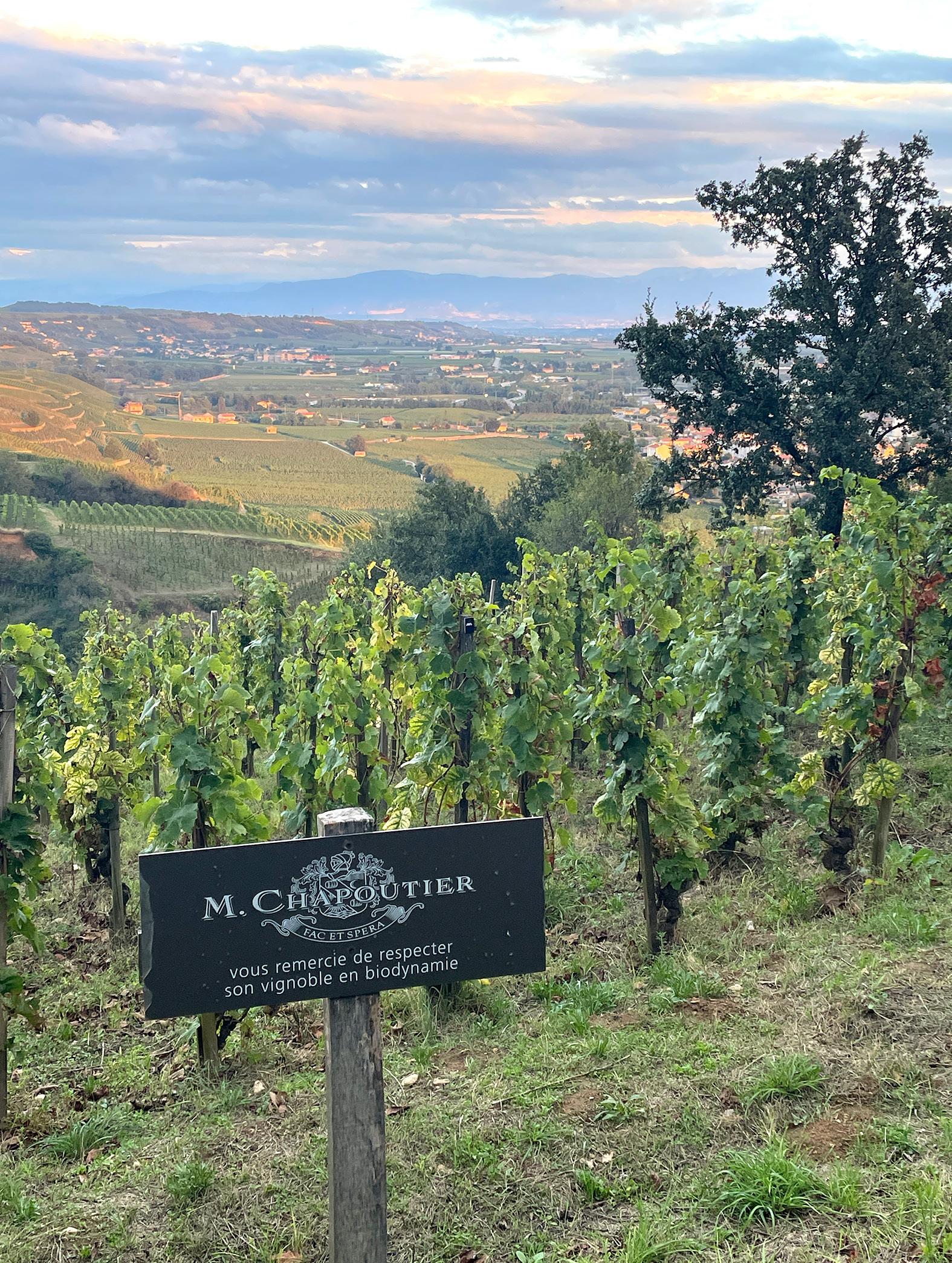


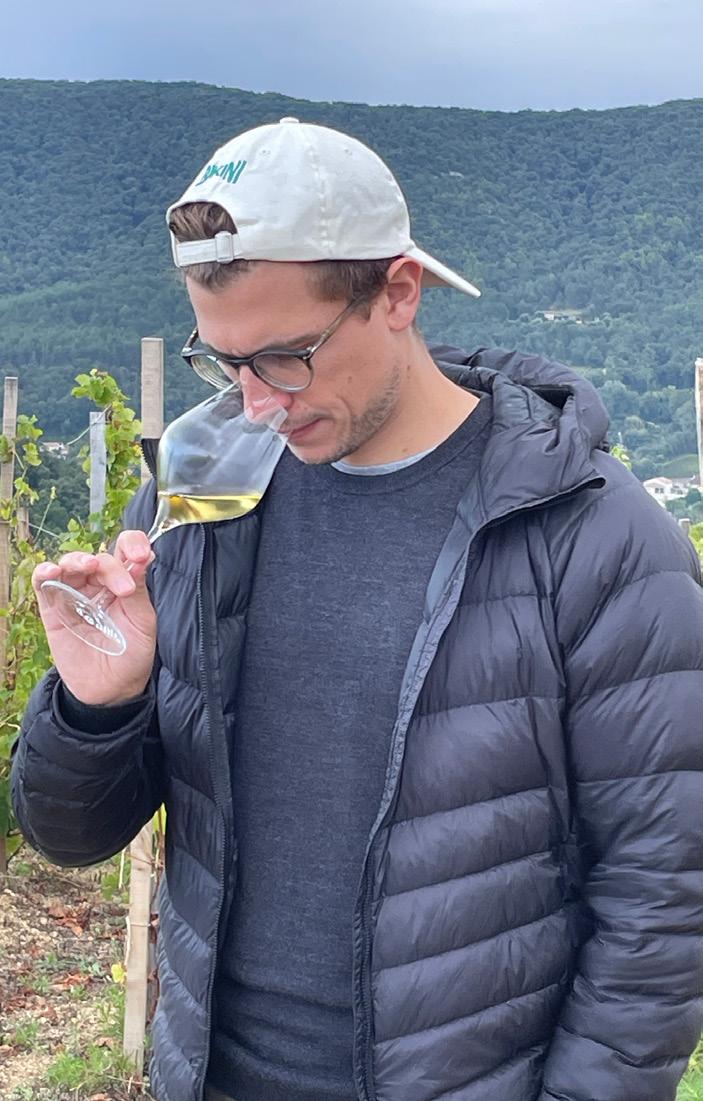
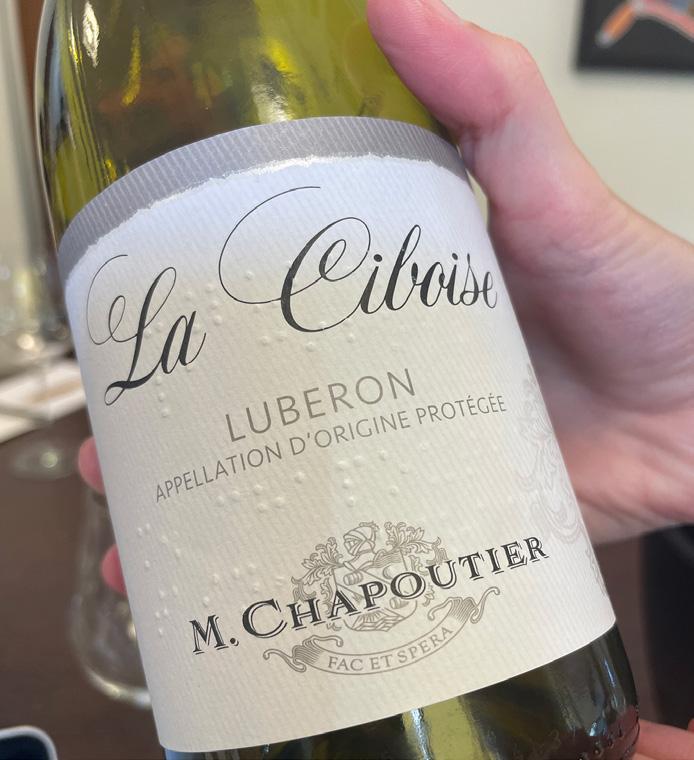

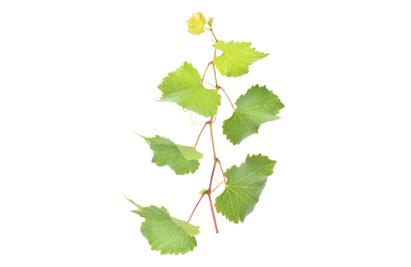
In September, a group of independent merchants headed to southern France to explore the renowned biodynamic wines and vineyards of M. Chapoutier
By Sarah McCleery
Michel Chapoutier has been called a chineur: literally a bargain or treasure hunter. The label comes from his passion for finding terroirs whose challenges are matched only by their potential.
A recent indie trip to the vineyards of M Chapoutier, from the north to the southern Rhône and onwards to Roussillon, was a vinous treasure hunt of the most illuminating kind. Our feet walked the steep granitic soils of Condrieu, the schist of the Côte-Rôtie, and to the top of the world-famous Hermitage Hill. All on day one, with a comprehensive tasting in between.
Our host, export director Martin Champagne, talks compellingly about M. Chapoutier’s commitment to biodynamics, as well as the importance of monovarietal wines across the range. “With the diversity of soils we have, vinifying a single grape variety is the only way to bring out the full expression of the terroir,” Michel Chapoutier has said. “Without interfering by blending, the wine grower’s mission is to accompany that expression.”
It leads to an almost overwhelming range of wines. Even Martin looks momentarily flustered – for the only time in three days of quizzing – when asked how many wines
M. Chapoutier sells. It lists nine – both red and white – from Ermitage alone. (The decision to use Ermitage, as opposed to Hermitage, is the house sign that the wine is from a single vineyard).
Marsanne: Love at first sight
Michel Chapoutier is a self-proclaimed Marsanne enthusiast. The variety retains its (admittedly modest) acidity well, even in hot conditions, and its ability to withstand extreme weather must surely be a factor in the variety’s increasing presence in southern France. The M. Chapoutier team, while noting it can be capricious in the vineyard, are enthusiastic about its food-pairing potential and ability to age majestically in bottle.
Emily Silva of the Oxford Wine Company is cautiously optimistic about Marsanne’s saleability. “It’s a wine that would need to be hand-sold by someone who really, really loved it,” she says. “I think it would do best as either an entry-level wine or at a premium price.”
Amaury Levisalles of Authentique in north London is entirely charmed by the variety. “Haut-Chamblard 2022 SaintPéray has more tension than the wines from any other producers I’ve tried,” he says. “This will definitely be hitting our
shelves very soon.” He is equally enthused by the Ermitage de l’Orée 2012, which he describes as “spot on, with the right amount of evolution”. He adds: “The patina of age, without a hint of oxidation, really shows the immense potential of Hermitage whites.”
Biodynamics: A core philosophy since 1991
There are few wine companies on the scale of M. Chapoutier which have so completely embraced biodynamics. While not every wine comes with certification (perhaps due to some bought-in grapes, or proximity to non-practicing neighbouring vineyards, or because the site is in transition towards biodynamic practices), Martin explains that biodynamics is practiced on all M. Chapoutier sites.
Michel Chapoutier himself says: “In my book, respecting the ecosystem is nonnegotiable if you want the terroir to find its expression. When I’ve worked with science it has been as a lay observer. I have always mistrusted formatted classical methods of teachings. That’s how biodynamics came about – not because it was trendy.”
We walk past the innocuous-looking house where the treatments are prepared, on the way to the top of Hermitage Hill.
Preparation 500 boosts soil life. It’s made by filling cow horns with dung and burying them over the winter. The fermented contents are removed in the spring and added to the likes of camomile, yarrow, dandelion and nettle. Once blended with potentised water, the preparation is applied when the vegetation starts to grow, supporting root growth and helping the vines to support dry periods.
For Preparation 501, quartz rocks are placed in the horns and buried in the ground during the summer. Like 500, it is later mixed with potentised water before being sprayed onto the leaves. Its proponents maintain that this encourages plant growth, and aids flowering, fruiting and ripening.
It’s a pity that we don’t catch sight of any of the horses that both work and occasionally roam free in the vineyards. They contribute all-important organic matter and, unlike tractors, they don’t compact the soil. The steepness of many of the Rhône vineyards makes them an integral part of the viticultural team.
On day two the vineyard hunt continues apace. Visits are made to Saint-Joseph, Cornas and Saint-Péray. The impressive amphitheatre of the Cornas vineyards, with their sandy, granite soils, is breathtaking, but the lesser-known Saint-Péray also
other wine highlights

piques the indies’ interest.
At 350 metres above sea level, everyone’s quick to notice the brisk, chilly wind. What’s underfoot at these east-facing vineyards is markedly different to what we encountered yesterday: the granite is more friable, with sand and clay also present. Marsanne is queen here: with a glass of Haut Chamblard in hand, the steely tension and generous white summer orchard fruits are apparent to us all.
Soon afterwards we are standing on the famous Châteauneuf-du-Pape galets roulés These large pebbles are tricky to walk on, as heavy as you might imagine, and prized by vignerons for their ability to absorb, and radiate, the summer sun. It’s a fun
Marius Avenue de la Gare is the label name for an entry-level white and red IGP des Collines Rhodaniennes. Amaury Levisalles of Authentique sums it up: “Mind-blowing in terms of value for money. Very straightforward and faithful to what Syrah and Marsanne should taste like.”
Luberon La Ciboise Blanc also finds favour. Kat Stead of Brigitte Bordeaux says: “Lovely freshness, a touch of sherbet, lively green notes, citrus and a clean acidity … at the price point I could definitely see it having a place on my wine list.”
Saint-Joseph Les Granilites Blanc is a favourite of Emily Silva at Oxford Wine. “There is a particular interest in wines from the northern Rhône at the moment, and I feel that this is a particularly strong proposition, given its light, fragrant style and moderate alcohol – characteristics particularly in vogue with our customers.”

moment for anyone who hasn’t seen them before. It’s also a chance to admire the stoic 80-year-old gobelet vines. In situ there’s an opportunity to sample the 2020 Croix Bois: a 100% Grenache Châteauneuf that surprises some with its rich but nimble palate.
Lunch in Châteauneuf-du-Pape is one of the highlights of the trip. Our restaurant, Le Verger des Papes, offers a stunning view of the appellation’s vineyards and provides the chance to enjoy a couple more M Chapoutier wines.
Rouge Clair 2023 is made to be served chilled, or on ice. A blend of Grenache Noir and Syrah, it comes with a thermochromic label that reveals “& Frais” when the bottle is 12˚C or below. There’s also no capsule on the bottle, as part of a drive to achieve a net neutral carbon footprint.
Duncan Gammie of The Wee Vinoteca adores this wine, describing it as “exceptional and lovely”. Emily Silva calls it “a compelling commercial proposition … a style that is very popular with our customers at the moment”.
The white Châteauneuf-du-Pape 2023 La Bernadine takes things up a notch or two. Aged in demi-muids and stainless steel, the wine is a blend of both Grenache Gris and Blanc with Clairette and Roussanne. There is plentiful praise for the wine’s freshness, balance and gastro credentials.

Heading for Roussillon, the home of Bila-Haut
Domaine de Bila-Haut is an extraordinary place, isolated and stunningly beautiful. Between 400 and 500 metres above sea level, the vines are planted in granite and sandy-granite soils. Michel Chapoutier saw the potential of this terroir, which gives wines that are both structured and fresh, purchasing the site in 2001.
The blustery winds help keep disease at bay, and the vines healthy. Come the hot summers, the high altitude brings cool nights and respite to the vines. The principal challenge is the sometimeslow levels of water, which the now biodynamically-managed vines cope with well, their roots punching deep into the soil in search of precious moisture.
The tasting of the Bila-Haut wines delivers what was for some the best white wine of the entire trip. Occultum Lapidem Côtes du Roussillon Villages Latour de France 2020 is 70% Grenache Blanc with 30% Vermentino. There is unanimous praise for the wine and the value for money it offers.
“There’s great balance, and a creamy texture, but still enough acidity and some lovely fresh stone fruit notes,” says Kat Stead of Brigitte Bordeaux in Nottingham. Emily Silva goes further: “It’s one of the best southern French wines I have ever
tried,” she says.
“The visit to these vineyards was a particular highlight for me – we seemed to drive into the middle of nowhere, surrounded by spectacular mountain scenery. The vineyard was so isolated, and I couldn’t help but reflect on what a passion project it must be, given the effort required to maintain a site like that with all the drought pressure and challenges associated with cultivating such old vines.”
For Duncan Gammie, Bila-Haut wines are “excellent”. He adds: “I hadn’t tried premium aged Grenache Blanc before. It was very gastronomical.”
VIT Sélection Parcellaire is a special Grenache, with VIT standing for visitare interiore terrare, meaning “visit the innermost earth”: a reference to Michel Chapoutier’s search for the best terroir in the Côtes du Roussillon. RI Sélection Parcellaire is an old-vine Syrah, with the phrase rectificando invenies (“search and you will find”) inspiring the name.
It is a triumphant finale to what has been a whirlwind hunt, in which no shortage of treasures have been unearthed.
Amaury Levisalles
Authentique, north London
“A fantastic trip and a great way to discover, for the first time, the wines from M. Chapoutier. I was impressed to learn that Michel Chapoutier was one of the pioneers of biodynamic farming in the vineyards in France.”
Kat Stead
Brigitte Bordeaux, Nottingham
“I didn’t think I was a particular fan of Rhône whites, so was really pleasantly surprised that the whites ended up being the stars of the trip for me, and it’s definitely changed my attitude towards them.”
Duncan Gammie
The Wee Vinoteca, Hertfordshire and Cambridgeshire
“I had kind of given up on the northern Rhône for being too expensive for the good stuff and on the southern Rhône for lacking flavour and being too alcoholic. The trip definitely changed those perceptions. I had always known that M. Chapoutier was a good producer, but this trip highlighted how good they are in comparison to the other wines from the region I have tried.”
Maxine Lucas
Levels Bottle Shop, Eastbourne
“The wines we tasted and the vineyards we visited showcased the diverse terroirs of the Rhône Valley.”
Brian Saunders
Magnum Wine Shop, Swindon
“What impressed me most is the purity of style which M. Chapoutier is producing. All the wines showed great balance of fruit and acidity with a wonderful, polished feel.”
Published in association with Hatch Mansfield. For more information visit hatchmansfield.com or call 01344 871800

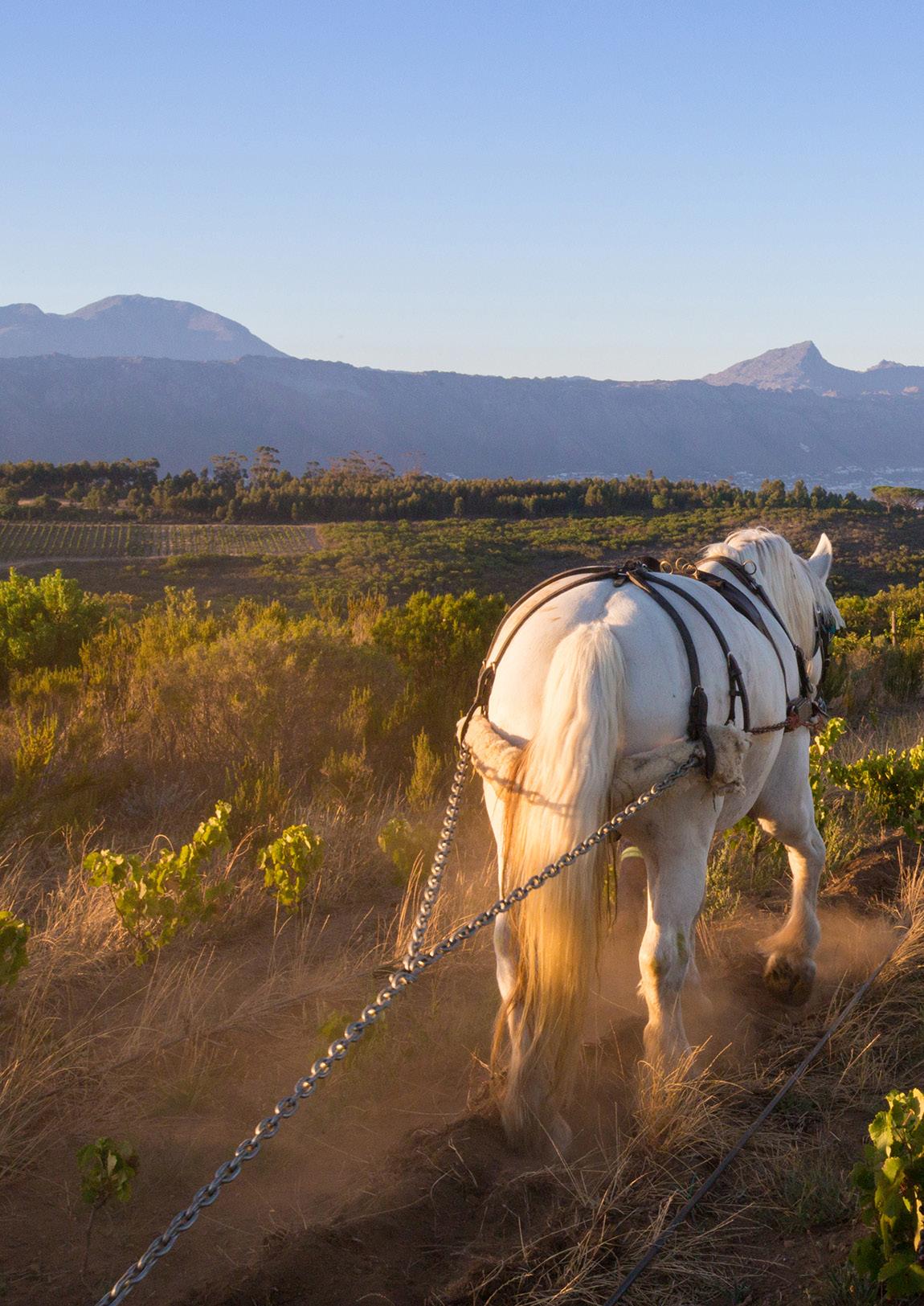

From bottle re-use to PIWIs and the many forms of certification, David Williams picks out some of the key developments in the wine trade’s progress towards a sustainable future over the past year
One of the key tools being touted by viticulturists in their bid to lower chemical use in the world’s vineyards is the new generation of grape varieties known as PIWIs.
The result of crossings between different species of grape vines, but generally with a higher proportion of European Vitis vinifera in the mix than previous interspecies crossings, PIWIs (short for the baroquely German Pilzwiderstandsfähige Traubensorten) are bred for their resistance to fungal disease and have been credited with significant reductions in pesticide use – by as much as 80%-90% in some accounts.
In a year in which much of Europe, notably France, has again suffered from widespread problems with mildew (early predictions from the French agriculture ministry suggest a 16% drop in the total French harvest versus 2023, largely thanks to downy mildew caused by early-summer rains), it’s easy to see why an increasing number of winegrowers are either contemplating planting PIWIs or are already making wines from them. That the drop in fungicide dependence is matched by a significant reduction in both CO2 emissions and soil compaction, since winegrowers require far fewer tractor passes through the vineyard, has also won over many former sceptics.
Acceptance is still far from unanimous, however. For some growers, such as Champagne Louis Roederer’s influential chef de cave, Jean-Baptiste Lécaillon, a little caution is required. Lécaillon, who has devoted much of the past 20 years to researching and developing clonal diversity in Champagne, including starting a Roederer nursery in 2008 which now features more than 150 virus-free Pinot Noir clones, believes PIWIs should take second place to greater research into massal selections of existing varieties.

“Many people believe in [hybrid vines] as the future,” Lécaillon says. “I’m not saying this is not the future. I’m saying this is an interesting topic. But we have no idea and no feedback about how these new vines will resist with time.
“Maybe we are creating some vines that after 20 years won’t be working at all. That's why I think the massal selection is very important, because we know it comes from 2,000 years, while the hybrids are new.”
A further obstacle for PIWIs is public acceptance of a clutch of varieties whose very names – Sauvignac, Souvignier Gris, Muscaris, Pinotin, Cabernet Noir, Johanniter, Cabernet Jura – have a slightly uncanny, AI-generated feel.
On this score, however, 2024 has felt like a watershed moment in the UK, with a number of high-profile releases of wines made either exclusively or in part from PIWIs. What’s more, newcomers such as Tesco’s Finest own-label Floreal (made by Lacheteau, the Loire subsidiary of Les Grands Chais de France), The Wine Society’s Sauvignac (from the team behind Château Thieuley in Bordeaux) and Domaine Paul Mas Sauvignon BlancSouvignier Gris (Languedoc) have not been shy about talking up the wine’s PIWI content, giving the varieties a prominent place on the front label, and backing them up with PR and marketing campaigns.
For all that cans, plastic and paper bottles, bag-in-box and pouches have continued to make inroads into retailer ranges, the glass bottle still accounts for the overwhelming majority of wine sold in the UK and around the world – and for all wine with a drinking span of more than 12 months.
It is also the primary source of wine’s carbon emissions: estimates vary wildly in a range between 30% and 68% of the total but, whatever the figure, it’s clear that grappling with types of glass, and the ways in which it is used and sourced, is essential to any serious progress towards a net-zero future for the wine business.
Bottle weight is one field of battle in which significant progress has been made over the past 12 months. In October last year, the members of the Sustainable Wine Roundtable, which includes Whole Foods Market, Naked Wines USA, Naked Wines UK, Laithwaites, Lidl GB, The Wine Society, Virgin Wines, Waitrose and Swedish monopoly Systembolaget, made a commitment to lower the average weight of a wine bottle in their ranges from around 550g to less than 420g by the end of 2026.
The commitment to an “average” of course leaves scope for at least some of the range to come in heavier bottles. And in most cases, it’s been at the lower end, where bottles are already at their lightest, that producers have concentrated their lightweighting efforts.
But there has been progress made, too, by companies operating at more premium price points. This summer, for example, Argentina’s Zuccardi family announced they would begin their lightweighting programme, which will eventually roll out across the range, with some of their most expensive bottlings, including the circa£75-a-bottle Finca Canal Uco, which will
drop from a hefty 900g to 570g. Zuccardi said the focus on the upper end was a deliberate decision made in an attempt to weaken the connection between heavier bottles and wine quality.

Telmont is leading the way with lighter bottles
Weights are beginning to come down in the category which has the best excuse for using heavier bottles. French bottle manufacturer Verallia had done much to lighten fizz-bottle loads when it began to produce 835g bottles capable of
withstanding the greater internal pressure, from a previous mimimum of 900g, in the mid-2020s. Now the company has got that down to 800g, with Champagne Telmont set to be the first to release a wine in the bottle in 2026.
As well as watching its weight, the British wine trade is increasingly pinning its hopes on bottle reuse. According to The Future is Reusable, a report put together by the London Wine Fair’s Bottle Collection Initiative, the potential energy savings on reusing a bottle could be as high as 96% when compared to single use.
Published as part of the Ready Reuse Charter, the findings, based on an audit of 1,017 of the 20,000 empty bottles collected at the 2023 LWF, also included 95% savings of CO2, 99% savings on mineral raw material, and 60% reduction in water use.
The Charter calls for greater action, including more standardisation of bottle designs and more automation, and makes clear that the British wine trade should come to terms with the fact that the “bottle of the future is reusable”.


“I’ve been banging on about bottle weight since 1976. Bottle production and transport is the biggest contributor to wine’s carbon footprint.
“Glass, of course, is the ideal inert material for wine designed to be aged for many years, but most wines are consumed within weeks, days, hours or even minutes of purchase. It really is crazy to be shipping wine around the world in a package as heavy, space-hungry and breakable as glass bottles.”
“A lot of people are complaining that young people aren’t starting to drink wine. I honestly think a main reason for that is because most wine is sold in 75cl bottles. They have to invest quite a lot of money to buy quite a lot of wine, and in many cases must buy a special instrument just to get into it. A 25cl can would be so much more attractive for a young person wanting to try wine.”
“There are huge opportunities for alternative packaging. Why dither? Make lightweighting decisions now.
“I urge you to encourage people to put wines of better and better quality in these alternative packages. They may never really catch on if they’re seen simply as a way of shifting the most basic quality wine.
“Do as the Nordics have done and remove the stigma from bag in box.”
“Our recycling system in this country may be much better than the American one, but it is shamefully inferior to what is the norm across most of mainland Europe.
“The drinks industry is the cork industry’s biggest customer and in theory, corks are recyclable, but in practice most of them just go to landfill. For those that are recycled, they are usually shipped back to Portugal – an energy and emissionintensive exercise – to be repurposed into other cork products.
“We need a genuinely impartial, comparative lifecycle analysis of all bottle closures available, which has been lacking.”

For the past 45 years, Boutinot has always tried to work with sustainability in mind. We just didn’t always give it this label: to us it’s always been about best practice and trying to do things the right way.
In owning vineyards, sourcing and proudly representing wines from more than 200 producers, it’s crucial that we now examine every step through the lens of environmental responsibility and social impact – our green thread across the company.
Our diverse portfolio is sourced from over 20 countries, and we are extremely proud of the care and dedication that our producer partners put into creating their incredible wines.


Understanding what sustainability means to the drinks trade is complex, so inclusivity and collaboration are essential, and that’s why we’re members of the Sustainable Round Wine Table and committed to the Harpers Sustainability Charter. And to help everyone at Boutinot be part of the green thread, staff have been undergoing wine industry-specific carbon literacy training, accredited by the Carbon Literacy Project.
Customers are no longer just curious about our sustainability credentials. From the Nordic monopolies, which are regulated in step with their governments’ targets, to the humble wine shop in a Welsh market hall, they’re all wanting their industry to make a difference to the planet – and we’re alongside them on the way.

Here are some of sustainable wines currently on promotion, with just a snapshot of the methods these amazing producers use to make their wines as sustainable as possible

Italy: Cavit

PICA is an exclusive platform for Cavit's co-operative growers helping them achieve total sustainability.

France: Château
l’Ermite d’Auzan

At the forefront of biodynamic and permaculture in France.
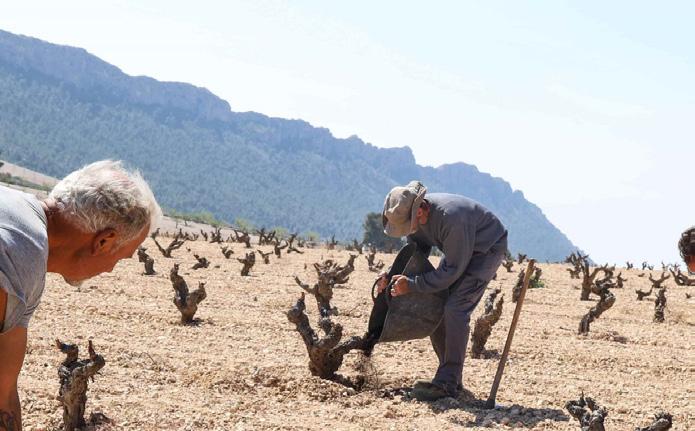
Spain: Juan Gil

International Winery for Climate Action Gold – one of only six wineries globally.

Lebanon: Domaine des Tourelles

Switched totally to solar power for vintage 2024, to provide energy security in such a challenging location.

South Africa: Waterkloof

The Western Cape’s first WWF Conservation Champions, with a plan to enact regenerative practices.

South Africa: Daschbosch

Members of the Old Vine Project, a guardianship of historic vines.
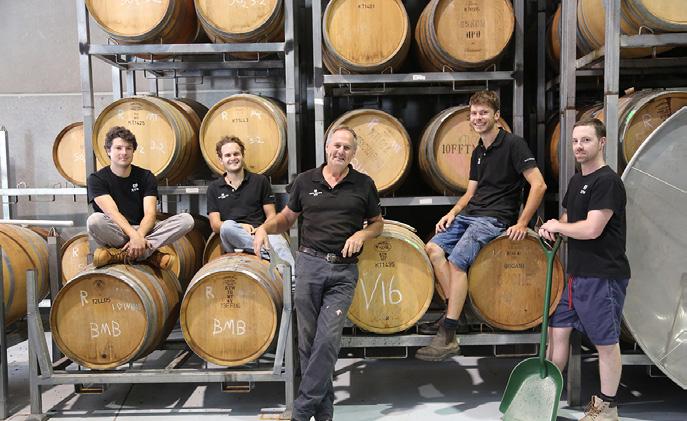
Australia: Keith Tulloch

A Climate Active winery, one of the most rigorous carbon-neutral certifications globally.
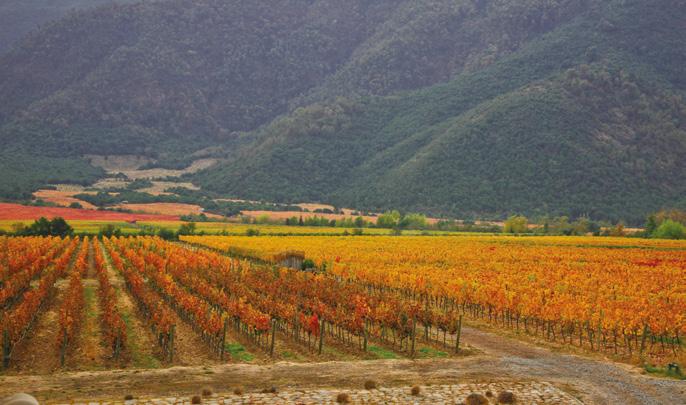

Chile: Emiliana
B Corp, Fair Trade, biodynamic, organic, ROC (Regenerative Organic Certified).

USA: Shannon Family of Wines

The latest addition to the US portfolio is one of the country's largest certified mountain-grown vineyards.
Consumers demand more sustainably-made wines, and recognise that involves a premium
Talk to most people working in the wine industry today and you will find a consensus that working sustainably is a genuine win-win, with any short-term costs in the implementation of sustainable practices (from transitioning to solar-powered wineries and electric delivery vehicles to changing packaging and wastewater management and recycling systems) ultimately recouped in longerterm cost-savings.
Talk is one thing, of course, acting on it quite another, and it would be naïve in the extreme to suggest that wine trade practice always dovetails with theory, or that cynicism (greenwashing) and shorttermism with regards to sustainability aren’t still rife in this sector as in every other.
One powerful counterbalance to complacency and bad faith are changes in consumer behaviour and, according to research published in September by the wine PR and communications firm Wine Lister, consumers, notably those prepared to pay higher prices for wine, are providing a powerful incentive for producers to switch to more sustainable practices.
The research – which was based on
a survey of 48 key industry members who, according to Wine Lister, between them represent “well over a third of global fine wine revenues” – shows that there is considerable “market demand for sustainable wine production”, as “increasing environmental concerns have led to a greater consumer demand for ecofriendly products.”
Importantly, however, there is something of a lag between trade and consumer perceptions of the best way to reward conscientious producers, with the trade rating more holistic “sustainable” certifications such as High Environmental Value and concrete targets such as carbon neutrality as more significant than the consumer’s favoured measure, organic certification.
As one anonymous UK specialist retailer quoted in the report says: “Consumers are motivated by eco issues but don’t understand all the implications. They may, for example, be familiar with terms such as ‘organic’ but ‘HVE’ is too complicated.”
With a groundswell of producers now choosing sustainable certifications (the Wine Lister report says 50% of Bordeaux’s vineyard area had been certified HVE by
2022), it may only be a matter of time before consumers follow the trade. In the meantime, the organic sector is on course to grow by 10.5% between 2024 and 2030, the report says.
No matter how the demand for sustainability is regulated and communicated, it’s clear that the wine trade believes consumers are prepared to pay for best practice and see a correlation between quality and sustainability.
“More than 95% of respondents believe that a price increase could be brought about by the adoption of eco-friendly practices, suggesting a positive correlation between sustainability efforts and perceived value,” the report says.
Or, as one “top-tier South American importer” puts it: “In general, many of the most reputed wineries in the world, including Bordeaux, already follow environmentally-friendly practices in the vineyards. This is expected of them by the higher-end consumer, who tends to view these initiatives as contributing to the final quality of the wines.”

Paul Pujol’s winemaking travels have taken him across France and to the USA – experiences that have only strengthened his belief in organic viticulture and a sustainable approach to all aspects of his work.
“In parts of France you’ve got generations of scorched-earth farming and heavy fungicide use,” he says. “If you’re standing in a vineyard where the only thing growing out of the ground is a vine, then the only thing that can survive in that environment is something that preys on grapevines.
“You end up in a situation where disease pressure becomes progressively much higher over time. As well as seeing a decline in vine health, you end up with these anaerobic soils that remind me of a Roland Garros tennis court: there’s almost baked concrete surrounding the vines. Of course, over time, those vineyards will really struggle, and fall over.”
Pujol oversaw a transition to organic viticulture during his time heading up the Kuentz-Bas winemaking team in Alsace. At Lemelson Vineyards in Willamette Valley, Oregon, his next permanent role, organics had been part of the philosophy since the beginning.
Now back home in New Zealand, where working sustainably is second nature to many winemakers, he’s loving life in Central Otago at Prophet’s Rock.
“As a head winemaker, I’ve only worked in cool climates, so I always enjoyed that challenge and working in regions where you really do win and lose in the vineyard,” he says. “You know the consequences of getting it wrong and just not getting ripeness, for example, and you can’t fix that in the winery.”
Pujol observes that “if Central Otago is ever pushed out of cool-climate grapes, then basically the rest of the world must be on fire”. Surrounded on two sides by cold seas on the 45th parallel, the region should

New Zealander Paul Pujol, who has always been drawn to Pinot Noir and the aromatic whites of France, joined Prophet’s Rock after a six-year around-the-world odyssey. His winemaking style is site-driven and aims to express a unique sense of place
really be too extreme for vines of any sort. But the Southern Alps shield it from wind and rain, creating an arid, semi-continental climate where days can be warm but nights are cool – good conditions for viticulture.
Prophet’s Rock Pinot Gris 2021
It’s an environment that suits Pujol’s hands-off winemaking style down to the ground. “If you’re in a marginal climate like Central Otago, it really is all about what happens in the vineyard,” he says
“The key thing with the aromatic whites is they're 100% wild ferment in old barrels, not stainless. I don’t have the big foudres that I had in France, but old neutral barrels. Fermentation takes six months. Then I’ll leave the wines in barrel on lees until just before the next harvest. No bâtonnage or anything. What you’ll see is the wine becoming much more harmonious over that year, and the acidity integrating into the wine and becoming seamless, which is really important.”
Prophet’s Rock Rocky Point Pinot Noir 2021


“Rocky Point is a blend of Pinot parcels from the two sites that are on schist. I’ve tried to capture very pure expressions of site, as opposed to a very pronounced house style. Everything’s wild ferment; we’re very careful with new oak, and crucially there’s very low extraction. Our Pinots are only hand-plunged once for the whole time they’re in tank, so it’s more a sort of infusion approach. Rocky Point makes Pinots that are really engaging: there's a lot of energy to them, really bright aromatics and sort of crunchy berry fruit, finishing with a little bit of salinity and graphite.”
Prophet’s Rock Antipodes Red 2021
“I met François Millet when I worked the 2009 vintage at Domaine Comte Georges de Vogüé, where he was the winemaker for 35 vintages. We started working together in New Zealand in 2015. He comes out and makes the same small parcel of Pinot Noir every year and the same parcel of Chardonnay. He didn’t come in with a fixed idea. Following the ferment and how that parcel behaves, he settled more or less into just hand-plunging it once during fermentation, followed by two winters in barrel and bottling unfiltered. François is a huge advocate of the region and really enjoys showing people in Burgundy the wines that he makes with us.”

Tanguy Castillon, aged 27, has been instrumental in converting his family’s Château l’Ermite d’Auzan estate to full biodynamics, with the blessing of his father Jerome. He’s recently been distilling lavender, lemongrass and thyme – all grown on the 75ha estate on the south side of the Costières de Nîmes –emulsifying the mixture with milk and water and spraying it on his vines to combat mildew.
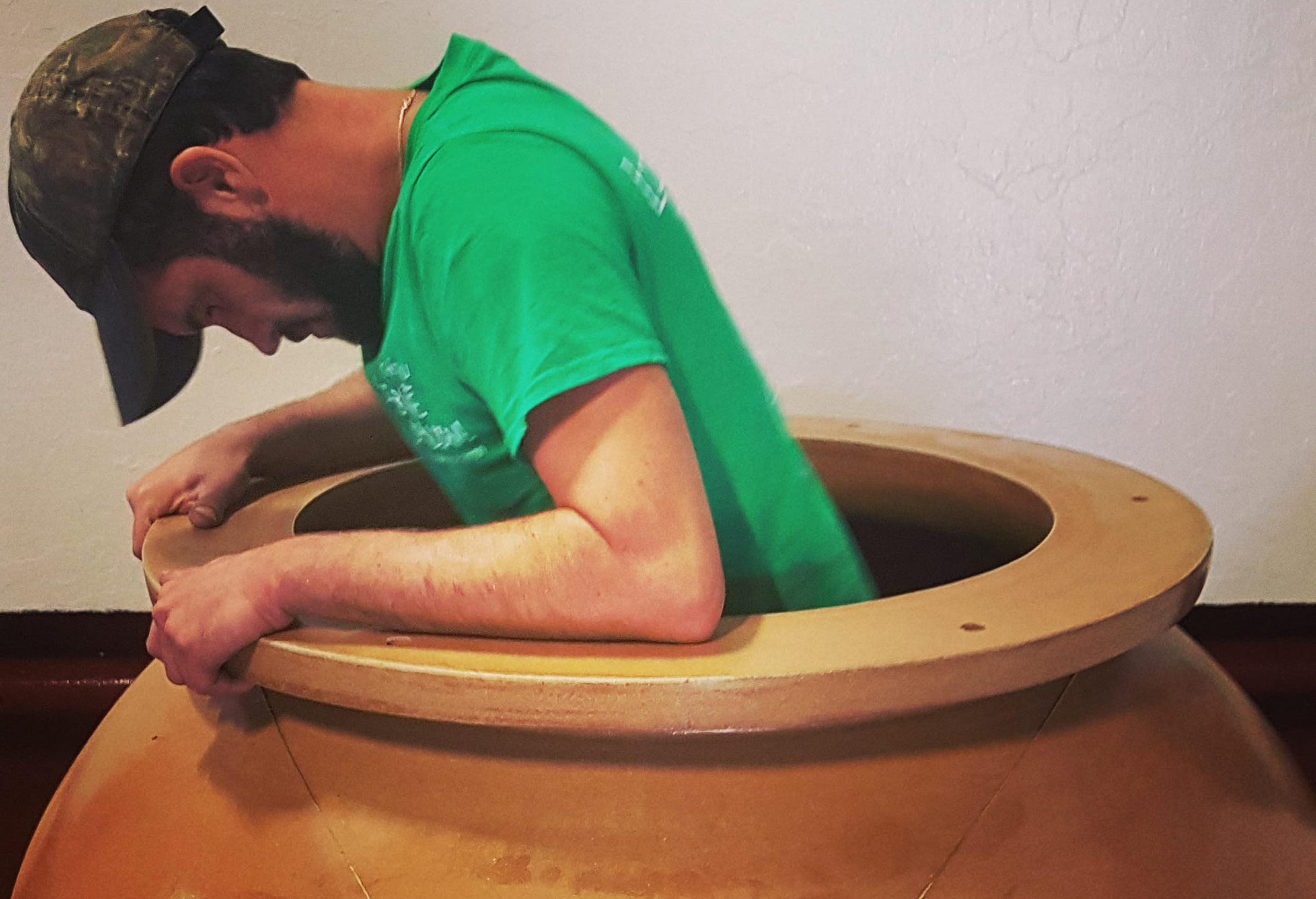
Sustainable wines from Barton Brownsdon & Sadler
Family run by siblings Tomás and Sofia Groppo Parisi, this 61 hectare winery is located in San Patricio del Chaña. The vineyards are managed carefully using irrigation systems and applying a compost of leftover grape pomace and stalks from harvest. The estate will be certified organic from 2025.
Rebel Chardonnay is unoaked. Citrus and stone fruit on the nose with delicious minerality on the palate. Vegan friendly.
RRP £15.95

Currently in their third and final year of transitioning their vineyards to organic, siblings Tomás and Sofia Groppo Parisi favour a low-intervention approach, manual pruning, supporting local biodiversity to manage pest control and using indigenous yeasts to create a snapshot of the terroir in a glass.
Rebel Pinot Noir is elegant, with lots of red fruit aromas and a hint of liquorice. Vegan friendly.
RRP £14.99

Owned by the same family for five generations, today the 25 hectare estate is run by Alexandra Berthet-Rayne and her family. They are deeply committed to a natural approach and were certified organic in 2011 and have been members of Biodyvin since 2021.
With an average vine age of 60 years, this Cairanne is expressive and structured. Warming cocoa and spice adds definition to the earthy and complex fruit. Vegan friendly.
RRP £25.00

The Lanchester Group is on a mission to future-proof its business. Renewable energy, lighter bottles and bulk shipping of wine are all helping to make that possible, as founder Tony Cleary MBE explains
Sponsored feature
It was back in 2008 that The Lanchester Group set out on its sustainability journey. “It all started with our office block,” explains chief executive Tony Cleary MBE. “We put 41kW of solar panels on our roof, which in the summer generates all of the power that we use in the office.
“You don’t have to be a brain surgeon to figure out whether that is a good choice or not. Even back then, when solar was much more expensive and less popular, we just felt it was the way to go.”
He adds: “The UK has 40% of all of Europe’s wind assets and we are based high up on a windy hill in Durham. The wind speed is really good here. Anything above 5m/s is great for wind turbines. Ours is 6.2m/s, so from 2012 to 2014 we built three wind turbines that generate around 4.5 million kW/h of renewable electricity per year.
“Our new bottling facility, Greencroft Two, has 3 megawatts of solar fitted to the roof. This generates around 2.8 million kW/h of electricity, so all in all we generate around 7.5 million kW/h of renewable energy a year.” To put those figures into context, that is enough to power over 2,500 three-bedroom houses for a whole year.
Could independent wine shops also go the solar route? Wouldn’t they be too small? “No, I think that is a common misconception,” says Cleary. “Anyone can put solar on their roof. I don’t agree with filling fields with solar panels. There’s millions of square metres of roofs in the UK. That’s where our solar should be and indies can be a part of that. They have fridges that run through the night: a small solar energy system would cover all of those needs and more. It will help them big time as energy prices have become more and more ridiculous.

“It’s not just about saving money, though. Anyone millennial and younger is heavily into sustainability and that is where the indie customer base is heading now. It is an opportunity to show a commitment to the whole ethos of sustainability”.
Generating renewable electricity only scratches the surface of The Lanchester Group’s approach to sustainability. Another important driving factor is bulk wine shipping.
Cleary says: “One 20ft container with a 26,000-litre flexi-tank of wine equates to two and a half 40ft containers of wine shipped in glass bottles, so you can imagine where the saving is there.”.
And bulk shipping isn’t just more cost effective: its carbon emissions are also far lower. “For every kilometre travelled, in flexi tank rather than glass, it saves 2kg of carbon,” Cleary says. He also argues the

flexi-tank shipping can result in wines arriving on shelves in better condition. “Everything from the southern hemisphere needs to cross the equator, which can get up to 35-40˚C,” he says. “When wine is shipped across the equator in flexi-tank, the temperature moves minimally, by about one degree or so”.
Lighter bottles and alternative packaging are also major aspects of The Lanchester Group’s sustainability model. Cleary says: “I believe ultra lightweight glass is the future. Our bottle supplier Verallia has just recently released a 300g bottle, which is brilliant.
“For every [24,000-litre] flexi-tank you save 3.2 tonnes of glass by using this bottle compared to the standard 400g bottle.”
Canned wine also has the potential to make a huge impact in terms of sustainability. Cleary says: “Ninety per cent of cans are recycled, but not only that, a 187ml can weighs 11g compared to 160g for a glass bottle of the same size.
He accepts that “indies have been slow to adopt cans”, but believes “they could be a driving force in changing the image problem with alternative packaging”.
In an industry where sustainability is the buzzword on the tip of everyone’s tongue, it can sometimes be hard to separate the box-tickers from the trailblazers. But Cleary is confident that The Lanchester Group is one of the genuine leaders.
“We want this business to be futureproof for the next generation,” he says. “Realistically, in the drinks industry nobody can touch us on sustainability: we are playing cricket and everyone else is playing football somewhere else, we are that far ahead. It’s the best thing we have ever done.”
Restoring a rare ecosystem in deepest Provence is, arguably, its own reward. But last spring, when Château Galoupet Cru Classé 2023 was given Bettane & Desseauve’s bestever rating for a Provençal rosé, it was a moment that vindicated the faith and hard work of estate director Mathieu Meyer and his team.
The wine, the first from the estate to be certified organic, was awarded 97 points and came out on top of a line-up of 86 other rosés from the region. A blend of Grenache, Tibouren, Syrah, Rolle, Cinsault and Sémillon, it wowed critics with its yellow peach and floral aromas, exotic notes of mango and fresh pineapple and hints of citrus.
How do you create a wine this special? The story starts in 2019, when LVMH bought Château Galoupet, a 170ha property beside the Mediterranean, most of which was – and remains – covered by trees. It was not a typical purchase for the luxury goods giant, which usually looks to acquire businesses that have already achieved a high level of consumer recognition. But there was something about the place – a lieu-dit in its own right, appearing on maps from the time of Louis XIV – that persuaded the company that great things could be possible.
“At the time, Château Galoupet was not well known, and the estate was not in great shape,” says Meyer. “We didn’t have the myth of the founder – no Madame Clicquot, no Mr Hennessy. So what were we going to do with our new acquisition?
“When we came on site, it became quite obvious what the direction should be: to take care of this amazing place that we have here. By doing that, you’re going to make it possible to craft exceptional wines.”
Making great wines was the first of two “pillars” that the team focused on. “The second pillar was sustainability,” says Meyer. “Everything that we do is aiming towards lowering our impact on the environment, and making our estate in a
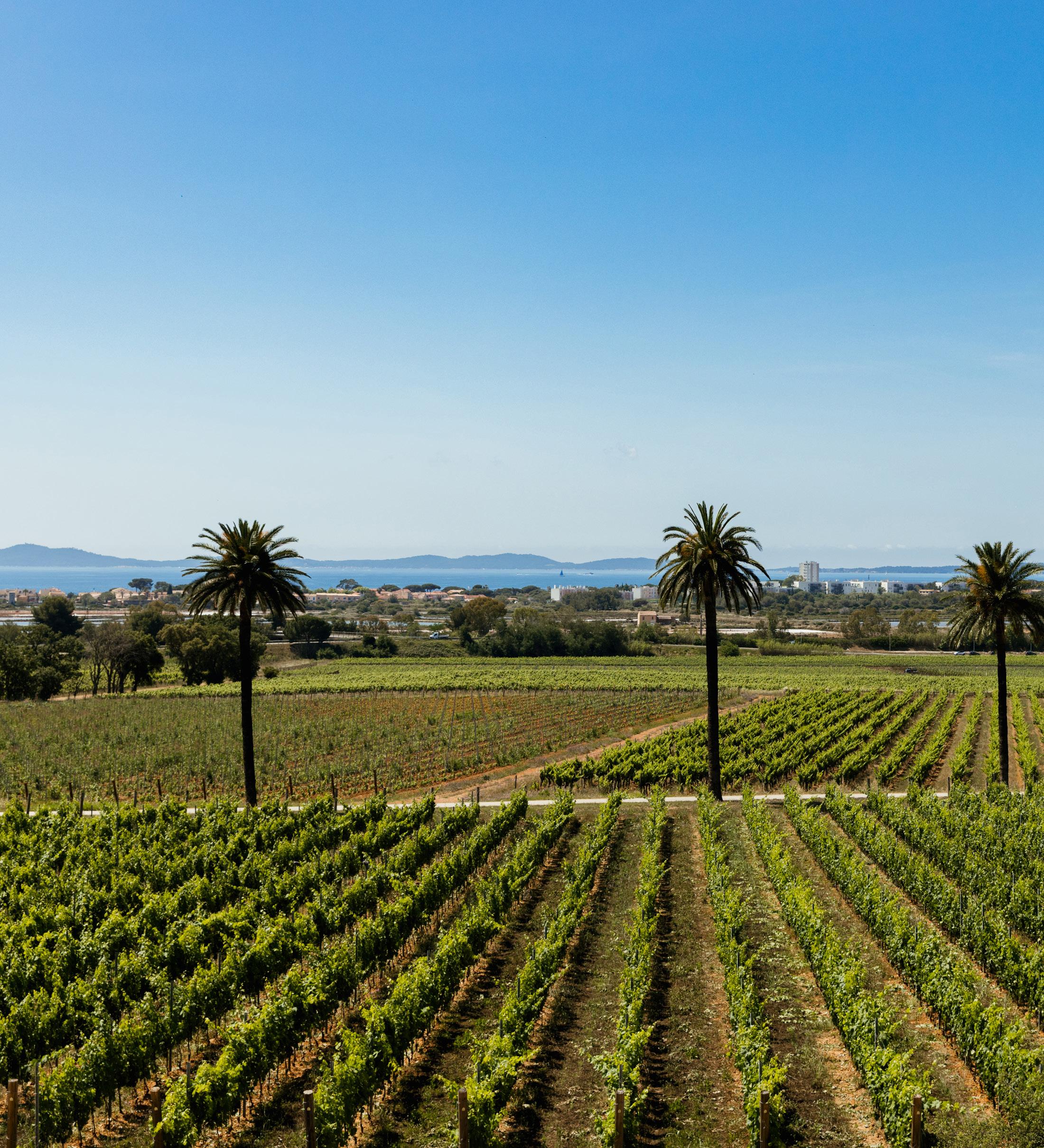
Château Galoupet has been named Provence’s best rosé, vindicating the work ecosystem of the property. Its wines are sold by Moët Hennessy Wine Estates,
better condition than it was when it was acquired.”
Meyer explains the geography of the property. “We have all the vineyard in one block south of the property, and all the woodland in one block north of the estate, and this creates a giant ecosystem,” he says.
“I think that’s what makes Galoupet interesting and quite particular.”
Ever since the purchase, the estate team has been experimenting with ideas in the vineyard as well as in the woodland, often with the help of outside experts.
“We’ve been working with ecologists to tell us what type of species we have in the protected woodland and, even more importantly, what type
of habitats we have there, to then tell us what we can do to make it better,” Meyer says. “We have to make the habitat right

Château Galoupet Cru Classé Organic 2023 RRP: £46.50
This is a limited-production, fine Provence rosé with a difference: a meticulous plot-by-plot approach and partial ageing in 600-litre demi-muids create a consistent and layered wine. Its silky structure and aromatic concentration make for a perfect winter foodpairing experience, from a simple charcuterie board to a full Sunday roast. The first 100% certified organic vintage is now available to the UK independent trade.
Sample bottles are available to 100 Wine Merchant readers. Claim yours by emailing Alexandra Dzurik: adzurik@moethennessy.com.

work that went into restoring the Estates, Ellis of Richmond and Enotria&Coe
and then hope that life will come. That’s true for bigger animals: birds, mammals and whatnot. It’s even more true for micro-organisms, which represent true biodiversity.
“If you speak about plants and animals at Galoupet, you’ll be talking about a few hundred species. If you talk about bacteria, micro-fungi, you’re talking about literally thousands of species which cannot be seen, and the only way to increase their population is to improve their habitat.” Helped by the right cover crops, the bacterial population in Galoupet’s soils has multiplied by as much as 30.
Managing the estate’s flora is also a major project. “We’ve removed a few of the plants which are not native to here. Mimosa, for instance, which is an invasive species and able to colonise habitats very, very quickly,” Meyer says.
“We will be actively replanting trees, mainly focusing on species from here, but also species which are living today in the south of Spain, Portugal, north Africa. We know that those guys will arrive eventually with climate change. We know as well that eventually some of the natives will die, so we want to make sure that between the time when the native dies and the newcomer arrives, we have something happening here. Otherwise there might be a gap where there is just nothing on the protected woodland, and we cannot allow that to happen.”
As the Galoupet team has developed an intimate understanding of the property, and as diseased or missing vines have been replanted, it’s been possible to divide the estate into 41 separate vineyard plots across three micro-terroirs. The soils, mainly sandstone and schist, vary in their physiological make-up as well as their depth and elevation, which decides their suitability for each grape variety.
“Grenache that we’ve planted in one place will not express the same characters as the Grenache that we have in a different place, because the soil and the plot are so different,” Meyer adds.
“We are obsessed with keeping those unique personalities all the way down to the final assemblage. Each plot will, of course, be cultivated separately, but also harvested separately and vinified separately. And the wines are kept separate until they are finally ready to be to be blended.”
Plots were once as large as four hectares, but now one is the maximum. “We surround the plots with trees to make sure that there is not too much distance between the nearest tree and the centre of the of the plot,” Meyer explains.
From this year, visitors have been allowed into Château Galoupet to see for themselves the project up close. Consumers who aren’t so lucky can at least get a sense that there’s something special about the wine when they come into contact with the bottle.
It’s made with recycled amber glass which, unusually for a Provence rosé, gives no hint of the colour of the wine inside, and is 30% lighter than a typical bottle.
“We do a lot with the sequestration of CO2,” says Meyer. “All the plants, all the trees that we plant in the protected woodland are capturing CO2, as is all the organic matter that we put in the soil.
“We had to do something about the packaging, too, which is more than 40% of the CO2 emission of an estate. It’s a great point of discussion, actually, because when you show the bottle, people ask about the colour, and then you can start to tell them the whole story about Château Galoupet.”
The reception that the 2023 wine received must have been a cause for huge celebration in this picturesque corner of the Mediterranean coast. And yet Meyer is staying humble, and suggests it’s really just the beginning.
“It takes time to improve biodiversity,” he says. “It’s not going to come overnight. Just like a gardener, you plant things, but you can’t command the plants to grow. You just make the perfect conditions.
“But we know that it’s working. We know that it’s going to get better and better and make our wines better. But ‘better’ is quite subjective. What I’m convinced of, from a scientific point of view, is that it’s going to make our wines even more unique.”

Driving down from Montpellier airport to our first stop in Perpignan, the scale of the wine culture here is immediately obvious. Vineyards sprawl on both sides of the road; swathes of greenery engulf an otherwise rugged, austere terrain, with domineering rock structures bolting out of the orange earth like watch towers. And just as we’re taking in the striking charm of the landscape, any romantic musings are put to an abrupt end by a close call on the motorway with a manic motorhome driver. As we catch our collective breaths we arrive at Domaine Lafage, nestled in the heart of the Roussillon, 30 miles from the Spanish border.
With the Tramontane wind blustering in full force, we brave the conditions for a Catalan lunch, accompanied by a tasting of several wines from Lafage, a name with seven generations of winemaking history, dating back to 1798.
Despite the family pedigree, owners Jean Marc and Elaine are firmly focused on the
future, with sustainability and innovation at the very heart of what they do. Across their 300-plus hectare estate they have 140 hectares of cover crops seamlessly integrated between vines, as well as 70 hectares of unfarmed land, brimming with natural plant species and wildlife. They use a detailed precision viticulture map in conjunction with their six weather stations to gain an in-depth understanding of the needs of their dynamic estate.
Yet all this mightily impressive stuff is outperformed by their most recent innovation, Biochar. In collaboration with the University of Montpellier, vineyard manager Antoine Lespès is pioneering ways to “cultivate water”: urgent work in a region burdened so heavily by drought in recent years.
Green waste – such as vine cuttings, used wood and, in Lafage’s case, even processed sewage – is heated to 500˚C in the absence of oxygen to create honeycomb-like charcoal that is then milled and applied around the roots of the vines. It improves

the soil both physically and biologically, increasing its capacity to hold water and store carbon in a sustainable way.
Trials in Lafage’s regenerative vineyards are proving that this carbon-rich microsponge is having an indisputable effect, with the potential to shape the fate of drought-ravaged regions across the Mediterranean.
A favourite wine of the tasting is Cantaca 2022, which comes from that regenerative site. It’s a blend of Chardonnay, Petit Manseng, Chenin Blanc and Sauvignon Blanc, gleaming with freshness and energy, bringing such a pure, generous depth of fruit and minerality. It’s certainly not the style of wine you would expect from a water-starved vineyard, so the proof of the pudding is very much in the eating.
A few obligatory Instagram snaps later and we are back in the car heading north towards the Languedoc, the home of Gérard Bertrand. Arriving at Château l’Hospitalet, it’s not hard to see why this titan of southern French wines chose to build his resort here, in such a peaceful, breathtaking site brushed by soft salty whispers from the Mediterranean coast.
After briefly soaking up the beauty of the estate, we take the short trip down to the l’Hospitalet Narbonne beach club. The club is seasonal and due to be dismantled in a couple of days, but you certainly can’t accuse the place of feeling sombre. The tables are anchored with fresh tapas. and flagship Gérard Bertrand creations, such
If you were wondering what a winery in Star Wars might look like, here is your answer
as Cote des Roses, Gris Blanc, Orange Gold and easy, chillable red Le Chouchou, are flowing freely.
Next morning we head to Clos du Temple in Cabrières, home of the most exclusive and expensive rosé in the world. As we approach, an unassuming gate appears: small, painted in royal blue with the estate emblem crested in gold. We’re greeted by deputy director Bertrand Degat, whose admiration for this estate is clear: “Here we always make the best wine,” he says. He enthusiastically picks grapes for us to try, explaining how specificity comes from the unique, laminated schist and limestone soils.
Making our way up the slope, the winery begins to unveil itself, like a lighthouse watching over placid, glassy seas: an unforgettable image. Nearing the cellar, Bertrand picks a range of wild Mediterranean garrigue for us to smell and highlights the vast biodiversity on the site. Holm oaks, heather, olive trees, mulberries, broom, almonds, chestnut and fig trees all diversify this special estate.
Vineyard manager Benjamin Gadois takes over for a tour of the cellar. If you were wondering what a winery in the Star Wars films would look like, here is your answer. Polished, satin-black fermentation pyramids give the illusion of hovering as they stand to attention, and an iron fixture on the ceiling channels delicate flickers of natural light into the winery. All the while Benjamin smiles as he blasts dramatic music from his tablet through a cellar sound system.

vineyard, a space mindfully integrated with nature.
It’s a rosé so pale you might mistake it for white, with red grapefruit, lemon blossom, pomegranate, sweet ginger and flutters of vanilla. A real attack of freshness on the palate, with tight citrus and frozen berries, a precise spine of acidity and a salty, mineral undercurrent throughout.

As the theatre concludes it’s time to taste Clos du Temple 2022 in the artfully transparent tasting room overlooking the
Now it’s back to the Narbonne beach club for lunch. Gérard Bertrand himself speaks passionately about his connection with nature, homeopathy and biodynamics.
“I began suffering from liver issues in my 20s and couldn’t drink wine,” he explains. “For a Frenchman, that’s bad enough. But for a French winemaker, it was a disaster.
“I visited a homeopath, and his treatments changed my life.” Bertrand went on to apply this trust in nature with biodynamic winemaking, a concept he refers to as “homeopathy of the earth”. Results from his first biodynamic trial at Château Cigalus in 2002 were so convincing, in terms of the structure, longevity and energy he achieved in the wines, that today
all 16 Gérard Bertrand estates are certified biodynamic.
Our final day includes a visit to Château Villemajou, an estate of huge historic and emotional importance in the Gérard Bertrand portfolio. It was the favourite estate of his father, Georges Bertrand, and the first estate that he harvested as a 10-year-old boy. Home to centurion Carignan vines as well as old Syrah and Grenache, the yields can be as low as 25hl/ha in the case of the top wine, La Forge, resulting in densely concentrated fruit.
Despite the ongoing harvest, the place feels so poised; a sense of harmony has been a reoccurring theme at all three estates. Perhaps a synergy of time, place and producer that can only be achieved through biodynamics?
This trip has highlighted a thirst for innovation in Languedoc-Roussillon. Through the eyes of two dynamic, forwardthinking producers we have seen an instinctive willingness to connect with nature and unleash some special terroir. Their efforts are being rewarded with some world-class wine.

A four-day buying trip to one of Spain’s most diverse, and dynamic, wine regions makes a lasting impression on our travelling group of indies
By Graham Holter
It’s said that Navarra is a province that encapsulates Spain in miniature, ranging from its breezy, mountainous north to desert conditions in parts of the south. Its wine culture is, consequently, pretty diverse. But if there are unifying themes, they are freshness, and a value for money that can sometimes make you doubt your own maths.
Our visit to the region, courtesy of the Consejo Regulador, involved visits to 19 estates and wines from around 30 producers. Itineraries as intense as this can exhaust minds, bodies and palates, so it speaks volumes that the five merchants who made the journey returned home bleary-eyed but with a keen desire to bring Navarra to life in their shops and bars.
In the mind of the Spanish consumer, Navarra is associated with its famous rosado wines, which appear almost fluorescent red in the glass and are a winning food match, especially in the warm months. In the UK, the region isn’t weighed down by any preconceptions. It’s familiar to tourists who have experienced the hedonistic delights of Pamplona or the scenic glory of the Camino de Santiago, a medieval pilgrimage route stretching from the Pyrenees to Galicia. But the British are open-minded about Navarra’s wines.
Navarra’s proximity to the juggernaut of Rioja is a subject that can’t really be ignored. Indeed the river Ebro flows through both regions, and much of their respective vineyard areas are contiguous. One winemaker we visit even points out that the boundary line runs through one of his walls. But it’s a mistake to think of Navarra as Rioja’s junior partner.
Garnacha, rather than Tempranillo, is Navarra’s stand-out red variety, making gastronomic wines with the sort of fruit/ acidity ratio that so many independent wine merchants, and their customers, seem to crave. It responds well to oak, especially French, though we encounter some American over the course of our fourday visit, and even the occasional barrel bearing the Navarra stamp.
The roble style – sometimes referred to as semi-crianza – involves just a few months in oak. The wines are easy to like, especially served slightly cool, and are a natural by-the-glass option.
Many of the most memorable reds we discover are blends. The Navarra ingredient list includes Tempranillo, Graciano and Mazuelo, as well as Cabernet Sauvignon and Merlot. This fusion of local and international varieties can create thrilling wines that some merchants
describe as a coming-together of Bordeaux and Rioja – a style that Navarra has made its own at both crianza and reserva levels. Syrah, another variety that has crossed the Pyrenees, can by itself produce intense, concentrated wines with silky black fruit. Its contribution to blends is striking.
Navarra is producing some inspired entry-level whites at ex-works prices of around €2 or €3, offering a freshness, texture and depth of flavour that often goes beyond what might be expected for that kind of money.
If Garnacha Blanca has a reputation for flabbiness, it’s a slander in Navarra, where the wines have zip as well as richness – indeed one producer tells us he ages a portion of his wine in barrel to moderate acidity and enhance mouth feel. We taste a racy example from the northern extremities of the region – what might be described as a mountain wine – which spends three months on lees. It’s brimming with notes of camomile and white flowers. There’s some decent Sauvignon to be found, a smattering of Viognier and Viura, and Malvasia pops up in the occasional blend. But it’s Chardonnay that makes the deepest impression, especially wines

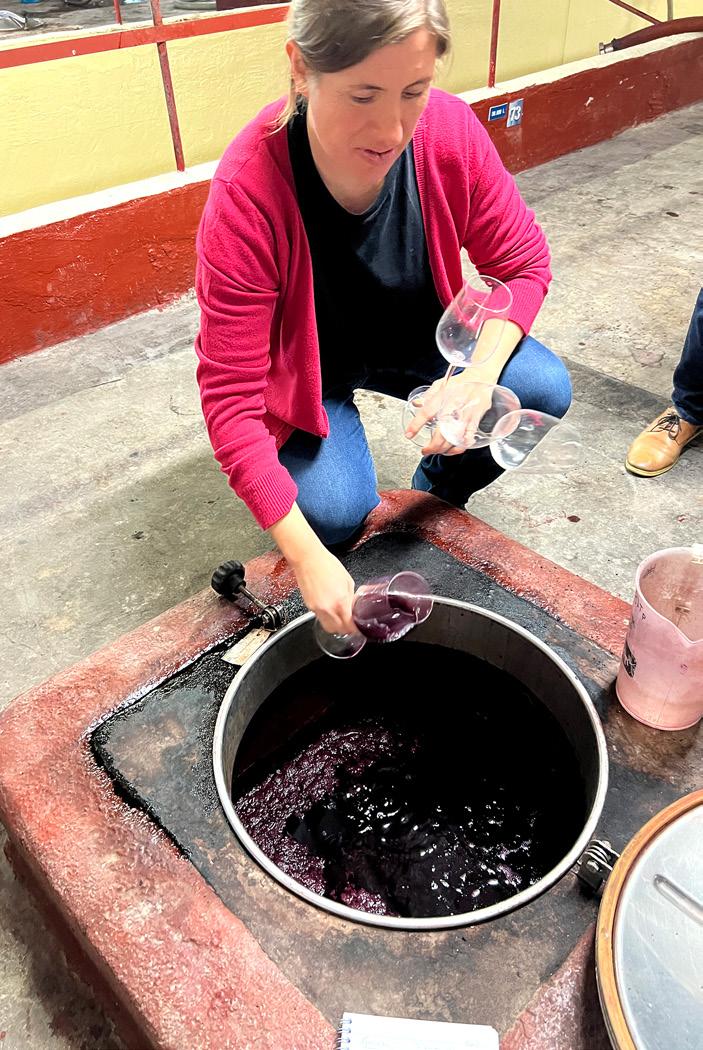

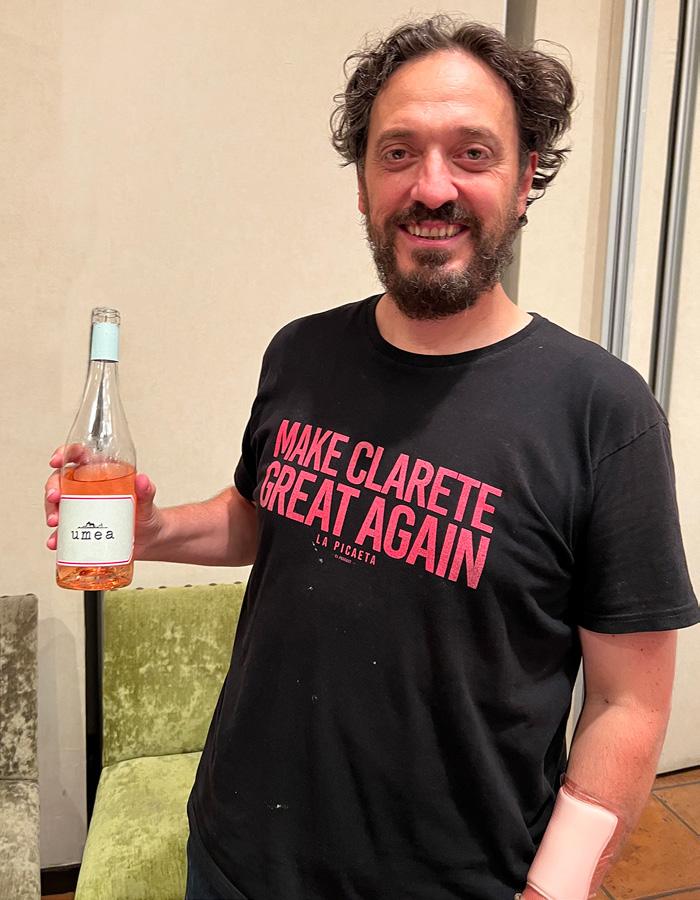



that have spent time in oak, often during fermentation as well as maturation, though malolactic is not the norm. We are poured examples that have a simple, uncomplicated appeal and others that wouldn’t be embarrassed in the company of Burgundy at twice the price.
One of the advantages of visiting a wine region in the autumn is the chance to see (and hear) the juice fermenting. We taste a few cloudy tank samples of already-delicious Chardonnay that’s almost reached its final alcohol level: it seems clear that, although volumes are down, quality will be high for the 2024 vintage.
Navarra producers can appear a little self-conscious about their traditional rosado, which is renowned across Spain for its refreshing character as well as its gentle tannins. It’s made in the saignée method, with unpressed juice drawn off early in the fermentation process after enough contact with skin to impart a much darker hue than today’s rosé drinkers have come to expect, and a more robust character.
In the bottle, the wines are arrestingly red by comparison with Provence-template rosé, and to many consumers, who have not yet learned better, that will always imply sugary sweetness. So Navarra allows its winemakers to produce salmon-pink rosés if they choose, and many of these are excellent: those with some lees ageing for extra depth and texture win particular plaudits from the visiting merchants.
Yet the group develops an enduring affection for old-school rosados, despite (or perhaps because of) the hand-sell these usually require in the UK. Maybe,
Some Chardonnays we are poured wouldn’t be embarrassed in the company of Burgundy at twice the price

• Navarra has five DO zones: Baja Montaña, Ribera Baja, Tierra Estella, Ribera Alta and Valdizarbe.
• Navarra exports about 30% of its wine. Germany is its biggest customer, followed by the UK.
• Red wines account for 62% of Navarra’s production. Rosé wines claim a 24% share, and whites 14%.
we suggest, the way forward in store is to market them not as rosés, but as the palest of reds. It seems a shame not to embrace such an authentic and gastronomically versatile local wine style, which risks being bullied off wine lists by far less interesting pink wines that can come from almost anywhere. At least one producer we meet has already decided that 2023’s rosado will be its last. The market, it insists, has made its choice.
The producers we meet in Navarra share a quiet confidence about what they’re doing. There was a time, we’re told, when this wasn’t the case. Perhaps there was too much fixation on rosado; perhaps quality wasn’t quite as consistent, across all styles, as we found it to be in the
autumn of 2024.
When a region has as much diversity as Navarra enjoys, it can be a mixed blessing. The story gets complicated, perhaps a little messy, and it can be hard to form a general impression of what producers are good at, and what makes them distinct from their rivals in other places.
It’s the freshness and elegance of the wines that seems to be the most common theme in the wines, and a purity of fruit that signifies healthy vines, whether they grow at the higher latitudes and more northerly parts of the region, or in the flatter, warmer south.
Few of the vineyards we visit are yet certified organic, but really this is a technicality. There’s not much disease pressure here, and producers are not keen to spray: “The more chemicals you put into the vines, the more chemicals they need,” one grower observes.
During our visit we explore lovinglytended old vineyards where Navarra’s various varieties grow side by side, and hear stories of pre-phylloxera cultivars being nurtured back to commercial viability.
We don’t find any orange wines –perhaps the colour spectrum is already broad enough – but we are offered some clean, edgy natural wines and some electrifying pét nat. The Moscatos regularly stop us in our tracks. Not everything we come across can be labelled as Navarra, but even when producers stray beyond the classification of the DO, it seems that retaining a sense of place is always central to their ambitions.
At every level, and with every style, it’s the value for money that Navarra represents that leaves indies compiling import wish lists and eagerly exchanging business cards with producers. Even deploying the most pessimistic arithmetic, many of these wines would arrive on shelf at least £5 below better-known rivals, and in a style that consumers might prefer. Now is a very good time for independents to be discovering Navarra.

Merchants offer their thoughts on what they discovered in Navarra
Dan Leak
The Bishop’ Cave, Bishop’s Stortford and St Albans
We were treated to a huge range of wines, from fresh, light whites to delicately-oaked, interesting red blends.
I had not really appreciated the geographical proximity to Bordeaux, and how much of an influence the French style would have on the region’s winemaking practices. I had also not really appreciated the multitude of cooling influences, such as the wind off the Atlantic, and altitude from proximity to the Pyrenees. The combination of those factors was really obvious in the profiles of the wines. It was like Rioja and Bordeaux had a child: and that child was making fresher, more palatable wines than both of its parents.
I think Navarra definitely has a place on our wine list and on our shelves. Of course it will take a little push from us due it being a relatively unknown appellation. But it is a really unique region with some real quality and I don’t think it will be that difficult to convert our customers.
Our hosts’ authenticity, enthusiasm and genuine love of their craft was amazing to see and it has given me a huge appetite to return – and to get their wines into the UK.
Heather Smith
The Solent
I loved the darker rosados that are the signature of the region. I’d happily put some on shelf – or, better still, show them in a tasting alongside food to get customers to broaden their palates.
I was surprised by the freshness and drinkability of the red wines. Although most were pushing 14%-15% alcohol, the balance was definitely there. For me, red blends with the international grape varieties (Merlot/Cabernet) alongside Tempranillo stood out the most.

Navarra wines will definitely feature in our range of Spanish wines now. The reds are a great alternative not only to Rioja but also Bordeaux – which are key buying areas around Christmas time for our shop. I think the white wines will also be received well, offering something different from Spain (not just Albariño/Godello/white Rioja) and great value for money. Customers also come to our shop to seek out a new wine style or region, so it will be great to use my knowledge to get behind this under-the-radar region.
I enjoyed the blends the most. The standout wines for me were the Irache Gran Reserva (Tempranillo/Merlot/Cabernet Sauvignon) and Tandem Macula (Cabernet/Merlot), which was like a top left-bank Bordeaux for a fraction of the price.
I had no preconceived ideas about what to expect, but I guess I was surprised by the overall quality of the winemaking. I don’t think we tried a “bad” wine all week and each of them was well made.
Navarra wines will definitely play a part in our range in the future. The quality and value on offer are really appealing and I can’t wait to share them with our customers.
I was blown away by the variety of very good wines, from cool-climate Chardonnays that rival Burgundy to bold but fresh reds that drink somewhere between Rioja and Bordeaux. Garnacha was the star of the show, though, displayed differently in young and fresh styles, old vine and rosé. The complexity they got into some of the young wines, at what would be a very good price in the UK, blew me away and made me wonder why we’ve never stocked them.
Rosé is obviously what Navarra is famous for: dry but a much deeper pink than what UK drinkers seem to expect. These are rosés with complexity and flavour, that I think we all agreed should be called light reds.
I want to import for the first time just because of the styles I tasted. Navarra has a strong part to play in my offering.
The wines I enjoyed most were the robles –such a lovely style at the bar and by the glass. A touch of oak, with fresh fruity Garnacha and Tempranillo: what’s not to like?
There’s definitely a place for at least a few reds, whites and rosés from Navarra on our lists. The food also makes me want to add more Navarran tapas to our small-plates menu. The wineries were all modern and clean, and the people all lovely and friendly. Definitely a wine region to watch and one for us as independents to publicise and push.

My team thinks of me as a Scrooge. I’m not – I just have strict Christmas rules

Idon’t want to sound like a Grinch. I do love Christmas, I promise, but I love it a week before Christmas, provided I don’t have too much stock/not enough stock/not enough staff, the usual level of insanity for this time of year.
I can feel the eyes of the team rolling hard at this point – they think me a Scrooge, determined to ruin their festive fun. I have a strict no-Christmas-musicuntil-Christmas-Eve rule in the shop and they’ve tried everything they can to get around it. I don’t need to hear Mariah Carey warbling any more than I am subjected to in the supermarkets. I think that this year they’re on the brink of a full-scale rebellion, though. I overheard them ask the new one how much she likes Christmas the other day, which doesn’t bode well for my ears.
Last year was bad enough. The window was painted by the artistic one (actually
there are two, but only one of them enjoys being in the window). She painted the Italian “Christmas witch”, who came out looking suspiciously like me, with what looked like my cat in tow.
Suddenly Christmas is marching towards us again. I’ve started thinking about the great Christmas rearrange.
I don’t know why I do this to myself, but every year I move the entire shop around to put the festive shit we barely sell during the rest of the year in a more prominent position. Unfortunately, I have tried some great wines in recent weeks from various
suppliers and, quite simply, there now isn’t enough room to bring a whole section into its prominent Christmas position without losing something else important to the “other shit” shelves.
I wonder why I keep doing this to myself, but it’s one of my many Christmas traditions, I guess. In order of timeline: I get angry at the lack of shelf space (I’ve entered this stage rather early this year), wonder how I’m going to deal with my problematic “wine magpie” tendencies, look sternly at the team every time they try to sneak on a Christmas tune, and try to remember that the “Christmas spirit” for someone working all hours is actually an early night and a healthy diet, not the caffeine-sugar-alcohol trinity that I have a habit of bombarding my body with.
What to do about my lack of space issue? So far my solution is to just selectively hide some wine. It’s not a great solution, but by Christmas Eve everything will be back where it belongs, ready for the desperate dash of the wild-eyed.
Talking of the desperate, one year we closed about 15 minutes late on Christmas Eve. I have a strict rule against this. The team deserves their family time, but it really was just too manic. We barricaded ourselves in the shop waiting for partners to swing round in their cars to pick up our own Christmas Day drinks before, in my case, a four-hour drive north.
By Christmas Eve everything will be back where it belongs, ready for the desperate dash of the wild-eyed
Two Desperate Dans, as we loaded the cars (a full 40 minutes after closing) were trying to get in. They were absolutely furious that I wouldn’t let them. “But we need wine for Christmas Day,” they whined. Well, dear readers, as we know by now, I have little tolerance for this kind of behaviour and pointed out that there had been seven whole hours of trading that day (and the preceding 23 days of December) before we closed. Add in a comment about the 250-mile drive to get to my family and suddenly there was no argument left in them.
So yeah, Christmas. Whooo.
Cat Brandwood is the owner of Toscanaccio in Winchester


As Familia Falasco celebrates its 85th anniversary this year, it’s recognised as one of the most important family producers in Argentina.
Condor’s South American specialism makes it well-placed to realise the full potential of Falasco in the UK market.
Franco Falasco says: “We started this journey together in the UK and it has been amazing. We trust Condor and thank them for the trust they have also placed in us.”
Winemaker Pablo Sanchez, responsible for all of Familia Falasco’s white, rosé and sparkling wine, introduces Los Haroldos Conejo Verde White blend. He says: “The objective with this wine is to attract and target newer, younger consumers with a different style of wine.
“It’s an unoaked blend of 50% Viognier, 30% Sauvignon Blanc and 20% Torrontes from vineyards at varying altitudes.
“The grapes are fermented separately and after that we do the master blend. It’s an easy-to-drink, fruity expression with a nice acidity that pairs perfectly with cheeses, light pasta and seafood.”
Moving onto Falasco’s Hermandad Chardonnay, Sanchez says: “This is from an awesome single vineyard in the Uco Valley called El Peral, located at 1,300 metres elevation in the foothills of the Andes.
“The style is inspired by both

Californian and Burgundian techniques. I have learned a lot about Chardonnay in my career and those regions have always inspired me. By combining these two philosophies, we have created a very pure expression of the Uco Valley. I will never change the site that makes Hermandad.
“For the oak used in Hermandad we only work with one cooperage based in Mercurey. We recognise the work of artisanal, family suppliers and they do a wonderful job with the barrels. This wine represents the hard work of many people.”
An Argentinian wine tasting is rarely complete without a Malbec. Presenting our first of the night, Sanchez says: “Bressano Malbec is the masterpiece of Falasco’s red winemaker, Alejandro Canovas. It’s a blend of three different vineyards at varying altitudes.
“The wines are vinified and aged separately for six months before creating the master blend. The final blend is then aged in a mix of 70% new and 30% old oak barrels for 18 months.” For Sanchez, “it is the purest expression of Malbec”.
From the Los Haroldos range, the Gran Corte is an impressive blend of Cabernet Sauvignon, Merlot, Malbec, Bonarda, Petit Verdot, Syrah and Tannat.
When asked how Falasco controls the extraction and structure of a wine

like this, Sanchez says: “It’s all about the blend; each variety is treated individually. They’re like instruments in an orchestra. Each instrument gives something specific and at the end you have a symphony.
“Cabernet and Tannat add the power, spice, tannin and structure; Merlot brings the herbal notes and roundness; Malbec and Bonarda add sweetness and a fresh red fruit flavour. Each variety is a player in a concert.”
Worth noting too is the Hermandad Winemaker Series Cabernet Franc for its potential with indies. It’s an extremely transparent and pure expression of the variety, juicy and generous with an artfully well-managed oak influence that doesn’t mask the trademark crunchy green freshness of the variety. This wine, like all the wines poured on the night, tells a story of its dramatic, high-altitude origins.
In association with
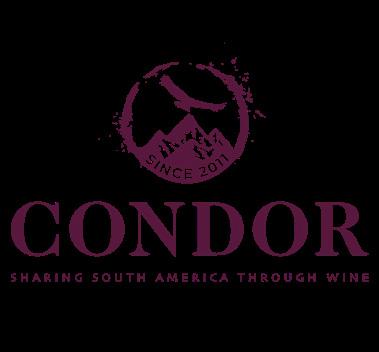
07715 671914
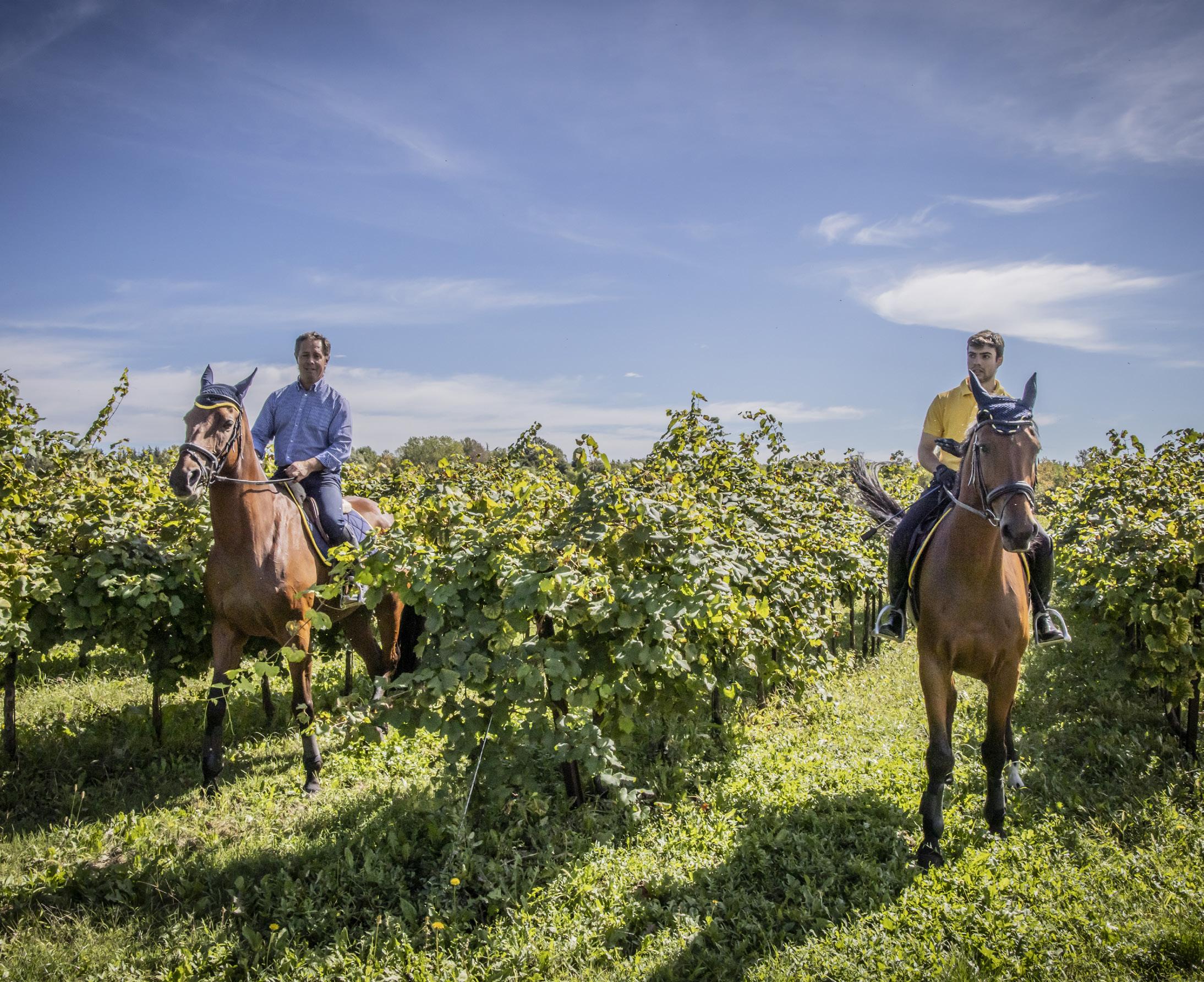
A Wine Merchant masterclass shows that the DOC wines of Prosecco have far more quality, and breadth of style, than independent merchants may realise
Prosecco DOC has been one of the UK wine trade’s biggest success stories in recent years. More of this affordable, crowd-pleasing fizz is shipped to our shores than anywhere else in the world. Volumes might not quite be at the peak they reached in 2021, but the 110.4m bottles exported to the UK in 2023 is more than three times the 2013 total.
It’s easy to think of this boom as essentially a supermarket phenomenon, but Prosecco DOC has made an important contribution to independents’ revenues too. For some, it fulfils the role of the midweek treat wine or the wholesale bestseller. And yet there is so much more to the category than this, as our guests were about to discover.
There is much to admire in the quality, food-friendly wines from Prosecco DOC,
most of which are only a few pounds more expensive than bigger brands in the multiple sector.
Since launching four years ago, Prosecco DOC rosé remains a relatively

undiscovered delight, though it’s a style that consumers generally seem to love when they encounter it. And with producers increasingly interested in organics, biodynamics and sustainability – as well as achieving impressive results with a spectrum of residual sugar levels –the category has never been more relevant to the independent trade.
Veneto and Friuli-Venezia-Giulia are the two Prosecco DOC regions, ratified in 2009, consisting of nine provinces: Belluno, Padua, Treviso, Venice and Vicenza in Veneto; and Gorizia, Pordenone, Trieste and Udine in Friuli.
The same year saw the upgrade of the Prosecco di Conegliano e Valdobbiadine DOC zone to a DOCG and regulations imposed to reduce yields in the newlydesignated zones, all part of a mission to
drive up quality. Now any wine produced in the region but outside the DOC regulation must be labelled Glera IGT and cannot be called Prosecco.
Glera is the grape that dominates production but producers can blend in up to 15% of Verdiso, Bianchetta Trevigiana, Perera, Glera Lunga, Chardonnay, Pinot Bianco, Pinot Grigio and Pinot Nero to make white wines.
The first Prosecco DOC rosé (the 2019 vintage) was released in 2020. “Pinot Nero content in rosé has to be a minimum of 10% and a maximum of 15%,” explains Neil Phillips, UK ambassador for the Consorzio Tutela Prosecco DOC.
“The Glera and the Pinot Nero for the first fermentation are fermented separately. The wines are blended for the second fermentation, which must be a minimum of 60 days.
“Rosé must also have the vintage on the label; it must say Millesimato, because it must contain 85% of grapes from the vintage declared on the label.”
Prosecco DOC wines are vinified using the Martinotti (or Charmat) method. in which secondary fermentation takes place under pressure in steel tanks known as autoclaves. An exception to this is wine that sees secondary fermentation in the bottle (essentially pét nat). There is also an intriguing still style, tranquillo, which is made in tiny quantities.
Phillips, who has a long track record in the UK wine trade, has been working with the Consorzio for a decade and says he has seen a lot of change. As well as focusing on continued quality and consistency, the region has embarked on a number of research projects and embraced experimentation. The launch of Prosecco DOC Rosé in 2020 is a high-profile result of such investment.
“Glera’s high acidity and lower alcohol levels makes it ideal for sparkling wine, but it’s not a very aromatic grape variety,” says Phillips. “So it’s really important we get as much expression as we can.
“Prosecco occupies lots of spaces, from the bottomless brunch to a refreshing aperitif, but there is so much more in between”
“We’ve more producers coming in, doing great stuff and with more variation. As part of our Glera project, established in 2019, we’ve collaborated with the University of Padua looking at, for example, different soil characteristics, precipitation, trellising, canopy management and how Glera performs across the regions. It’s a balance to get the aromatics as well as the right acidity.
“We are identifying the best areas within the DOC to promote the best viticultural techniques for Glera, in pursuit of oenological and environmental goals.
“Other grape varieties are being examined: local ones like Perera, Verdiso and Bianchetta Trevigiana, and others resistant to vine diseases, obtained through crossing, to better understand the qualitative effect on the product after blending and the sparkling process.
“For this purpose, we worked with the Veneto region’s farm, Veneto Agricoltura, to create two trial vineyards, in the plain and in the hilly area, in order to introduce regulations for good vineyard practices with the new grape varieties. This means we’re safeguarding the sensorial characteristics of Prosecco and ensuring production is sustainable. It sounds obvious, but you have to plan ahead.”
It becomes evident to everyone that Prosecco is a dynamic DOC.
“Prosecco is not stopping,” says Phillips. “Our four biggest markets are the UK, US, Germany – and next, perhaps surprisingly, is France. And many more countries are knocking at the door.
“Prosecco occupies lots of spaces, from the bottomless brunch to a refreshing aperitif, but there is so much more in between. I do think restaurants could be doing more and that’s why it’s important to demonstrate how well the different styles pair with food.
“There’s a whole range of people who like Prosecco, so it’s not like you’re selling to a narrow demographic. I’d like to see people from the trade going out to visit producers and actually discover what’s going on for themselves.”
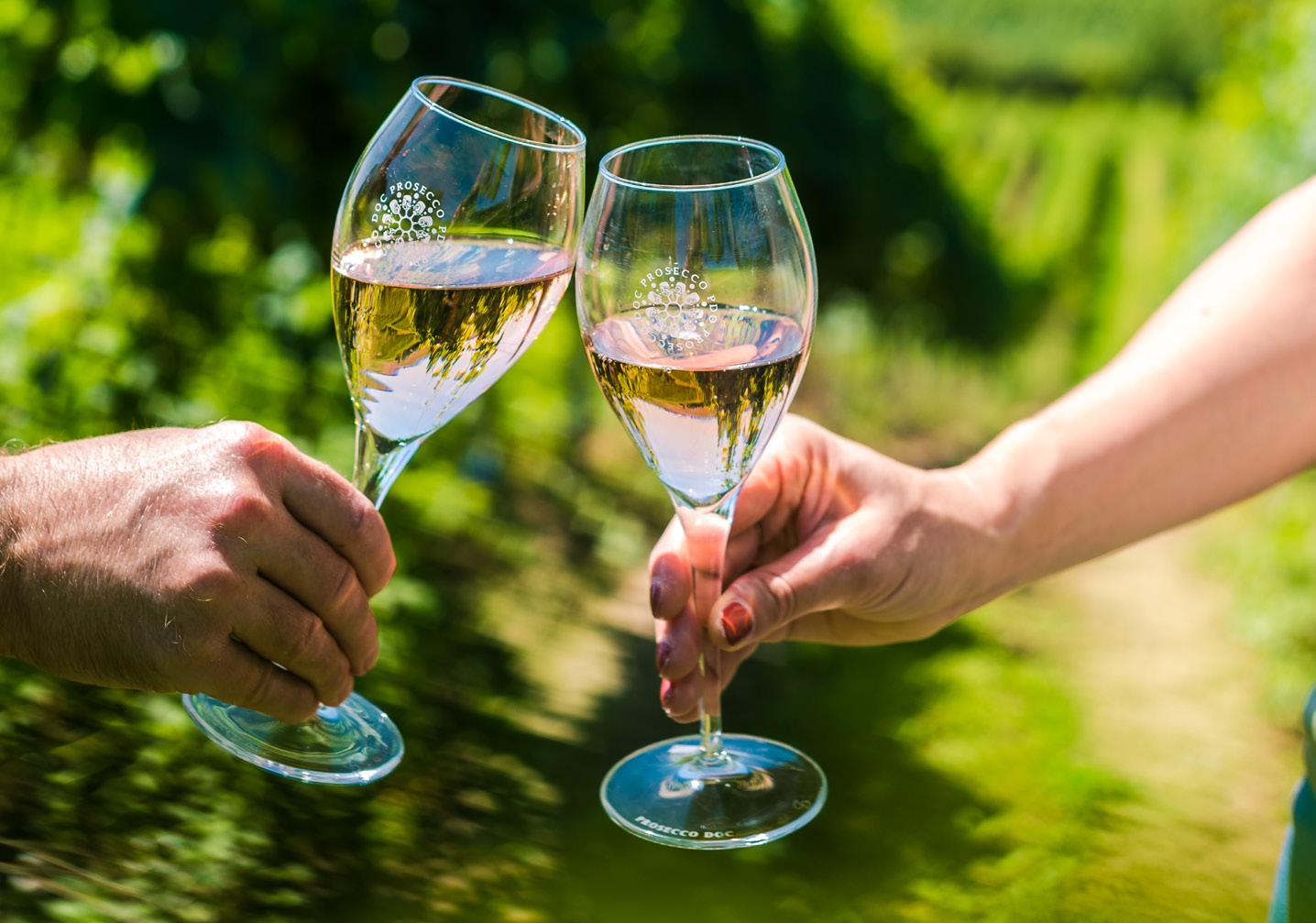

Cat Brandwood Toscanaccio, Winchester
I think people moved away from Prosecco a bit in the past five to 10 years, perhaps because it had become so popular. Particularly my monied clientele who are not scared of drinking Champagne. But there are people who actually want to drink something that isn't Champagne, something that is that little bit fresher and fruitier, and there’s been this kind of boomerang effect back to Prosecco for that reason.
Customers are very, very keen on making sure that they’re getting good-quality Prosecco. People are more interested in organics now, so an organic Prosecco will sell twice as much just because it’s organic. They are starting to understand what DOC Prosecco is and they know that DOC is the one they should look for because they’ve been to a wine tasting where someone’s told them that, and that’s the only thing they’ve remembered!
Pink is massive so I think the launch of Prosecco rosé is something that has really helped to get consumers back into the category. At £15-£16 for a Prosecco rosé, I’d sell shedloads.


Ellie Buckley
Noble Green Wines, south west London
My impression prior to the masterclass was that Prosecco was an easy and reliable wine to go for. But it opened my eyes to what Prosecco can offer. The extra dry Proseccos that we tried, for me personally, could easily compete with some Champagnes and the rosé Proseccos really add another layer. I think for the extra dry ones that come close to Champagne, consumers can be persuaded to spend an extra few pounds. Unfortunately, because of the reputation Prosecco has, especially with the likes of bottomless brunches, it might take some selling. However, who doesn’t love a challenge?
The extra dry wines were my personal favourites, both in the white and rosé. It was a lovely masterclass.

Lucy Wright Buchanan’s, London
Before the masterclass I felt that Prosecco had been on a bit of an arc from being seen as a sophisticated but accessible sparkling wine to becoming a victim of its own popularity, resulting in some variable quality available on the market with a focus on low prices, particularly in supermarkets.
The popularity of Aperol spritz has moved Prosecco into being just considered a mixer, which is a shame really. However, I was aware that there were great examples out there to be enjoyed and had been to visit a producer in the region a long time ago, so I was excited to rediscover a love for the wine and learn something new.
Andrew Gray Plume, Finch and Quill, London
We’ve all sold a lot of Prosecco over the years. The other day, I asked one of my colleagues how it was going at one of the bars and he said, “it’s a bit of a slow day. We’ve sold a ton of Prosecco”. It’s something that people always drink and we do sell a lot of it mainly because it’s very accessible.
I’m currently working on my winesby-the-glass list for my new venue and we’ll have 10 reds, 10 whites, five rosés and five orange wines and the question I’m asking myself is, do I even need to write Prosecco on the list? Because so many people come in and just ask for it. I think Prosecco is a cultural phenomenon and that’s why it can exist outside of the wine list.
We don’t yet stock a Prosecco, and I was nervous to because I thought many people would have preconceptions about how much they wanted to spend. It was really useful to hear perspectives on this from other businesses around the table and I left thinking that we could definitely sell a good Prosecco, and that spending a few extra pounds might actually be key for our customers, as they’re looking for something they can’t find elsewhere.
We should be able to stock and promote a great example of this wine much like we do with other styles that may equally be available at a lower price in the supermarket.
In terms of styles, the ones with longer lees ageing appealed to me, and I enjoyed a few of the rosés too, so will be looking out for these when I’m sourcing something new.
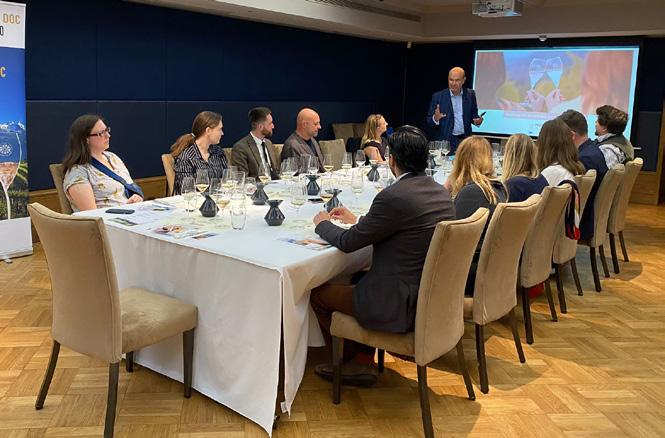
Viticoltori Ponte Presidente Wines
Prosecco DOC Treviso Extra Dry
RRP £12
“This is often a wine I’ll feature at the front of a tasting because it is the ideal aperitif,” says Phillips. “It gives you a jolt in the nicest possible way.
“The minimum time on the lees is 30 days for Martinotti method and this has had 40 days.”
Andrew Gray picks out flavours of marshmallow, red apple, apricot and red pepper. It’s fresh with a long finish: a perfect wine to offer as a welcome drink, we agree.
Piera 1899 Wine Importers (Edinburgh) and WinesnVines
Prosecco DOC Bio Brut Pura Terra (Pordenone, Friuli-Venezia-Giulia)
RRP £15-£17
“This is a family business and Piera Martellozzo has been in charge there for 25 years,” says Phillips. “This 100% Glera has had three-four months on the lees and I want to show you a contrast, and demonstrate how broad and complex this category can be. Sometimes we just say, ‘it’s Prosecco’, but there’s so much more going on.”
We love the fruitiness of this truly gastronomic wine.
Perlage Winery Vinceremos
Prosecco DOC Rosé Bio Millesimato 2023 Extra Dry Afra (Treviso)
RRP £14-£15
“This family business has been organic since 1985, which is groundbreaking,” says Phillips.
The salty edge, combined with the raspberry notes, put us in mind of a charcuterie pairing. Jamie Mansfield from Poco in East Sussex says: “We have a pistachio cake on our menu and it would go very well with that.”
Torresella Alivini
Prosecco DOC Extra Dry (Treviso) RRP £15-£17
Admired for its presentation as well as its flavour credentials, this is a good example of a DOC Prosecco which can be serious and playful at the same time. It’s fresh and fruity, with notes of white flowers, orchard fruit and citrus, and wonderfully versatile with food.
Villa Sandi Annessa Imports
Prosecco DOC Rosé Millesimato 2023 Brut Il Fresco (Treviso) RRP £15-£17

“I wanted to show this with food because it’s stunning and complex,” says Phillips. “If you can, imagine it with a prawn risotto – absolutely fantastic.”
Our mushroom and summer truffle canapé helps to highlight the aromatics of this rosé, as well as a few spicy notes dancing in the background.
Diotisalvi Seeking UK distribution
Prosecco DOC Treviso Bio Brut Penombra RRP £15-£16
“They don’t have an importer so they would be a classic example for someone who might just want to do a pallet,” says Phillips. “It’s a biodynamic producer based up in the DOCG. They have 90 hectares and they grow a lot of other quite funky stuff.”
The wine is warm and autumnal with notes of honeysuckle and a creamy finish.
Ruggeri Enotria&Coe
Prosecco DOC Treviso Brut Argeo RRP £15-£16
“The Bisol family have been working with Enotria for 30 years. I love that they have that long-standing relationship,” says Phillips. “They have always used indigenous grapes as part of the blend. They really want to capture the freshness with this wine, so they’re not going beyond the 30 days’ fermentation.”
The wine is very well-balanced with some nice creaminess on the end. A fantastic match with the salmon and, as Phillips says, “punchy on the palate”.
Tasted with a selection of canapés from 67 Pall Mall
Bosco Viticultori Seeking UK distribution
Prosecco DOC Extra Dry Bosco dei Cirmioli (Treviso) RRP £15-£16
Another bottle with the kind of stylish looks that might tempt consumers to upgrade their usual Prosecco spend. The vineyards are between the Treviso hills and the Adriatic; the wines are fresh and zesty, and a great match for local cheeses.
Col De Mar Mondial Wines
Prosecco DOC Rosé Millesimato 2023 Brut (Veneto) RRP £16-£19
The merchants declared this to be a “perfect” rosé. “The most perfumed of all the rosés today; I can really taste the red cherries,” says one guest. “Beautiful.”
Fantinel Matthew Clark
Prosecco DOC Millesimato 2023 Brut One & Only (Pordenone, Friuli-Venezia Giulia) RRP £15-£18
“This is a single-vineyard Prosecco from a family business,” says Phillips. “Out of all the wines today this one has probably had the most lees contact, with 120 days, so with the weight and acidity it stands up to the mini-burger and charcuterie.”
In addition to the masterclass there was a free-pour tasting featuring other wines from the producers listed above, as well as from Millage and Villa degli Olmi.
Millage Beverage Boys
Prosecco DOC Treviso Brut RRP £13-£14
Part of La Marca co-operative, a family of over 5,000 vinegrowers, Millage has made a crisp, delicate wine, perfect as an aperitif and great for mixing in cocktails such as a Negroni Sbagliato.
Villa degli Olmi Seeking UK distribution
Prosecco DOC Rosé Millesimato 2023 Extra Dry Corte dei Rovi (Vicenza) RRP £15-£16
From a family-owned winery in the hills of the Vicenza region, this rosé is bright with savoury notes, and presented in a custom designed bottle.

There are many reasons why the Bollinger-owned crémant producer is so widely admired.
Extended lees ageing, separate vinification of its parcels and respect for the Loire valley ecosystem are part of the story – as is a specialism in Chenin
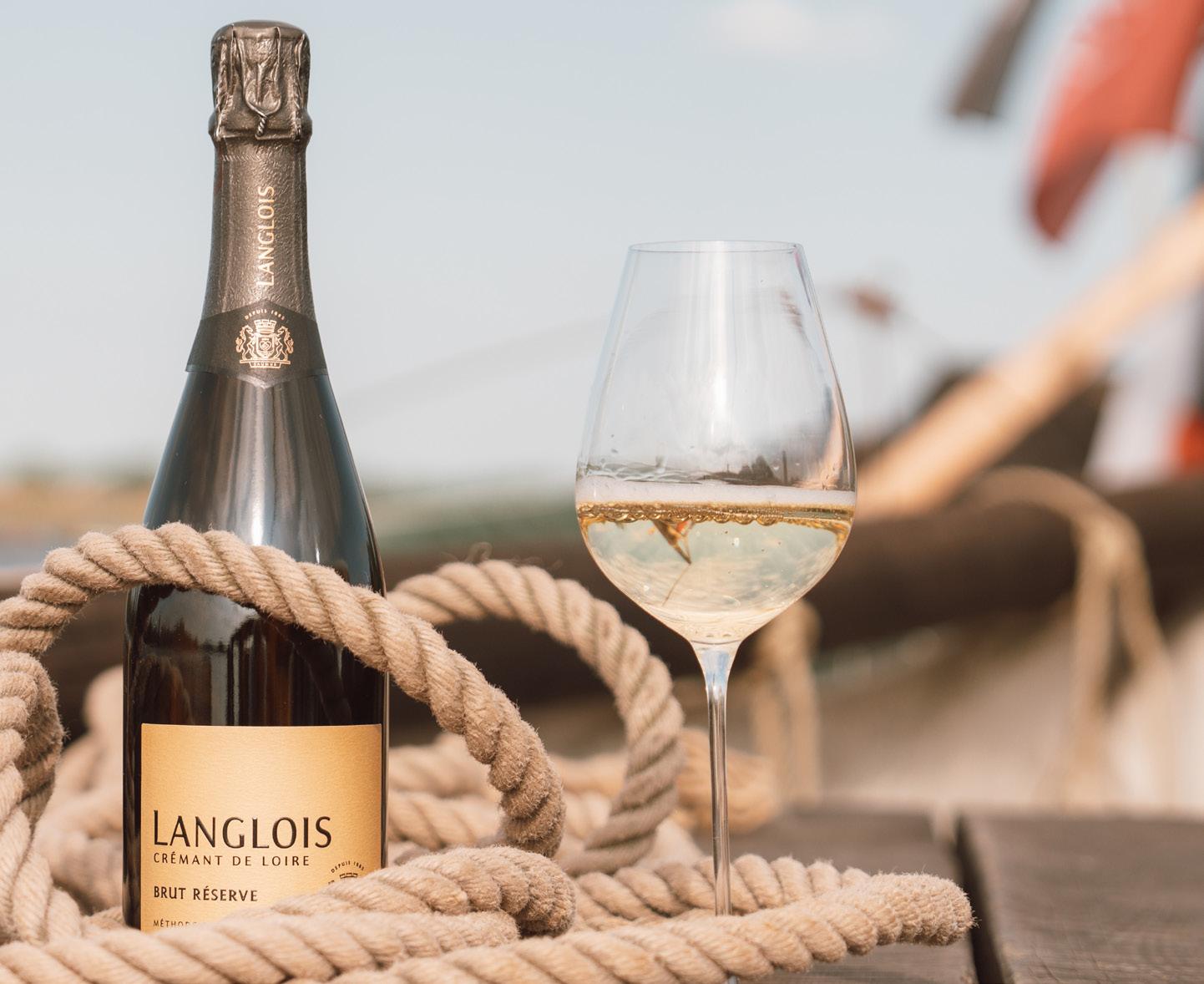
What would a crémant made by Bollinger taste like? In a sense, we already know, because the Champagne house has been the owner of Langlois, in the Loire valley, since 1973.
But even though there are some similarities in the production process – the most notable being secondary fermentation in the bottle – crémant is not Champagne, and at Langlois the aim has never been to mimic the style. These are wines that reflect the terroir of the Loire, and whose personality owes much to a grape you would never find in any wine from Reims or Epernay: Chenin.

“Crémant de Loire is mainly made with Chenin,” says Langlois sales director Laurent Onillon. “Chenin is an intense grape with honey and mineral notes which is quite different from Chardonnay. It is becoming more and more popular.”
It’s compulsory for the grapes to be hand-picked. The whole bunches are lightly pressed – the aim being to preserve the natural freshness of the fruit – and fermented with neutral yeast. As Onillon says, Chenin may have intensity, but it’s also a “very delicate and elegant grape”.
He adds: “There is no malolactic fermentation in order to keep the DNA of this amazing variety.
“Adding 12% of Chenin reserve wine is also unique, to bring more depth to our final blend. Chenin is the beating heart
of our Langlois Crémant: fine, delicate, elegant and deep.”
Langlois has a policy of separating the cuvée (juice from the first pressing) with the tailles (juice from the second and third pressing) and vinifying these separately. This allows winemakers to fine-tune the final blend, marrying together wines with varying degrees of weight.
Langlois also blends together wines from its various parcels across its 62 hectares of vineyards in and around Saumur. There are six distinct soil types, based mainly on tuffeau, which is considered ideal for sparkling wine production.
“To separate each terroir during the vinification allows us to achieve optimal aromatic development for each juice,” explains Onillon. “Consistency and exacting requirements during the vinification process are the only way to strive for perfection. Each terroir that is vinified separately, and each cuvée and tailles, will bring their touch to the final blend. That is one of the Langlois secrets.”
Every wine in the range is aged for at least two years on the lees, double what the crémant regulations require (rosé is the exception, ageing for 18 months). “This extended time on the lees is just perfect to get very fine and delicate bubbles, but also buttery and honey flavours,” says Onillon. The wines are given three months’ rest after disgorgement.
Langlois was one of the first producers in France to receive sustainability certification, and has adhered to the Terra Vitis specifications since 2000. Since 2020 it has converted 32 hectares of vineyard to certified organic agriculture, with the remaining 30 hectares in the process of conversion.
“Respect for the environment is certainly part of the Langlois philosophy,” says Onillon. “The vineyard is closely linked to the Loire river ecosystem. The least we can do is to respect and preserve it. This programme is not only for Langloisowned vineyards but also applies to all our partner wine growers.
“The main challenge is the humidity of the Loire region, which can easily result in problems such as mildew or other disease. Global warming should also be considered because summer can now be very hot and dry. We are in the process of undertaking some studies on new Chenin clones to try and combat these effects.”
It’s been a busy time for Langlois, which has this year unveiled a new brand identity. “It’s designed to embody the art of simplicity, and inspired by the natural muted green, yellow and gold hues of the banks of the Loire,” says Onillon.
“Next year, we will launch a totally new cuvée: Langlois Blanc de Blanc Vintage 2020, extra brut and certified organic. We are very excited as it will be our first organic crémant. That’s the start of a new era.”
Going forward, Langlois also hopes to invest more in hospitality. “We are already open to visitors seven days a week, but we want to create new experiences. We will offer, for example, a horse and carriage visit to the vineyard, or an overnight stay in a house in the middle of the vineyard.”
In the meantime, Onillon encourages independents to discover for themselves what makes Langlois so special and to share it with their customers. “Our best recommendation is to make sure you always have at least one bottle of Langlois crémant in your fridge,” he says. “You never know what might happen!”
Year after year, the Brut Réserve offers consistency and precision, with the Langlois signature freshness, elegance and complexity.
A pale gold with delicate, refined bubbles and pleasant aromas of white flowers and a subtle palate with an intense freshness.
LANGLOIS BRUT ROSÉ
Behind its luminous colour, the Brut Rosé reveals a radiant personality, driven by the freshness of the fruit.
A pale pink with subtle copper highlights, delicious hints of vine peach, and a lifted elegance.
Fresh, full-bodied and fruity on the palate, with a long finish.
LANGLOIS VINTAGE BRUT 2018
The Vintage cuvée stamps the Langlois style on each exceptional harvest. The Chenin reveals its elegance and freshness, highlighted by the structure of the Chardonnay and the vinosity of the Cabernet Franc. Pale yellow with golden highlights, with delicate aromas of white fruits and white flowers, with a hint of vanilla. Generous and full-bodied on the palate, with a long brioche finish.
LANGLOIS CADENCE EXTRA BRUT 2017
This house icon is precise, elegant and gastronomic.
A luminous golden colour with fine and harmonious bubbles, it has notes of hazelnut, dried fruit and brioche. A delicious, complex profile, where finesse and smoothness combine with a beautiful acidity, accentuated by hints of lemon and white fruits.
Feature produced in partnership with Mentzendorff. For more information visit mentzendorff.co.uk
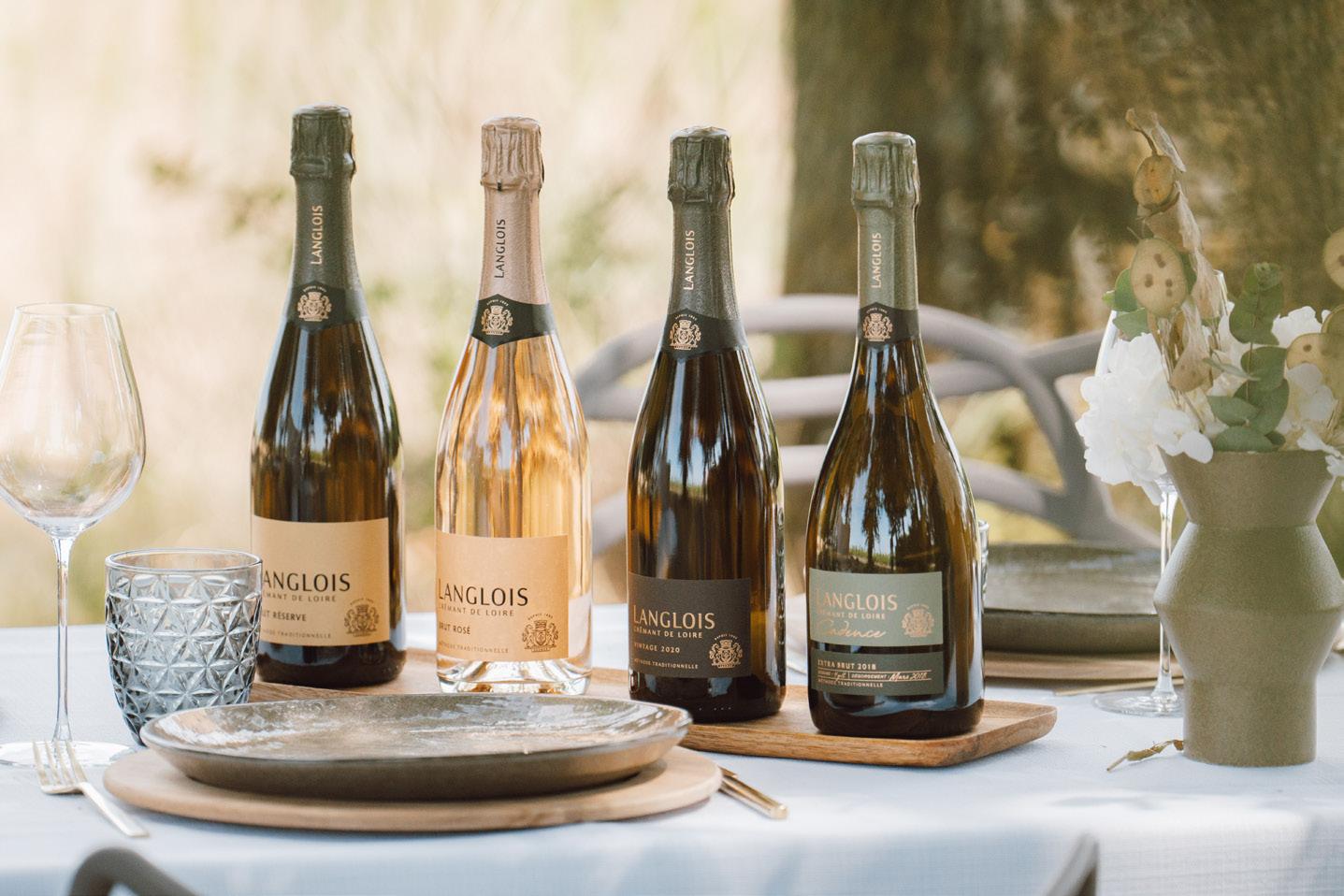
with the cost-of-living crisis still biting, it remains a price segment that independent merchants are taking seriously – and there is excellence to be unearthed
“Portugal, Italy and Spain offer great value for us under £15, with Alliance and Cachet offering particularly good ranges.
“Everyone still loves Sauvignon Blanc in this price bracket. But with my love of Italian whites, I try and get people to experiment with Vermentino and Grillo, for example, and we have various offerings of those wines under £15.
“This category is extremely important for us. We want to cater for people who are casual drinkers and don’t want to spend lots of money on wine. Our job is to get people to experiment. For example, one of our most popular wines in the fridge at the moment is a Chilean Viognier.
“It is quite a seasonal price sector for us. In the run-up to Christmas, we are comfortably selling much more in the higher price ranges – but in the new year our focus will shift back to wines under £15.”

A high quality French sparkling wine from Maison Patriarche. Made from Cinsault, Syrah and Grenache grapes, with charmat-method production and short ageing on the lees, the wine retains good acidity and freshness.
A persistent mousse is followed by fine bubbles, red fruit and citrus aromas and a well-balanced palate.
Castelnau Wine Agencies
RRP £11.99

Elgin, South Africa
The Oak Valley Estate has been in the Rawbone-Viljoen family since December 1898. Vines are grown alongside apples and pear orchards on textured gravely soil, on the foothills of the Groenlandberg. Elgin’s cool climate results in zesty, tropical fruit; kiwi, blackcurrant, melon and some pineapple on the nose, and plenty of passion fruit on the palate, with gooseberry and grapefruit on the finish.
North Canterbury, New Zealand
This North Canterbury wine was recently awarded 16.5/20 by Jancis Robinson: “Fragrant nose, and even more intense palate. Plenty of white peach and white pepper, the sweetness is beautifully integrated, bringing roundness. The bright acidity will enable it to keep developing its spicy character.”
Tiki is committed to sustainable winegrowing and working with the environment without compromising quality, under the guiding Maori principles of guardianship, protection and preservation.
Castelnau Wine Agencies
RRP £11.99

Colchagua Valley, Chile
Castelnau Wine Agencies
RRP £13.99

The vines grow on north west facing hills in the Colchagua Valley. The soils are granitic with a presence of red clay on the surface. The wine has a light red colour with a ruby hue. Intense red fruit on the nose, such as sour cherries and raspberries, melded with lighter notes of toast and spices. The palate is fresh with a long finish.
Swartland, South Africa
Pronounced “Zenna” and made with oldvine fruit from the Paardeberg mountain, grown on granite soil. Crisp, fresh and fruity, this wine has a good spectrum of fruit aromas and minerality; a lively, lingering palate.
castelnau Wine agencies
RRP £12.99

Castelnau Wine Agencies
RRP £12.49

California, USA
Founded in 2005 with the mission to create high quality, affordable wines that honour the iconic label artwork by empowering and inspiring women.
Aromas of blackberry and raspberry are accompanied by notes of vanilla. Rich and expressive, this is a food-friendly Cabernet Sauvignon with flavours of juicy plum, black cherry and strawberry, along with a hint of sweet baking spices.
castelnau Wine agencies
RRP £14.99

Coquille de Mer Vermentino
Languedoc-Roussillon (Vegetarian & Vegan)
One of our best-selling wines, which seems unbelievable for a southern French Vermentino, but once you smell and taste it, and see that it makes good margin on the shelf at around a tenner, you’ll see why! Zingy, zesty and fresh with a beautiful balance of fruit and acidity, this is a musttry.
Picked in the cool of the dawn and early evening, the Vermentino grapes are sorted, and then pressed before cool fermentation.
cachet wine
RRP £9.99

Languedoc-Roussillon (Vegetarian & Vegan)
The grapes are destemmed, crushed and sent to maceration for about 10 weeks. This long process is ideal to extract the fruity character of the variety. Daily tastings in the cellar ensure a nice structure with supple tannins.
Dark purple/red in the glass, with blackcurrant and green pepper aromas. Soft, fruity and mediumbodied on the palate with a spicy finish.
Languedoc-Roussillon (Vegetarian & Vegan)
A 30-hectare estate just over a mile from the Étang de Thau lagoon near Sète, the vineyards benefit from a Mediterranean climate tempered by maritime influences.
A blend of 80% Vermentino and 20% Roussanne aged on fine lees for seven months with regular stirring to enhance structure and aromas. Lime fruit aromas, tropical fruit flavours, herbal notes and a stony mineral finish. The refreshing acidity is balanced by a lush and creamy texture.
cachet wine
RRP £12.49

Languedoc-Roussillon (Vegetarian & Vegan)
Inspired by a field of Belted Galloway cows, our sales director David bumped into on a morning run, the Big Beltie has become a firm favourite with staff and customers alike!
Languedoc-Roussillon (Vegetarian & Vegan)
A blend of Grenache Blanc, Viognier and Muscat. Night-picked to reduce the risk of oxidation, there are just five days of skin contact which delivers a fresh and vivid wine, well balanced with good acidity. Aged on fine lees until bottling.
Intense aromas of bitter oranges, dried flowers and slight nutty hints. On the palate, orange blossom and grapefruit with a long, intense and complex finish.
cachet wine
RRP £10.99

Around one third of the wine is aged with half-toasted French oak which adds complexity to the wine. Rich, ripe, blackcurrant and cassis fruit, with smoky and peppery hints. Ripe tannins and a savoury coffee note with a delicate hint of oak.
cachet wine RRP £10.99

cachet wine
RRP £11.99

Languedoc-Roussillon (Vegetarian & Vegan)
Marselan was created in 1961 by Paul Truel, a leading ampleographer. He’s described as a man of rigour, an insatiable researcher and untiring worker, endowed with a breathtaking memory.
The idea of him working away in the lab, combined with the test tubes, flasks and pipettes often seen at wineries, gave us the idea of Le Professeur. An artist based in Carcassonne, Sylvain Rouaud, created the label as a tribute to Paul Truel.
cachet wine RRP £10.49

Respecting the winegrowing tradition of the world’s oldest demarcated region, the Assobio wines are made from the region’s indigenous varieties – Touriga Nacional, Touriga Franca and Tinta Roriz – Douro staples. Here, 10% of the blend is aged in French oak barrels for six months, delivering a lovely concentration of lively redberry fruits balanced with a freshness and elegance on the finish. Versatile and gastronomic, Assobio Red expresses the Douro’s freshest side.

Los Olivos chardonnay
hatch mansfield
RRP £14.00

Aconcagua Region, Chile
From the Viñedos Familia Chadwick stable, producers of some of Chile’s most highly respected and awarded wines, Viña Caliterra is located in the heart of the Colchagua Valley, but the Sauvignon Blanc is sourced from familyowned vineyards in both the Casablanca Valley and Aconcagua Costa. The resulting wine has intensely aromatic notes of grapefruit, lime and with soft mineral notes and a lovely citrus finish.
Crafted by the amazingly talented Sebastián Zuccardi, Los Olivos Malbec perfectly demonstrates his winemaking abilities, especially with Malbec. His aim is always to create wines of great purity which express their origin, the essence of their soils and the extreme climate of the vineyards. Elegant notes of plum, blackberry and white pepper are wrapped up with a brilliantly structured finish. Winner of the Best Value Red Wine in The Wine Merchant Top 100 2023.
Hatch mansfield
RRP £13.80

Coastal Region, South Africa
hatch mansfield
RRP £12.70

Winemaking has taken place on the Kleine Zalze Estate, just outside Stellenbosch, since 1695. The philosophy of RJ Botha and his winemaking team is simple: success begins in the vineyards. This continuous attention to detail has resulted in numerous accolades and awards from across the globe for their portfolio of wines, especially their Cabernet Sauvignons, including this classic example brimming with spice, blackcurrant, and chocolate flavours.
The Los Olivos range was created in honour of the olive tree, as much a part of the Zuccardi family as the vines themselves. The wines are the perfect introduction to the style of the Uco Valley, showcasing its wonderful minerality and freshness. This Chardonnay has pineapple, fresh peach and citrus notes which shine through, resulting in a great all-rounder. Ripe, mouth-filling and immensely enjoyable.
hatch mansfield
RRP £13.40

hatch mansfield
RRP £13.80

Marlborough, New Zealand
Part of Esk Valley’s Estate range, these are wines that receive the care and attention normally lavished on reserve wines. The result is a range of elegant, intensely flavoured wines.
Powerfully intense and pungently aromatic, this is Marlborough in a glass. Using grapes from carefully selected vineyard sites, Esk Valley puts its own unique stamp on New Zealand’s signature calling card. The 2022 won the coveted Great Value White Wine trophy at the recent IWC Awards.
hatch mansfield
RRP £14.99

Mendoza, Argentina
Brothers Francisco and Eduardo Rodriguez are the third generation to own and manage the Corbeau winery.
Made in eastern Mendoza, this Malbec is deep and expressive; aromas of ripe blackcurrant, violet and vanilla – spending three months in American oak and a further six months in bottle before release. Vegan friendly.
Mendoza, Argentina
Barton Brownsdon & Sadler
RRP £14.99


After a chance discovery of a small parcel of Ancellotta vines growing in the middle of a Malbec vineyard and liking the results after vinification, the Rodriguez family have now planted 100 hectares. Ancellotta adds complexity and balance to the blend.
Notes of cranberry and raspberries are backed up with vanilla spice and velvety tannins. Vegan friendly.
Barton Brownsdon & Sadler
RRP £15.00

“France and Spain offer great value for us under £15. Thorman Hunt are particularly good in France, as well as Richmond Wine Agencies, who consistently have good wines across the board at that price.
“My personal favourites are usually from the south of France, southern Rhône, into the Languedoc-Roussillon and even south west France too.
“The duty increases have raised our entry level significantly. For us, £15 is the new £9.99, really. Anything we find at these price points is really welcomed. Putting in more wines under £15 has been our main goal over the past nine months.
“A way we get people to move up the price ladder from £15 is by explaining to them that by eating and entertaining at home they can save the costs of restaurant mark-ups on wine and buy something much nicer here for around £30, for example.”
Rising River Chenin Blanc 2023
Franschhoek, South Africa
Inspired by the Franschhoek River that flows through the valley in South Africa’s Western Cape, this Chenin Blanc is made by leading Franschhoek winery Rickety Bridge.
Classic white peach and pineapple with a lush palate of nectarine and melon. Fresh, balanced, easy drinking. Sunshine in a glass! Vegan friendly.
barton brownsdon & sadler
RRP £11.00

Castelnau Wine Agencies castelnau.co.uk o20 7751 2490
cachet wine cachetwine.co.uk
01482 638877
Hatch mansfield hatchmansfield.com
01344 871800
barton brownsdon & Sadler bbswine.com o1403 710100
awin barratt siegel wine agencies abs.wine 01306 631155
Pfalz, Germany
A fine Pinot Noir full of charm, characterised by the mild climate and the warm mineral soils of the Pfalz.
A long ageing, partly in small oak barrels, gives it typical Burgundian elegance and silkiness. Mediumbodied with bright, juicy black-cherry fruit, a spicy mid-palate with a lingering finish. An excellent approachable red wine for everyday drinking. Suitable for vegans.
Awin barratt siegel wine agencies
RRP £14.40

Corryton Burge SA Shiraz 2022
South Australia
Deep ruby red with purple hues, and strawberry, raspberry and vanilla aromas. Rich fruit-forward characters of raspberry and plums tantalise the palate.
There is a soft toasty oak influence that enhances the vanilla and spice. Subtle tannins leave the palate quite moreish and a delight to keep coming back to.
Awin barratt siegel wine agencies
RRP £14.35

This dry Riesling from Dr Loosen embodies the elegant and racy aspects of Mosel Riesling. The wine is made in a refreshingly dry style that finds balance in its steely mineral edge so typical of the region. The grapes for this wine come exclusively from vineyards planted on the steep slopes of the Mosel.
Delicious served with poultry, fresh fish, sushi or ceviche and dishes with a white cream sauce. Suitable for vegans.
awin barratt siegel wine agencies
RRP £14.40

Burge
South Australia
A velvety, robust and fruit-driven Cabernet Sauvignon. Deep crimson red with ruby red hues, black cherry, liquorice and leather aromas.
The cherry notes carry through to the palate along with hints of spice and dark chocolate. The tannins are soft and velvety. Suitable for vegetarians
Awin barratt siegel wine agencies
RRP £14.35
Corryton Burge SA Chardonnay 2023
South Australia
A lively, rich, round and creamy South Australian Chardonnay. Pale to yellow straw. Aromatic white nectarine, with hints of peach and pear. The palate provides generous fresh stone fruit and honeydew melon with a hint of creamy shortbread richness, all brought together with moderate acidity to provide balance. Suitable for vegetarians.
awin barratt siegel wine agencies
RRP £14.35


Grown on alluvial soils at an altitude of around 450m-490m in the heartland of Rioja Alta. It displays aromas of red fruits with hints of liquorice, mixed with the essence of the Urunela soils, highlighting its spicy potential as it matures in the cellar. Elegant and nuanced.
Delicious when paired with sausage, white meats, or fish – and the absolute match for mushroom dishes.
Awin barratt siegel wine agencies
RRP £14.45


for what was once my favourite wine, the Montes Alpha Cabernet Sauvignon from Colchagua Valley in Chile.

Blackcurrants,
One of the great things about wine is the way it can transport you back to the past.
I had this experience recently when a friend and I shared a bottle of Bodegas Zugober’s Belezos Rioja Gran Reserva 2013. We pulled the cork on it, poured out a couple of glasses and had a sniff. It was such a pleasure that I almost started laughing – and it was supposedly a mediocre vintage.
It took me back almost three decades to my teenage years in the south of England. At the time I was a smoker – a minor act of rebellion, against nobody in particular –and I had a penchant for a brand of French cigarettes called Gitanes. The packaging was of unmatched brilliance, a long white box with a wispy image of a woman shrouded by smoke on the blue sleeve.
I asked my drinking partner, who had never indulged in the joy of smoking, if he
green pepper ... but what else?
detected the whiff of tobacco on the nose. My question was met with a rueful shake of the head. But to me it was overpowering. It was so good that I almost went for a walk around Edinburgh in search of this majestic French product, and I don’t even smoke anymore. I consoled myself by smelling a cigar for a couple of hours.
Sometime later, in a cupboard, I came across my old Little Black Journal of Wine, which many years ago travelled to the other side of the world with me. I would scrawl tasting notes in here while a student. I quickly tracked down the entry
I would drink Montes Alpha out of a plastic mug in my minuscule appartment, and it tasted fabulous
I used to buy this wine frequently from my local supermarket in Tokyo, whose buyer clearly had impeccable taste. There was a specialist wine shop over the level crossing, but I was deterred by the fact that every single bottle came in cellophane wrap, gifting being a big thing in Japan. Also, they didn’t have the Montes Alpha. I would drink it out of a plastic mug in my minuscule apartment, and it tasted fabulous. (When I mentioned to a friend back home that I drank a Barbaresco from this cup, he was appalled.)
My tasting note was thorough, reflecting the fact that I was studying for the WSET Diploma in my spare time. It was also prosaic: blackcurrant, mint, coffee, chocolate, herbaceous (green pepper). I reckon I was stretching things with the coffee and chocolate, and I was definitely way off when I wrote that there was high acidity, but I was pleased to see I hadn’t felt the urge to employ the dreaded term “complex”.
I remember feeling that I hadn’t quite done the wine justice, though, except by drinking a lot of it. There was another flavour, which I just couldn’t put my finger on. It would take another five years or so before I finally worked out what it was.
One spring afternoon my wife and I drove into the Scottish borders to Abbotsford House, which was once the home of the legendary Scottish writer Sir Walter Scott. In the period since our previous visit, a café had been constructed. We sat upstairs and ordered a slice of blueberry cheesecake. I felt a little thrill as I tasted it, for it transported me back to that tiny flat down a narrow alley in Japan. This was the missing flavour. Blueberry cheesecake!
I’ve had many bottles of the Montes Alpha Cabernet since returning to the UK, but none have quite seemed to match the one I had in Tokyo, which was the 2013 vintage. Maybe it was a great year after all.
Michael Walker is part of the team at Vino in Edinburgh
With November being branded, amongst other, worthier causes, Flipfebruary –where we are encouraged to dwell in the couldhavebeens and send them cinnamon bun or peanut butter flavour coated pretzels – let me tell you about some of my Shop Boyfriends, who for the sake of anonymity are all “imaginary”, and for the sake of this Amazing Lunchthemed column may or may not have been Lunched.
Big Jocky you’ve already met. He continues to clear the shelf of Furstenberg Frei and spends tender time, as a fellow traveller in his 40s, reminiscing about the good old days of HMV and Skullcandy headphones and how frustrating young people are. I have not had lunch with him, although he did offer to get me a Doner Pizza Crunch once.
Alan and Teddy continue to be the Han Solo and Chewbacca of GWR, although I don’t remember Han slipping quite so easily into conversations of fiscal conservatism or increasingly smug “told you so” gurning about the SNP. Still, I never liked Star Wars much anyway. Maybe I just wasn’t paying attention.
Alexi Dyson claims he is Hungarian. Or maybe that’s his beautiful well-behaved dog, who I encourage to misbehave when they roll up to Sunday (Best Day!) Club and we have to guess how many pints of Tennents down the human is. Alexi and I have shared a frisson since he once let slip I didn’t give him a job, once, and if I had, “who knows, we could be married by now”. Sliding doors.

Phoebe Weller of Valhalla’s Goat in Glasgow uncharacteristically reverts to the original purpose of her column, which was to provide actual lunch suggestions for fellow indies
your wide-legged patchwork jeans and your vintage gas-station shirts and your authentic baseball tops in an airy city centre location. The staff were all quiffy and eyelinery and cool, so cool.
Phlip worked in Flip, he let slip mid-quip (mine) as he perused the whiskies in our Special Time which is Five-to-Close. He is dreamy, and still cool, so cool. He’s a
physics teacher now, which is very much my type, and his quiff falls greyly and loosely over his “I’m not a Flipper’”s eye. I should clarify, that’s not a typo, it’s inverted commas plus a possessive – he may or may not buy whiskies to resell on auction sites. Normally we have no shrift for Five-to-Closers and even less for Flippers, but I have a Soft Spot for Phlip, so much so that I dedicate this Amazing Salad to him.
The Mexicana cheese is particularly close to my heart, given that it has a link with my greatest cheesecrush of all time. JM was the first man to mime flavour to me, and wasn’t afraid to liken an excellent morsel of Caerphilly to a can of cream of chicken soup. He expanded my taste horizons past words and into physical sensation. I was partnered with JM for the worst of all the cheese categories, Flavour Added Cheese. The judging sheet was filled with the note “nasty”, until we reached the orange wedge with rehydrated peppers and Mexican Style seasoning. “That,” said JM, “is less nasty than the other ones. And it has a narrative.” <3

The Gay Organist is very much my type. But he blanked me in the street the other day so I’m over him.
The real heartthrob for me is Phlip. Around the time I didn’t give the nonHungarian the job, there existed a cool shop called Flip where you could buy


You will need:
Mexicana cheese
Fresh corn
Those Salted Corn Bits (two for £1.50 at Morri’s)
Avocado
A bell pepper
A red onion
Coriander
Tomatoes
Lime
Method:
Chop into little bits. Combine, wettest to driest.
Happy Flipping!
WINE AGENCIES
28 Recreation Ground Road
Stamford Lincolnshire PE9 1EW 01780 755810
orders@abs.wine www.abs.wine

@ABSWines


hallgarten wines
Mulberry House Parkland Square 750 Capability Green Luton LU1 3LU 01582 722 538
sales@hnwines.co.uk www.hnwines.co.uk



@hnwines


Thurs. 16th January – 10:30 - 16:00
– ST. JAMES ROOM, 67 PALL MALL, LONDON, SW1Y 5ES
Join us in the return of the ABS Burgundy En-Primeur Tasting, with wines being presented by representatives from these wineries: Domaine Bader-Mimeur, Domaine D’Ardhuy, Domaine des Marrans, Domaine des Malandes, Maison Auvigue, and Richard Rottiers
For more information or to RSVP call 01306 631155 or e-mail lesley@abs.wine

12-14 Denman Street London W1D 7HJ
0207 409 7276 enquiries@louislatour.co.uk www.louislatour.co.uk

@louislatouruk


Established in 1797, Maison Louis Latour is the largest Grand Cru holder within Burgundy.
It has a long history of producing exceptional wines, particularly from the renowned vineyards of Corton-Charlemagne, using sustainable viticultural practices. The estate is recognised for its commitment to traditional winemaking techniques and its emphasis on terroir, which reflects the unique characteristics of the region.
With a Burgundian style for every occasion, seize the opportunity by taking advantage of the festive offers available on the Ardèche, Village, Premier and Grand Cru wines. For more information, please contact sales@louislatour.co.uk or scan the QR code.


mentzendorff
The Woolyard
52 Bermondsey Street
London SE1 3UD
020 7840 3600
info@mentzendorff.co.uk
www.mentzendorff.co.uk


buckingham schenk
Unit 5, The E Centre
Easthampstead Road
Bracknell RG12 1NF
01753 521336
info@buckingham-schenk.co.uk
www.buckingham-schenk.co.uk


@BuckSchenk
@buckinghamschenk



This year marks the Bicentenary of the House of Delamain, who have now been crafting exceptional cognacs for 200 years.
An icon of the style of the Maison is the groundbreaking, elegant, and light Delamain Pale & Dry XO, created in 1920.
Surely the purest expression of the noble terroir of Grande Champagne!
Forfurtherdetails,pleasecontactyourMentzendorff AccountManager

Celebrating the Exceptional Terroirs of Piedmont

Casali del Barone showcases classic and traditional styles of wine from the Piedmont area. The personality of the wines from this area is celebrated through Casali del Barone, beautifully expressing the Langhe, Piedmont, Barberesco and Barolo vineyards.
The result is a range of well-balanced, fruity wines that fly the flag for wines of the area.
With 7 wines available, including: Langhe Bianco DOC; Gavi DOCG; Piedmonte DOC Barbera; Barbera d’Asti DOCG; Langhe DOC Nebbiolo; Barbaresco DOCG & Barolo DOCG
BUY 11 CASES AND GET 1 FREE (VALID UNTIL 19TH DECEMBER)







4 Pratt Walk, Lambeth
London SE11 6AR
0207 735 6511
www.thormanhunt.co.uk

@thormanhunt
sales@thormanhunt.co.uk
Please RSVP: vanessa@thormanhunt.co.uk

walker & Wodehouse
109a Regents Park Road
London NW1 8UR
0207 449 1665
orders@walkerwodehousewines.com
www.walkerwodehousewines.com


@WalkerWodehouse


Estevez Bodegas y Vinedos joins Walker & Wodehouse portfolio
Artisanal Galician wine producer Estevez Bodegas y Vinedos has joined the Walker & Wodehouse portfolio. Five of its wines will now be available in the UK for the first time.
Known for producing exceptional Mencia and Godello, Estevez Bodegas y Vinedos is based in Bierzo in Galicia. Originally exiled to Mexico during the Spanish Civil War, the family returned to start the adventure of their family winery.
Now spread over 7 hectares of hillside planted vineyards, grapes are grown from an average of 90-year-old vines. Its single-vineyard Mencia perfectly exemplifies the diversity of Mencia and the terroir it’s grown on.
The wines now available are Versos de Valtuille Godello 2022, Versos de Valtuille Mencia 2022, Versos de Valtuille Rosado Mencia 2022, Versos de Valtuille Paraje el Rapolao 2021 and Versos de Valtuille Paraje La Vitoriana 2021.
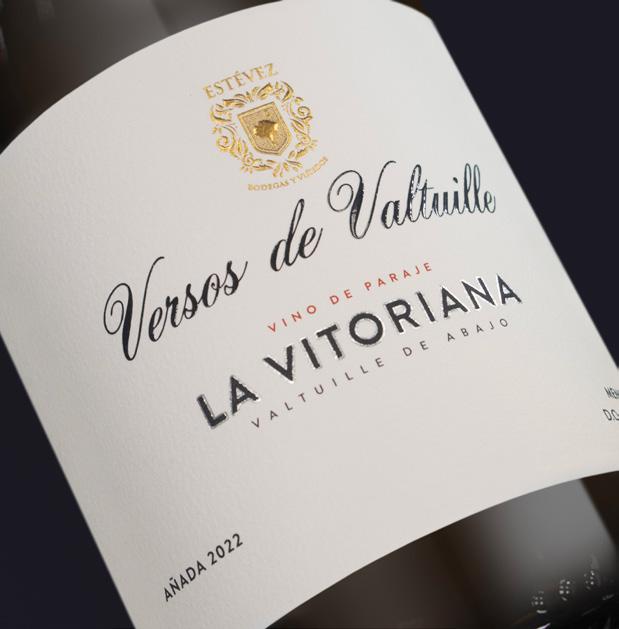
For more information, please contact your account manager
Fells House, Station Road
Kings Langley WD4 8LH
01442 870 900
For more details about these wines and other wines from our awardwinning portfolio from some of the world’s leading wine producing families contact:
info@fells.co.uk www.fells.co.uk

@FellsWine

je_fells

The Links, Popham Close
Hanworth
Middlesex TW13 6JE 020 8744 5550 orders@richmondwineagencies.com

@RichmondWineAG1

@richmondwineagencies
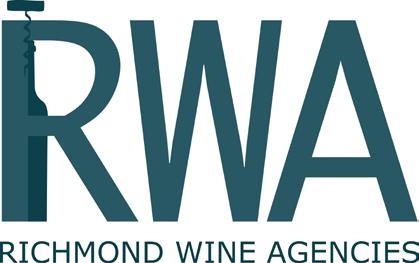


















It’s Tea. but not as you know it...









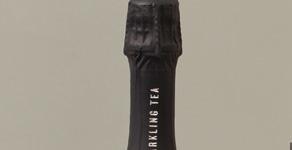

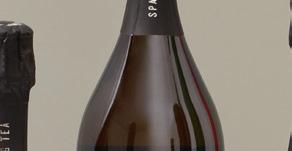
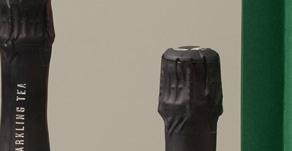









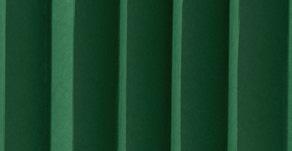



Available in both No (0%) and Low (5%) alcohol options, Copenhagen Sparkling Tea shares many of the characteristics of fine wine but is made by blending high quality single estate teas rather than grapes. It is rapidly developing a following here in the UK as well as worldwide where it is now sold in 50 countries and listed by more than 100 Michelin restaurants.


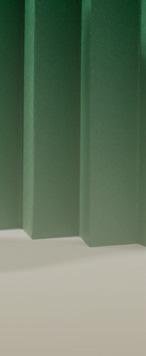

In Suvereto, in the heart of the Alta Maremma, in Tuscany, only 13 kilometres from the sea, Tenuta Casadei winery was founded, dedicated to respect biodiversity.
In this place Stefano Casadei and Fred Cline shared the idea of putting nature in the heart of their project, respecting and protecting an environment rich in biodiversity and planting international vines capable of expressing all the character of the varieties. All the wines represent the terroir and are certified organic and biodynamic (Demeter).
If you wish to order any or would like further information please do get in touch.
Tenuta Casadei Cabernet Franc Filare 18 Organic 2019 RRP £46.95
Tenuta Casadei Viognier Filare 23 Biodynamic 2021
RRP £39.95


The Old Pigsty, Rose Cottage Church Hanborough OX29 8AA 01993 886644
orders@delibo.co.uk www.delibo.co.uk

The 2019 Bastion de Camerac Cuvée Tradition is your Christmas Claret which delivers outstanding value from a great vintage.
This third-generation vigneron indépendant in Entre-Deux-Mers has lovingly blended his HVE-certified grapes for 12 months in stainless steel to retain the purity of the fruit for your customers to enjoy this Christmas and future seasons!
Email orders@delibo.co.uk to benefit from our very limited early-bird offer. **
Order ANY 60 bottles of Bastion de Camerac wines (75cl or equivalent) at Delibo’s duty paid delivered 7-dozen prices and enjoy 3 free magnums of the Cuvée Tradition as our present to you. Joyeux Noël!
** offer available to the first five orders received
The computer system for drinks trade wholesalers and importers 16 Station Road Chesham HP5 1DH
sales@vintner.co.uk www.vintner.co.uk





020 7720 5350
order@libertywines.co.uk www.libertywines.co.uk

@liberty_wines



top selection 23 Cellini Street London SW8 2LF
www.topselection.co.uk info@topselection.co.uk
Contact: Alastair Moss
Telephone: 020 3958 0744


@topselectionwines
@tswine

Founded in 2020, Great Heart Wines is 100% owned and run by the employees of the Mullineux and Leeu Passant wineries in Swartland and Franschhoek. This project is the vision of Andrea and Chris Mullineux, who are committed to sustainable and ethical farming to preserve the natural environment and well-being of their communities. From the vineyards to the winery and warehouse, the Great Heart team work as a collective and directly profit from the wine sales. Great Heart’s ethos of empowerment is evident in its logo and label design by South African fine artist Jaco Sieberhagen, inspired by the story of a compassionate Cape Wagtail’s selfless act of courage and great heart for others.
Under Chris and Andrea’s mentorship, Great Heart’s head winemaker Gynore Hendricks (a previous Cape Winemakers Guild Protégé) and her team follow sustainable viticultural practices and minimal intervention winemaking. Their single-vineyard wines have beautiful natural fruit intensity, complexity, and a true sense of place. Fermented and aged in 500-litre French oak barrels, the Stellenbosch Chardonnay is sourced from the cool, south-facing slopes of the Polkadraai Hills, where the site’s decomposed granite soils, southerly aspect and cooling maritime influence from False Bay produce a wine with vibrant texture and purity of fruit. The Stellenbosch Cabernet Sauvignon hails from the lower slopes of the Helderberg Mountain, one of the coolest viticultural areas in Stellenbosch. The result is concentrated yet perfumed, with aromas of graphite and blackcurrant.




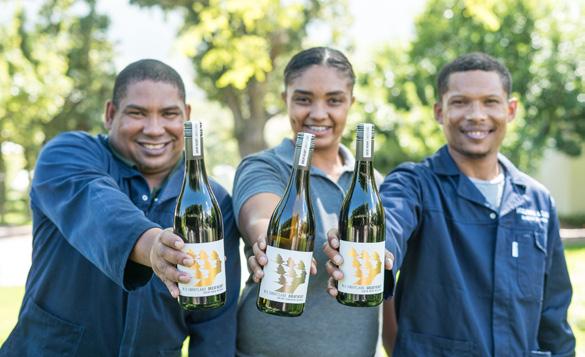









“Yorkshire farmers respond ‘how much?’ when presented with wines over £20”
Christine Austin has lived most of her life in her native Yorkshire, but it was while living in the south that she started her career in wine. Joining Marks & Spencer as a technologist, she ended up in the wine buying department. Several years later she left to raise a family and since then has written a weekly column for the Yorkshire Post.
What’s the first wine you remember drinking?
As a student, I worked in the restaurant of a 5-star hotel and in the winter season they had a programme of gastronomic weekends. We were allowed to taste the food before service, and occasionally allowed a small sip of the wines. I particularly remember a Hungarian Tokaji that went perfectly with a peach dessert. I nearly got the sack for having too many sips.
What job would you be doing if you weren’t in the wine trade?
I don’t know what aspect of travel I could do, but I just love the thought of introducing people to the wonders of getting out and enjoying the world. We are fortunate in the wine world that we visit so many beautiful places. My children now live overseas, so we travel to west Canada and Switzerland frequently.
How do you relax?
I love swimming. At my local pool I can gently swim up and down, and during that time I can work out all the things in my head that need thinking about. I also enjoy gardening: that is relaxing too. I enjoy propagating plants, particularly lavender.
The best book you’ve read recently?
At present I am ploughing through Mary Beard’s Emperor of Rome. It took a while to get into and I had forgotten the sequence of

emperors and who killed whom, but I am enjoying it now.
Give us a TV recommendation.
I enjoy Alice Roberts’ programmes that bring past civilisations to life. It is an easy way of enjoying history, without having to go on an archaeological dig.
Do you have any sporting loyalties?
Rowing. I have sat on the banks of rivers and lakes in many places around the world watching our daughter row. She represented Great Britain for a period, so I know more about rowing than most people need to.
Who’s your favourite music artist?
I find music is very much like wine, with different favourites depending on my mood and the occasion. Driving around locally I have Classic FM on the radio, but if I am on the M1 going to or from Yorkshire then I have to be able to sing to it. Queen, Springsteen, Adele, even Abba on occasions.
Any superstitions?
No! Superstitions are just a way of putting obstacles in the way of other people.
Who’s your favourite wine critic?
I find the best wine critics are the ones who shell out their own money to buy wine and give a very candid opinion of the quality of the liquid in their glass. I’ve given many tastings in front of Yorkshire farmers, who, despite having deep pockets and a fondness for wine, will often respond “how much?” with incredulity when presented with a wine that costs more than £20. I wish I could write with the perception and elegant style of Andrew Jefford.
What’s your most treasured possession?
A photograph of my mum who I never really got to know. If cancer treatment had been better when I was young, I might have had her around for longer.
What’s your proudest moment?
So many I can’t remember them all, but they all relate to my children and their achievements. Concerts, swimming galas, regattas, prize-giving and graduations are all in the mix. Now the next generation are on the scene, so the process starts again.
What’s your biggest regret?
There is no point in regrets. They just drain the emotions. Life is for living and for the future. And most regrets are balanced by the satisfaction of knowing that you did other things instead.
Who’s your hero?
Women through the ages, many of whom have overcome prejudice and pesterers to carve their way through life. Mary Seacole, Rosa Parks, Marie Curie, Ada Lovelace and Eleanor of Aquitaine spring to mind.
Any hidden talents?
I do a pretty mean child’s birthday cake. My kids would come up with some theme they thought would defeat me, and I would work all night, with mountains of butter cream to make a passable creation that impressed the kids who came to the party.
What’s your favourite place in the UK?
The North Yorkshire Moors around Levisham. There are some wonderful walks there, the wind clears your brain of anything that is worrying you, and there’s a fabulous pub for lunch.
If we could grant you one wish …
To live long enough to see my grandchildren (there are four of them now) grow up in a safe and peaceful world.
